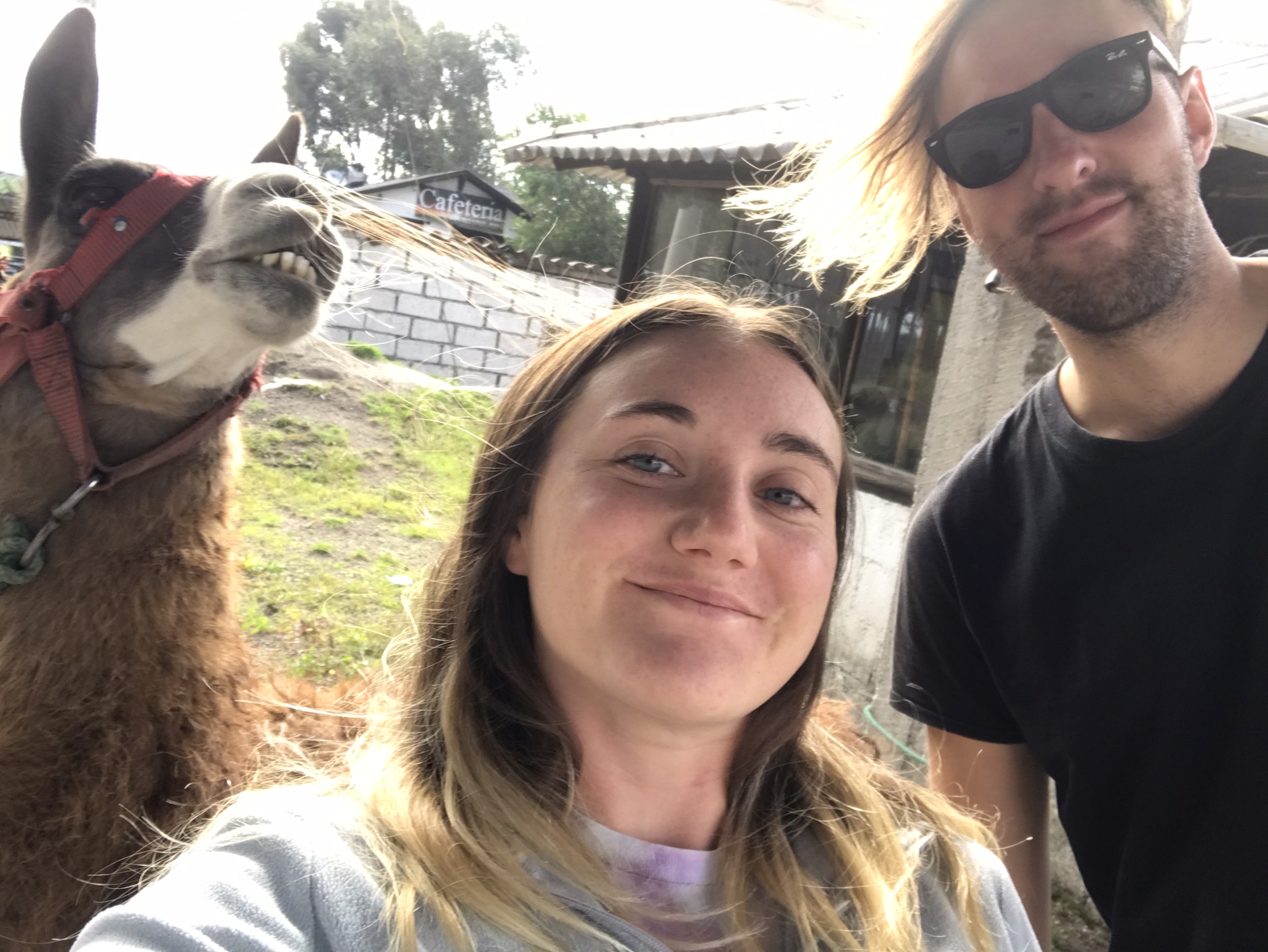Guatemala is arguably the most distinct country in Central America, retaining proportionally the largest indigenous population in the region by far. With a plethora of manmade and natural attractions, Guatemala draws plenty of foreign visitors to major tourist hubs like Antigua and Lake Atitlan but there are many great off the beaten track places too. Check out my Guatemala travel experiences below!
Flores, Lanquín, Quetzaltenango, San Pedro la Laguna, Antigua, Guatemala City
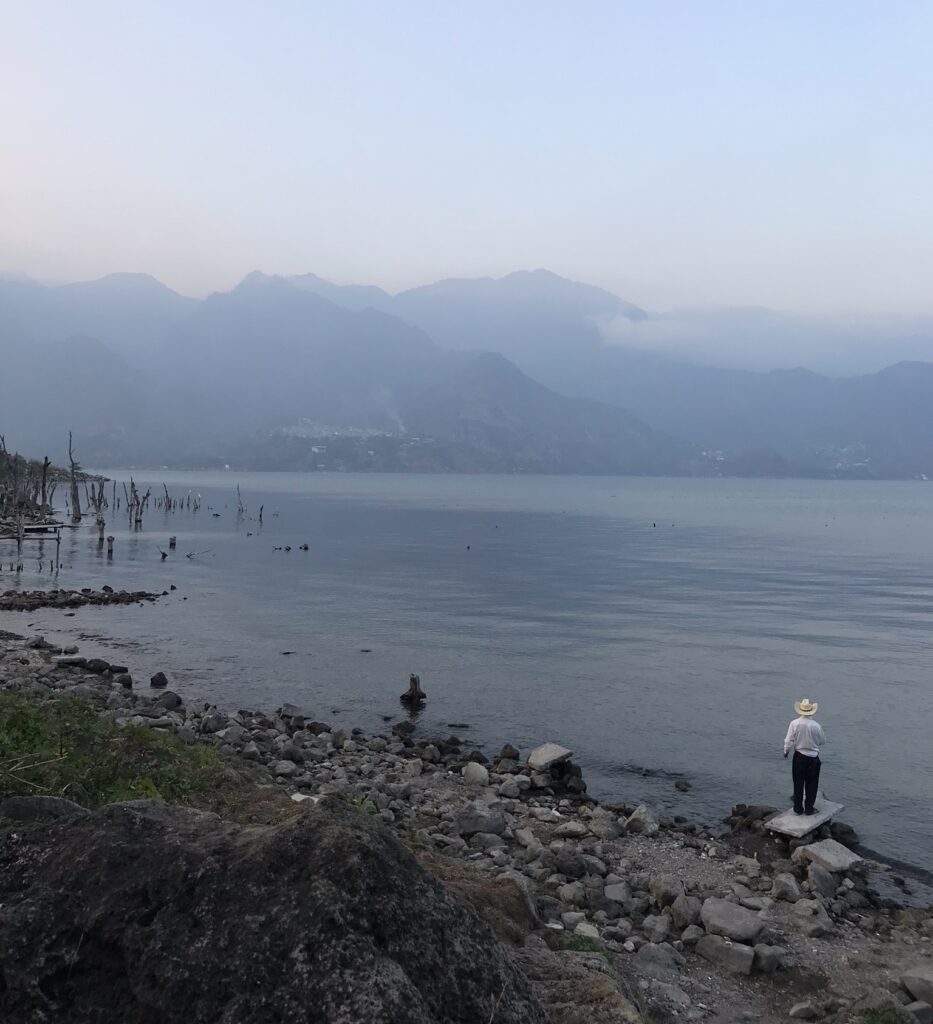
A mystical land of mountains and volcanoes, what most stood out about Guatemala for me was its strong indigenous Mayan influence. Flores was the last Mayan stronghold in the continent and a very strong indigenous presence is still visible in Guatemala, more so than anywhere else in Central America. Almost half the population of Guatemala is indigenous Mayan. Throughout the country women in traditional dress are highly visible on the streets, often carrying baskets of goods on their heads. Traditional markets are common, indigenous belief systems are practised and parts of the country feel like an image of what the whole region would’ve likely been if it wasn’t for the conquest of the Spanish.
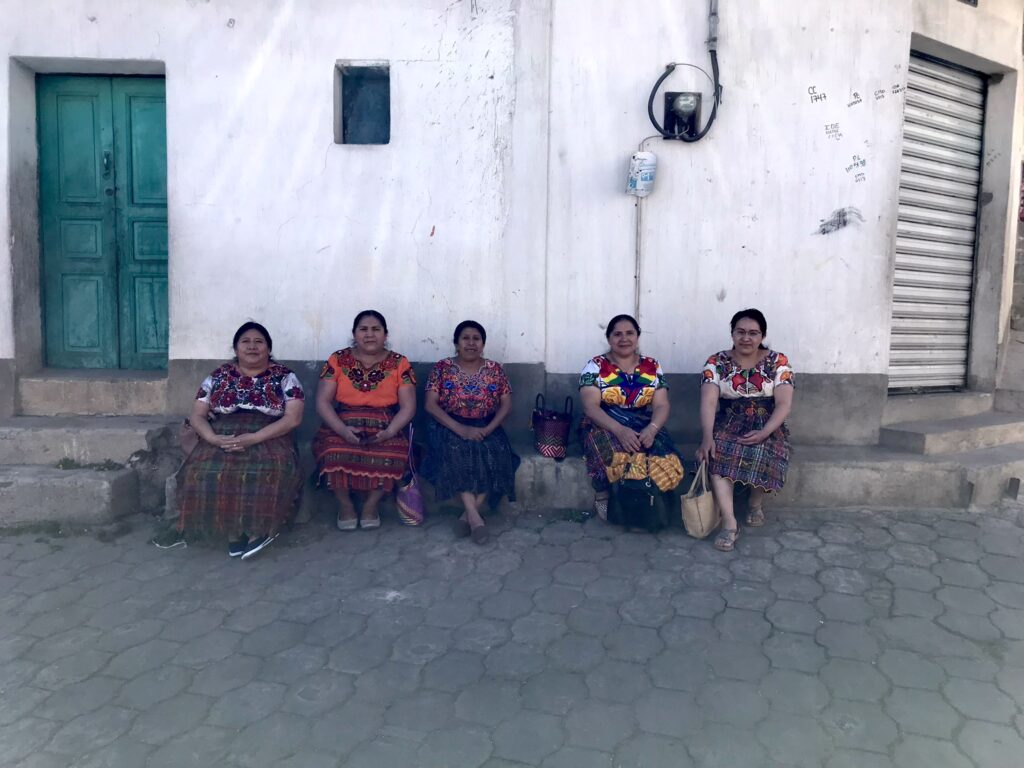
Bellas chicas in San Andrés Xecul
Much of Guatemala is rural and mountainous. The major cities in the south are mostly at altitude, giving a much cooler and more temperate climate compared to neighbouring El Salvador or the hot and humid areas to the northeast of the country. The mountain roads and lack of infrastructure mean that it is not always easy to get around the country and can often take a very long time to travel a relatively short distance. We also found that Guatemala was the most difficult country in Central America to get around by public transport. We ended up having to cop out and book an expensive tourist shuttle on more than one occasion due to a lack of feasible transport links. For more info on chicken buses in Guatemala, check out my blog post here!
After the conquest of the Spanish, Guatemala was the centre of the Captaincy General of Guatemala which governed the entirety of Central America as well as Chiapas state in Mexico. After the fall of the Spanish, Guatemala became the centre of the short-lived Federal Republic of Central America until the other Central American countries declared their independence. The quetzal is the national bird and currency of Guatemala, and is present on the nation’s flag.
We headed into Guatemala across the border from Belize, check out my border crossing guide here!
Flores
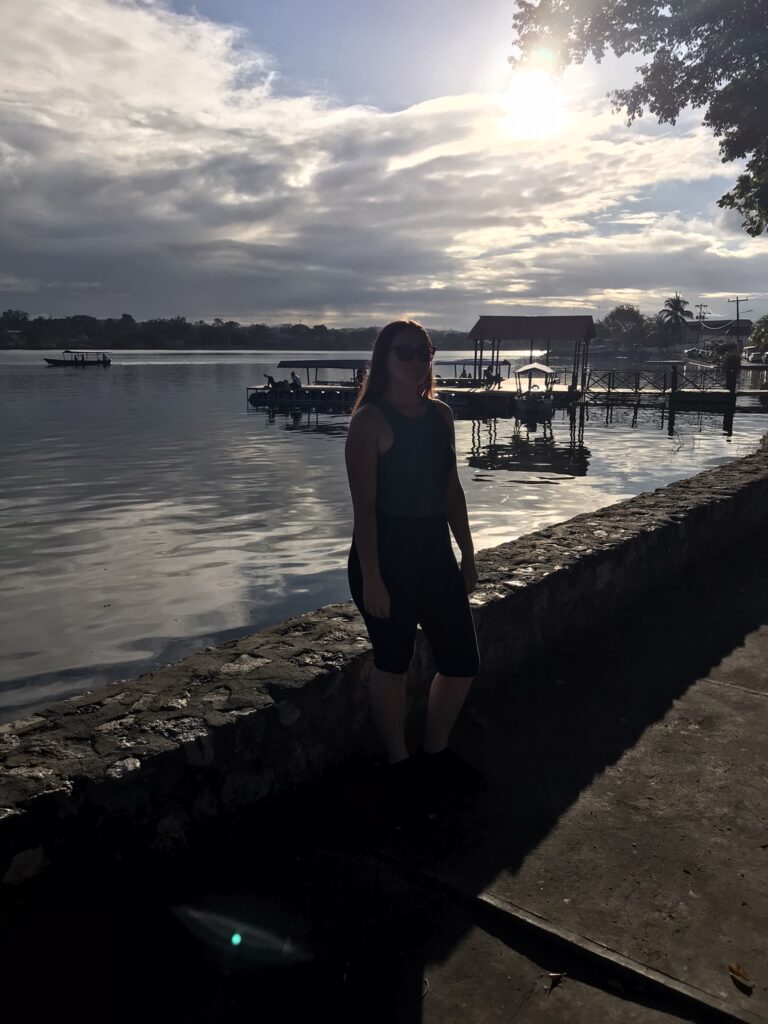
The island town of Flores is known to most visitors as a base for visiting the famous Mayan ruins of Tikal. Situated on an island in Lake Peten Itza, it is the main tourist hub of the wider Peten area, catering towards international backpackers with an abundance of hostels, trendy lakeside restaurants and ‘sky-bars’.
Flores is linked by bridge to the mainland settlement of Santa Elena. The two combine along with the nearby suburb of San Benito to form one large urban area. The whole settlement collectively is usually just known as Flores, however technically Flores is only actually the name of the island town.
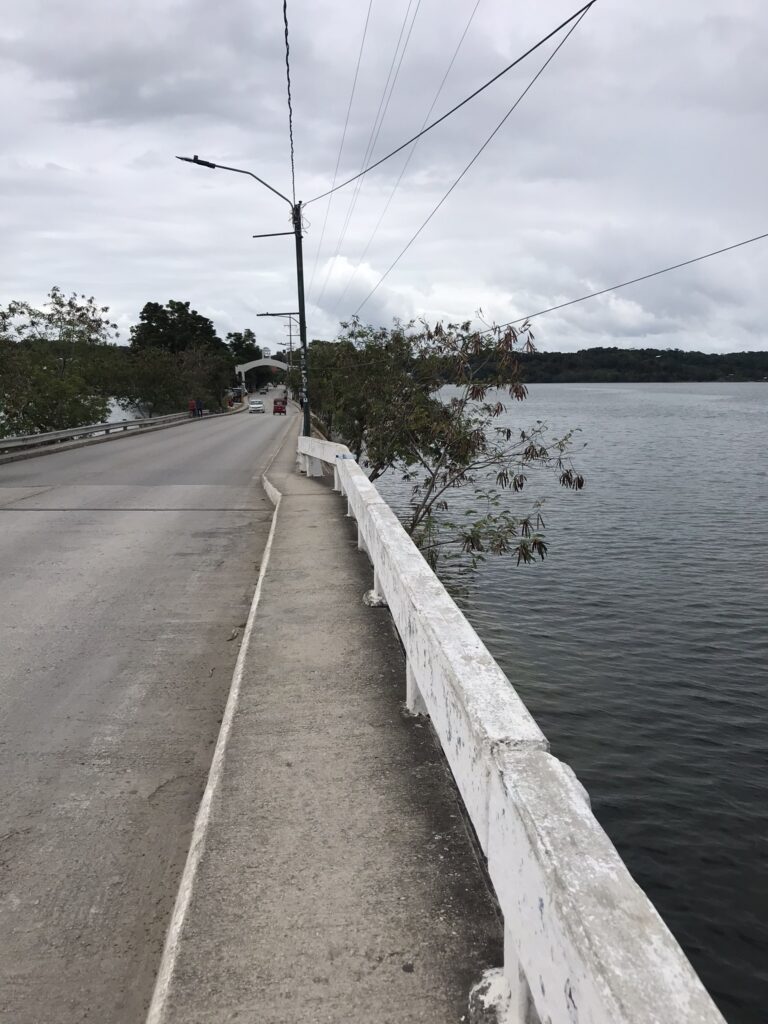
This bridge connects Flores island to the mainland
While most people use Flores as a base for visiting Tikal, there are activities and things to do on the island too such as kayaking and boat trips. With its cobbled streets and colourful houses, Flores is also a pleasant place just to wander around and explore in its own right. It is possible to walk around the whole island in less than an hour, during which we saw plenty of people lazing around, sunbathing and making the most of their time there.
The lush green shoreline opposite Santa Elena is dotted with small settlements and lodges and seems well set up for tourism. There is a ferry terminal on the island offering access to the far shore and other parts of the lake, however we didn’t use it and so don’t know exactly where it goes!
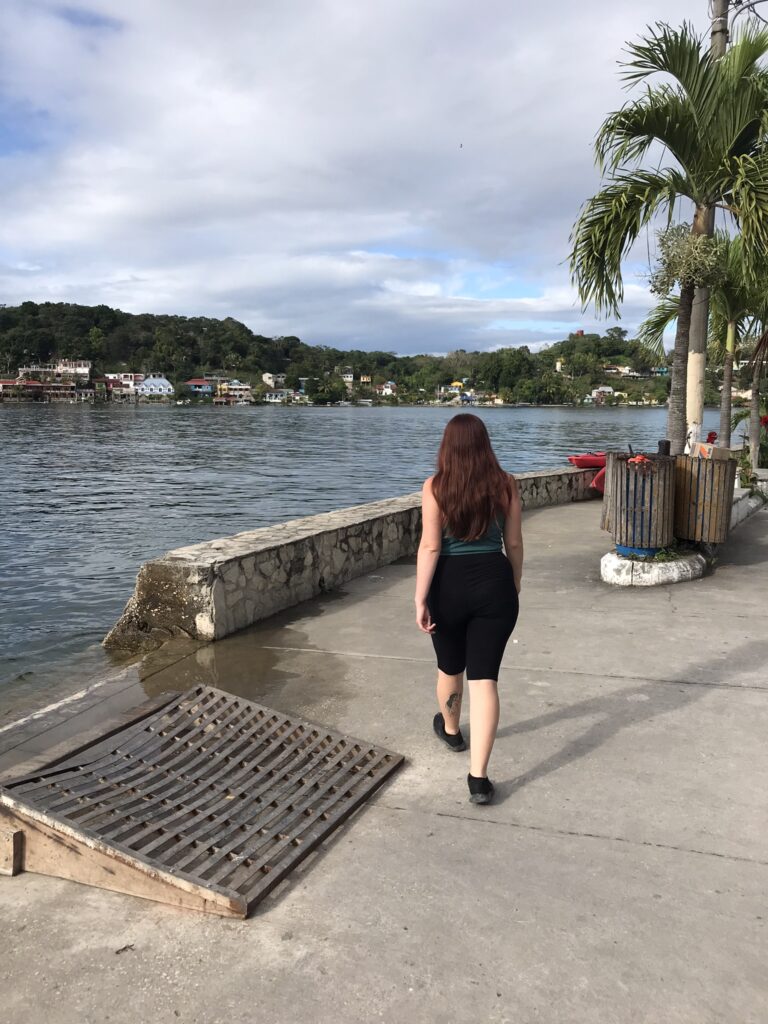
The shoreline opposite Santa Elena is full of little lodges
We arrived to Flores via colectivo from the border with Belize. The colectivo dropped us here in Santa Elena. When we arrived we were immediately swarmed by guys with tuktuks. In reality it was only a 30 minute walk across the bridge to the island and we were happy for the walk. If you’re crossing the bridge on foot, keep an eye out for turtles in the water. We managed to spot one completely by accident.
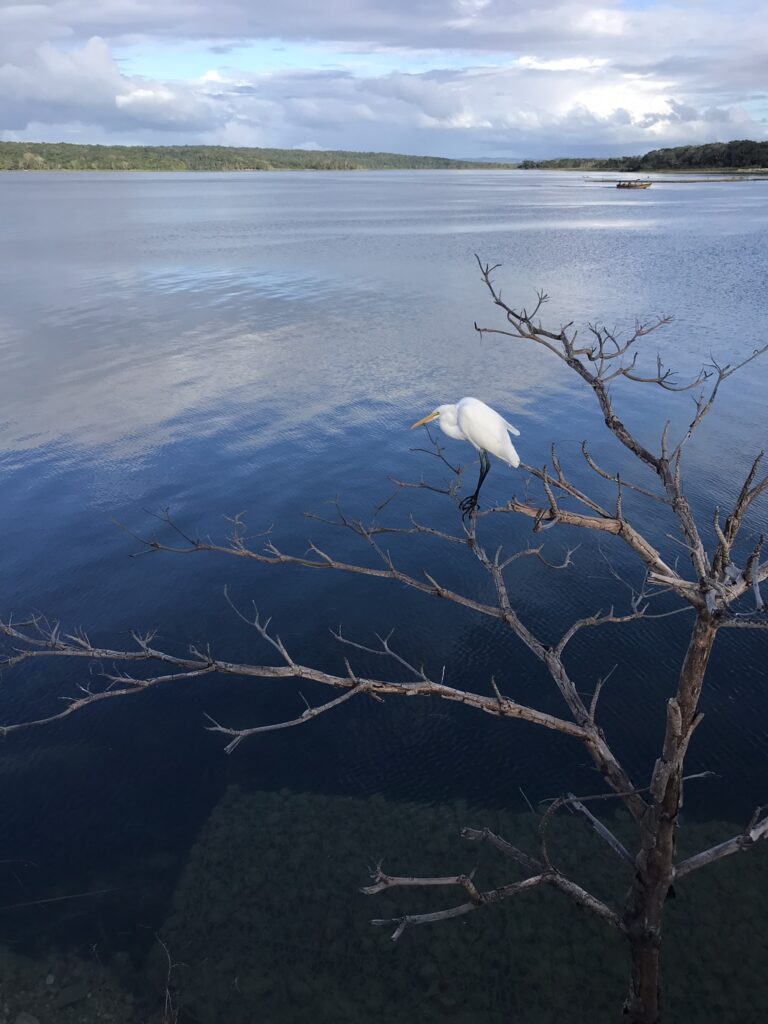
There is plenty of wildlife to be found around Lake Peten Itza
Flores is geographically quite remote and it is difficult to find information online about transport connections to other parts of the country. There are local colectivos and a bus terminal with overnight buses to Guatemala City, but outside of that we couldn’t find any reliable info about onward public transport. In the end we gave up and booked a transfer to Lanquín through Los Amigos hostel. We always try to travel independently where possible but in this case we couldn’t be bothered with the fuss of trying to make our own way there. While the shuttle was slightly more expensive, it would’ve taken multiple changes and most likely at least one overnight stop to get to Lanquín on our own steam.
Foodie Places
Cool Beans – right on the waterfront, serving cheap and delicious fare with an easygoing vibe. After surviving mostly on corn-based food for a long time in Mexico I was especially excited to see pesto pasta on the menu!
Supermercado La Torre – a very good supermarket in Santa Elena located in the mall right next to the bridge to Flores. There aren’t any large supermarkets on the island itself but this is within walking distance. The La Torre supermarket chain was one of the best we came across in Central America.
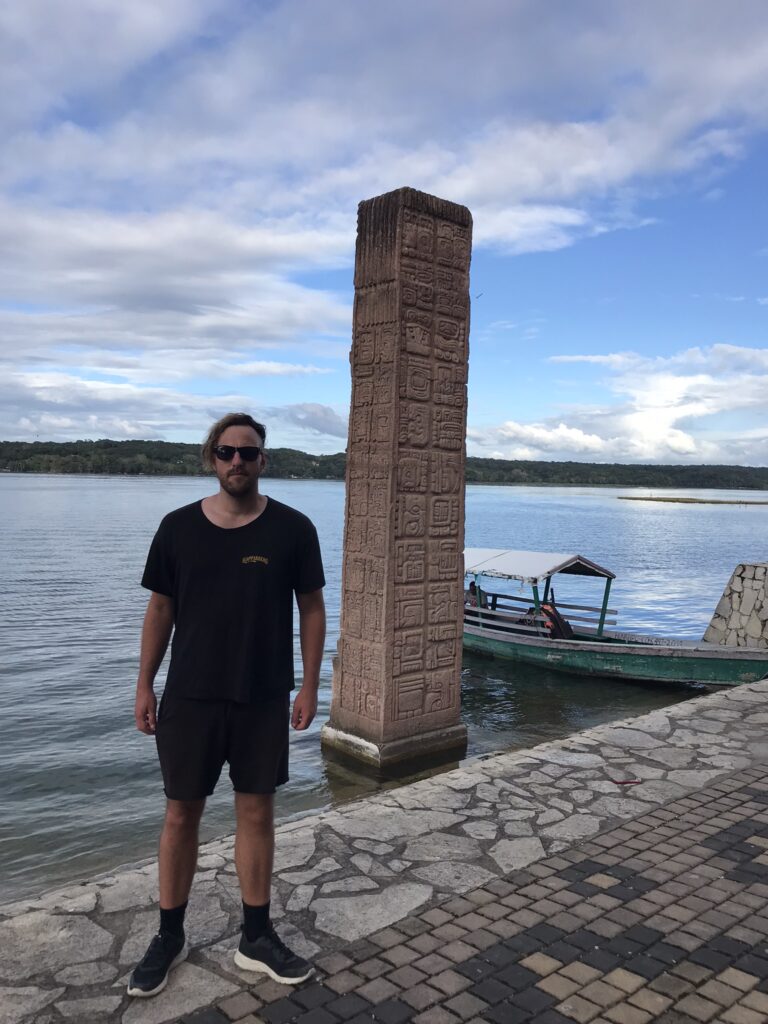
This Mayan-style monolith was just outside the supermarket La Torre in Santa Elena
Accommodation
Most people choose to stay on Flores island as that is where the majority of action is, although cheaper accommodation is located just across the 6A Avenida bridge connecting Flores to the mainland. We stayed in a cheap Airbnb on the island just off Calle Fraternidad which was fine.
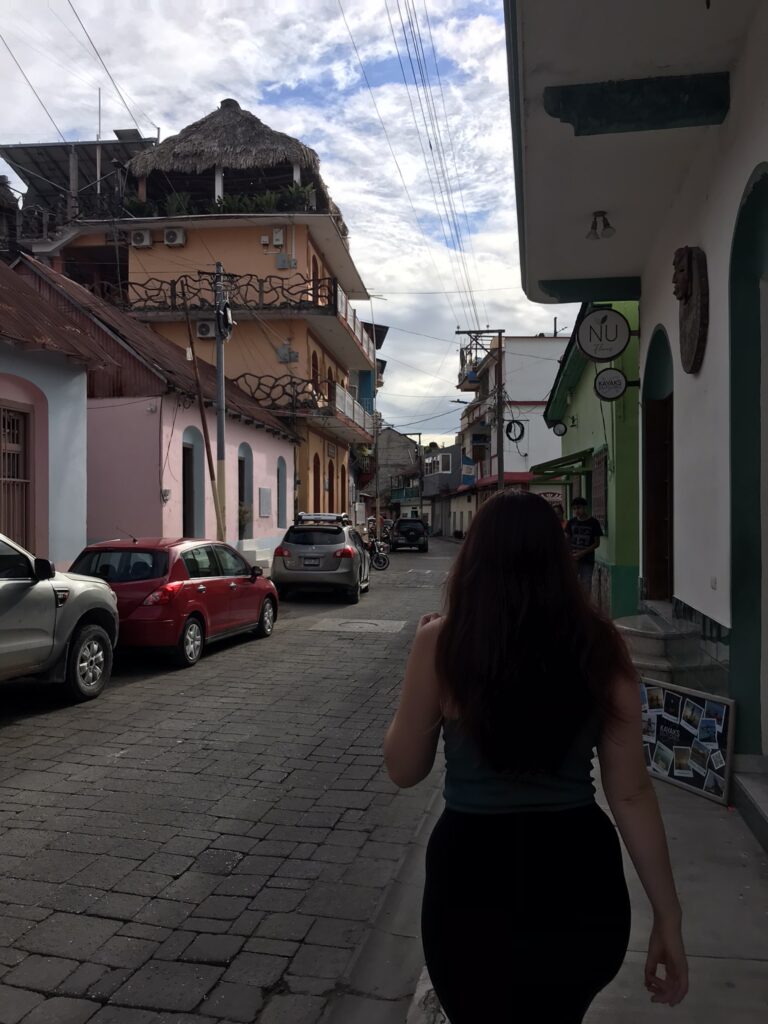
Calle Fraternidad is one of the main circular roads on the island but was still really quiet
Activities
Walk the complete circular route around the island – this is particularly nice to do at sunset. We watched some gringos sunbathing on a half-sinking wooden pier along the Malecon and it looked very precarious even though they were relaxed about it.
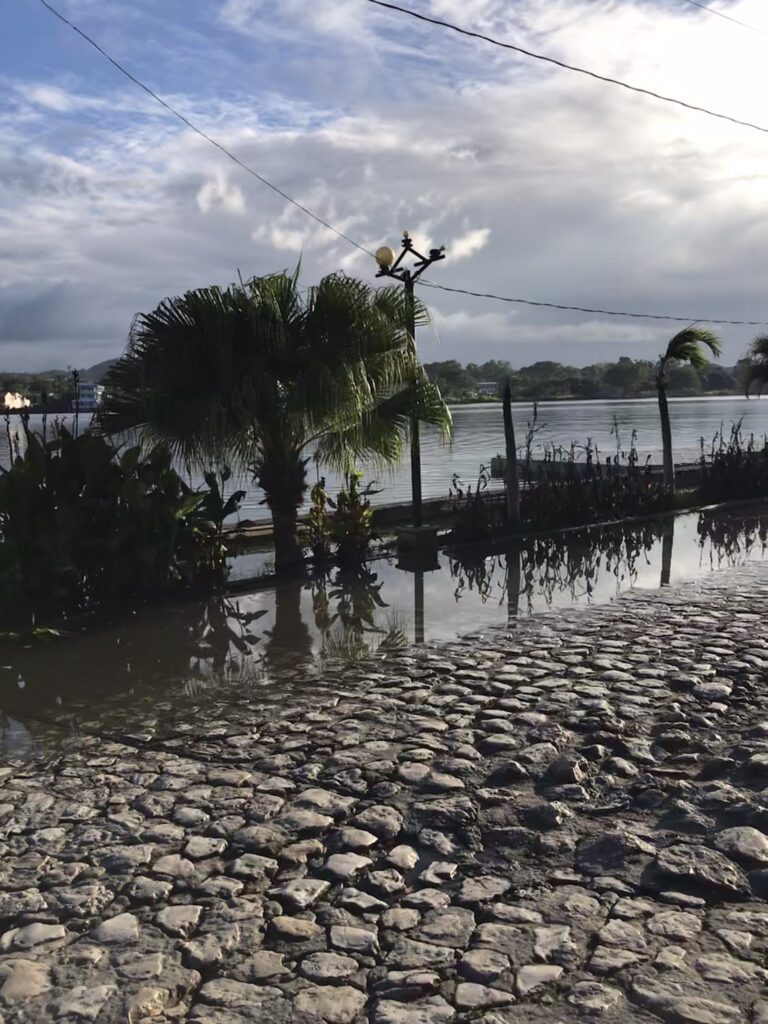
The cobblestone walkway surrounding the island seemed to be flooded at points
Day trip to Tikal booked through Los Amigos – Tikal is one of the largest Mayan ruin complexes in the world. The sheer size of the site is impressive, especially as only a small portion has actually been excavated. Most of the site still lies under the jungle floor. There are numerous plazas separated by jungle trails, with towering temples and ruins.
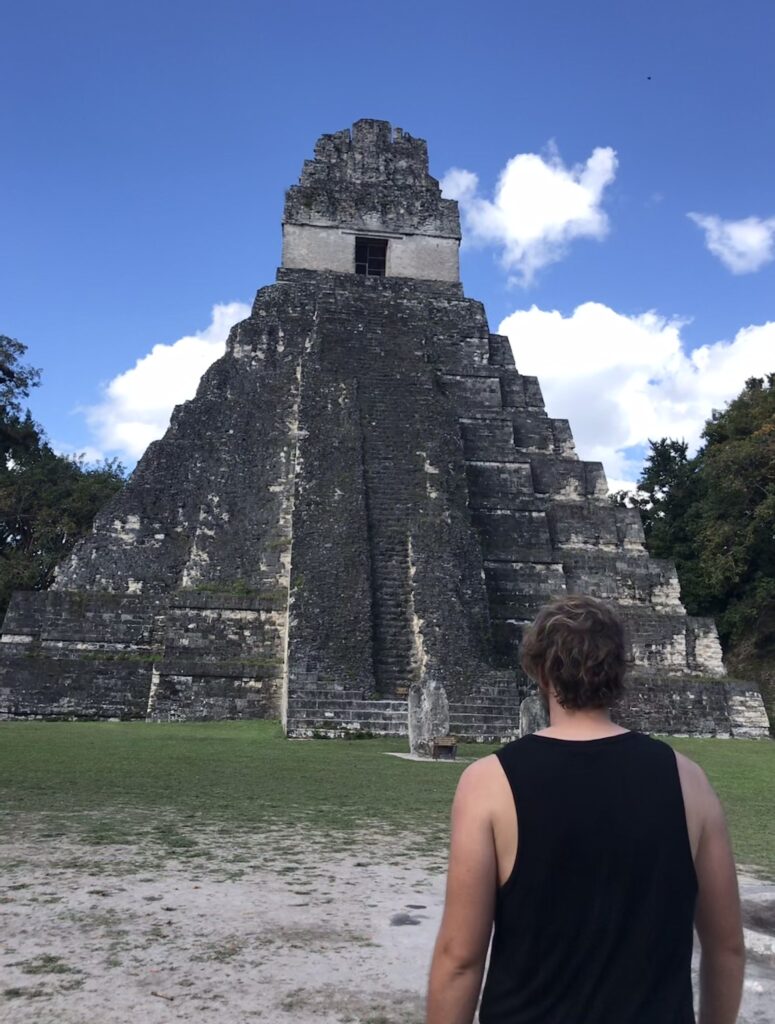
Here we go again
Tikal is remote, surrounded by jungle and wildlife. Multi-day passes are available and some tourists stay overnight in the park in the hope of seeing a jaguar. After speaking with local guides it seems the chances of this are very slim, but there is plenty of other wildlife on show. We saw tropical birds, coatis climbing the temples and on the walk back to the bus we heard the iconic howl of some howler monkeys, it was so similar to the Jurassic Park dinosaur noise that it inspired.
Though the Mayan civilisation was not an empire and did not have a singular capital city, Tikal was certainly one of its largest and most powerful city-states. The temples and structures at Tikal are some of the tallest in the Mayan world. It’s possible to climb some of the temples and peek over the jungle canopy to get a view of the other temples towering above the tops of the trees.
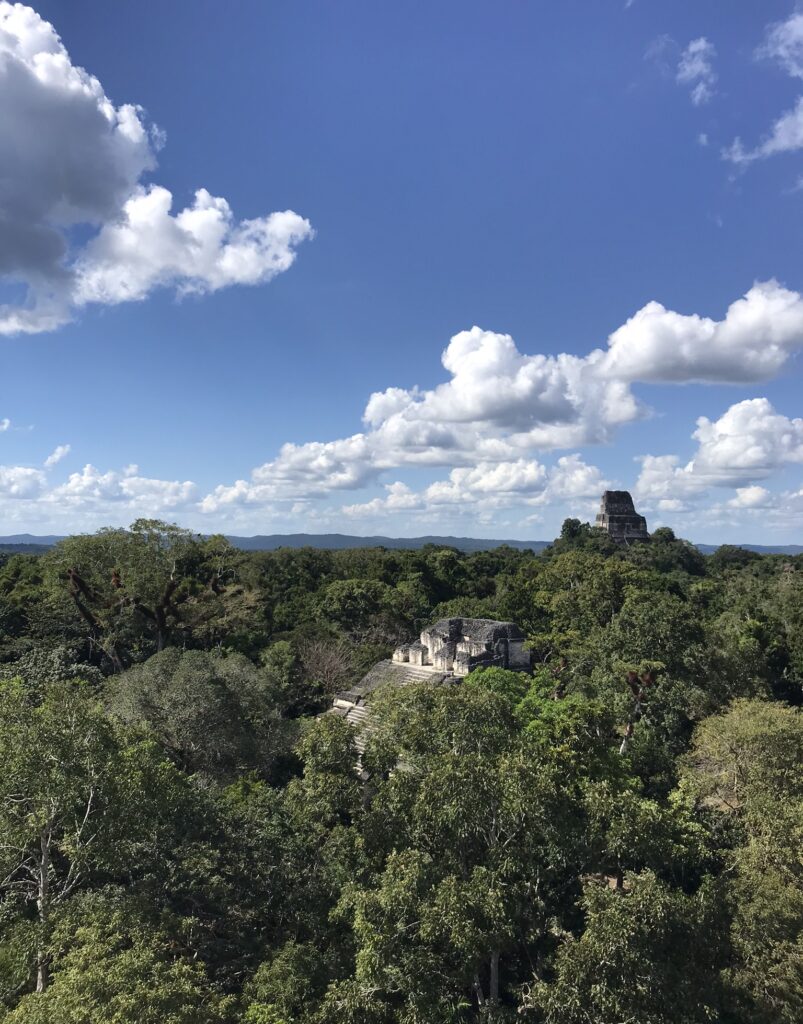
The size and scale of these ruins is seriously impressive
After visiting many other Mayan sites independently, we decided to take an organised tour with a guide to Tikal which we booked via a hostel in Flores. The price wasn’t too bad and we were hoping that visiting with a guide would provide some extra context and information. It also guaranteed return transport as Tikal is actually quite a distance from Flores, giving us a break from dealing with constant transport logistics. There were three tour options: sunrise, mid-morning and sunset. We opted for the mid-morning tour so we didn’t have to get up too early. As usually–independent travelers, we found it a little frustrating taking an organised group tour. The guide wasn’t all that informative and the tour was rushed, we spent around 30 minutes waiting at the restaurant outside the park for no reason and only spent around 2 hours at the archeological site. The tour wasn’t as thorough as I wanted but it was okay for the price, however it affirmed our belief that DIY is the way to go. Some people just booked the transport without the guide and this seemed like a better option in hindsight.
If you do want to visit Tikal independently, there are colectivos running from the bus terminal in Santa Elena. Make sure you bring lunch with you as the on-site cafe is a bit overpriced.
Lanquín
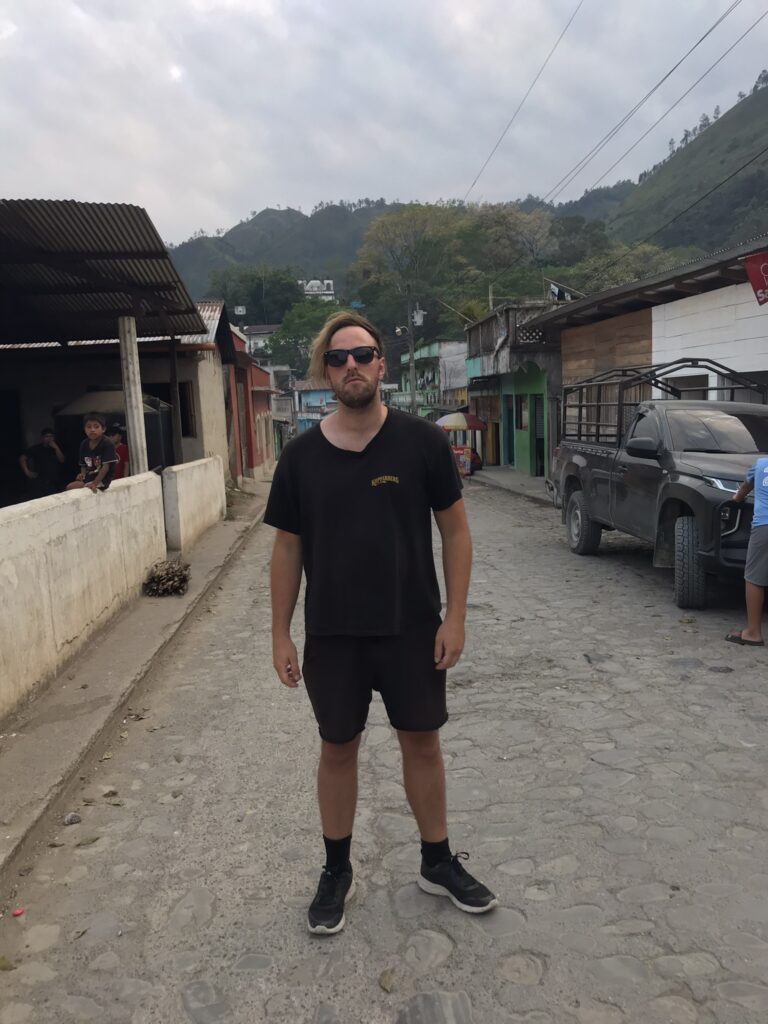
The small, rustic town of Lanquín is quite remote, with the closest city of Cobán about 90 minutes drive away. Cobán is the gateway to Lanquín, if traveling independently you need to make your way there and then arrange onward transport. We copped out of two difficult travel days and took a direct tourist shuttle from Flores, the bus journey involved a precarious boat crossing where the whole minibus was ferried across the river with all the passengers inside. The journey also passed through some very rural areas with roadside markets full of women in indigenous dress. The tourist buses pick up and drop off opposite the gas station on the main road heading into town, from there it’s a 15 minute walk to the centre of Lanquín.
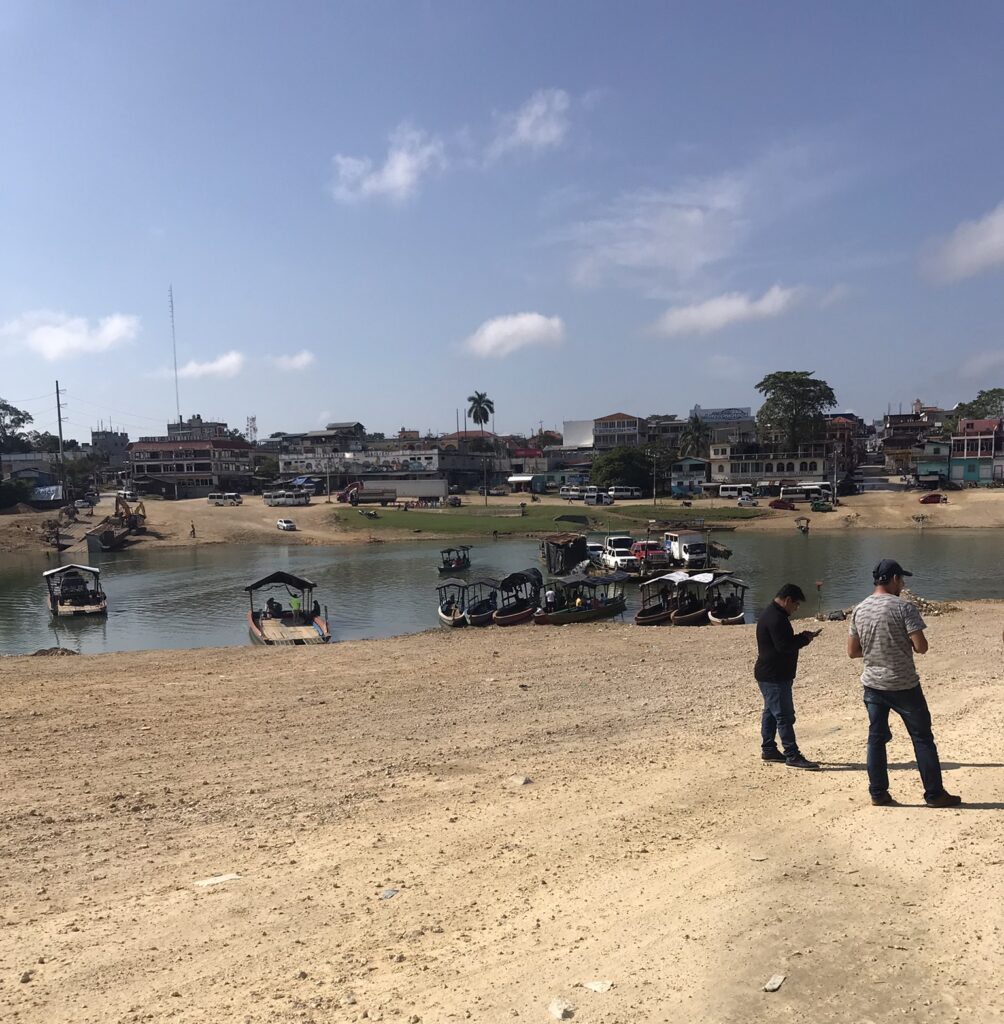
Waiting to cross the river on the way from Flores to Lanquín
Most visitors who head to Lanquín do so because they want to visit Semuc Champey, the fabled natural reserve close to town. It is easy to arrange transport to Semuc Champey from Lanquín, however many people choose to stay in an eco-jungle lodge outside of the town rather than staying in Lanquín itself. I understand the attraction of being in the jungle and closer to Semuc Champey, but these places are pretty cut off from the outside and can be a bit too much of a tourist bubble in my opinion. When we got out of the tourist shuttle in Lanquín we were circled by local drivers trying to arrange pickups for the jungle hostels, the drivers seemed genuinely confused that we weren’t staying at a hostel outside the town centre.
You can tell that the town doesn’t get many outside visitors as the locals were practically eyeballing us the whole time we walked around the town centre. There was a bit of a wild-west feeling to the town but I think it was more curiosity than malice. We enjoyed walking around and checking out the burned-out church from the outside. It’s definitely a more authentic and interesting experience to stay in the town.
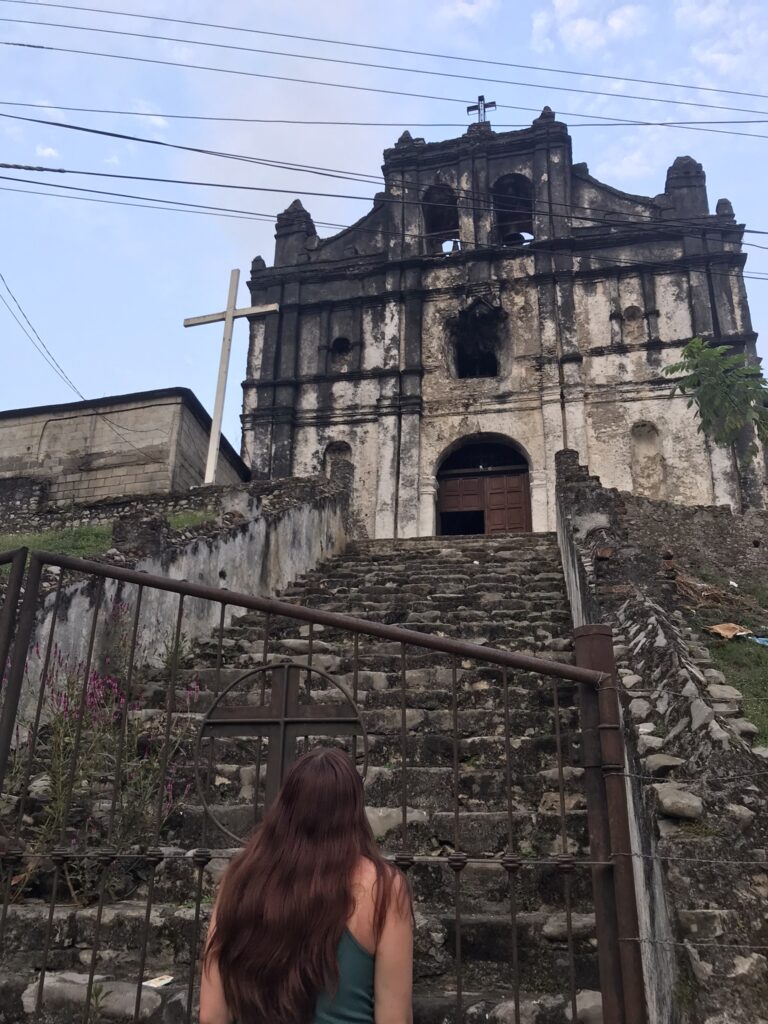
This is by far the largest building in Lanquín, I’m not sure what the story is
Foodie Places
Kalula Café y Restaurante – seemingly the only decent restaurant in town, there’s a roof terrace upstairs and cafe-style vibe downstairs. The food is pretty average but much better than we expected in this remote town. The staff were strangely disinterested and rude, we saw other customers actively shouting and arguing with the waitresses because of their poor service and attitude. This place also isn’t great for vegans as there aren’t many vegan-friendly options on the menu. Despite all this we ended up eating here multiple times.
Accommodation
Hotel Rabin Itzam – a basic hotel with slightly older furnishings. Don’t expect a fancy 5* establishment but we enjoyed staying here. The rooms have everything you need i.e. a bed, toilet, shower and fan, as well as a TV with many Mexican channels. The owner and his son were incredibly friendly and the ladies who made breakfast were also very warm and welcoming, even making sandwiches for us to take to Semuc Champey for a small charge.
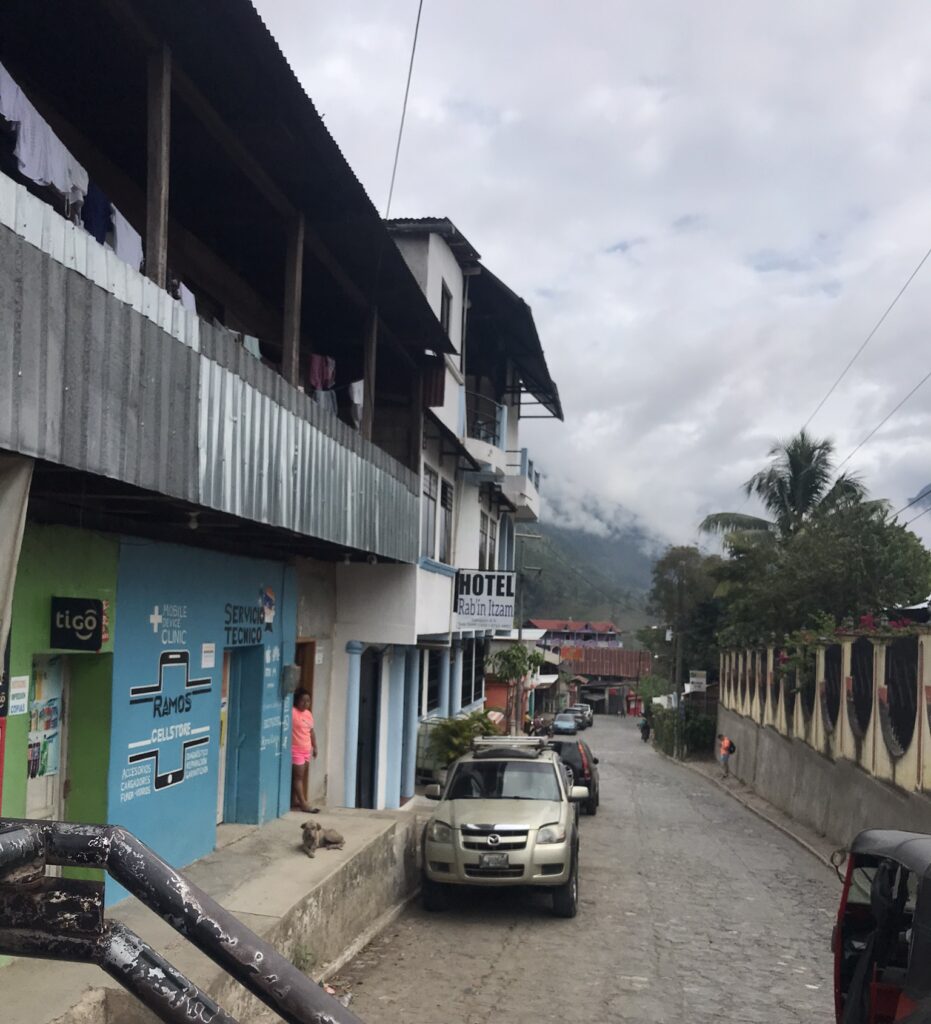
We received a warm welcome at Hotel Rabin Itzam
Activities
Semuc Champey – we organised with the owner of Rabin Itzam to be picked up after breakfast. What better way to travel than standing up in the back of a flatbed truck. The truck randomly did a few loops of town to try and attract more customers and then we were off along the mountain roads to Semuc Champey, clinging to the metal bars with the wind whipping through our hair. It’s the best way to travel, price-wise and just for the experience.
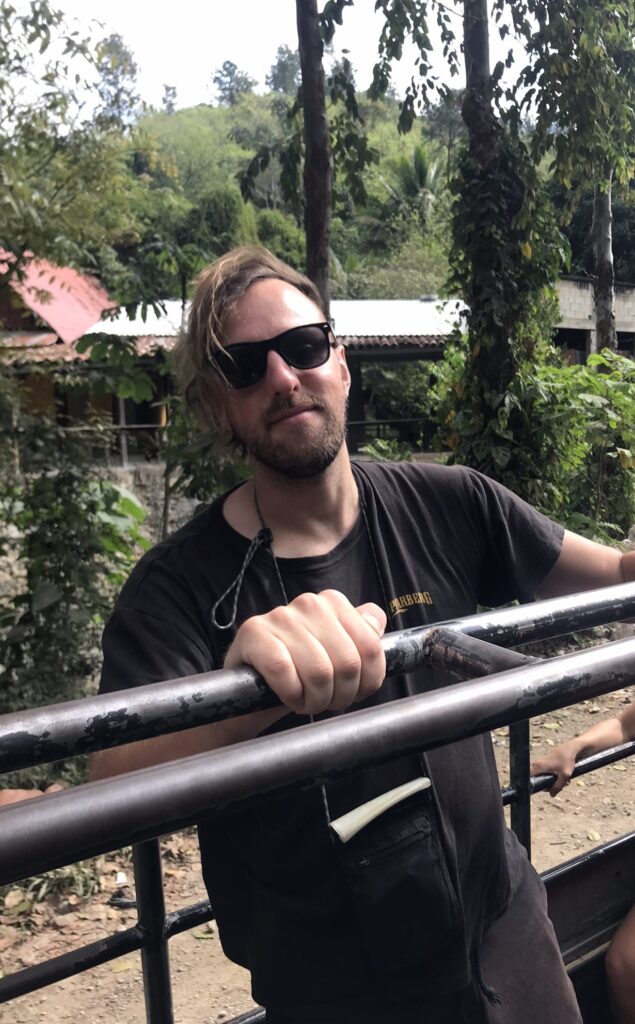
Dan in the truck
We liked waving to other travelers in the back of passing trucks who were doing the same. There were a couple of other tourists as well as locals in the back of the truck with us. The road from Laquin to Semuc Champey isn’t always paved, at some points it’s a dirt track. The road can be pretty bumpy so hold on tight! It’s most definitely a white-knuckle ride.
You get the best view from this seat!
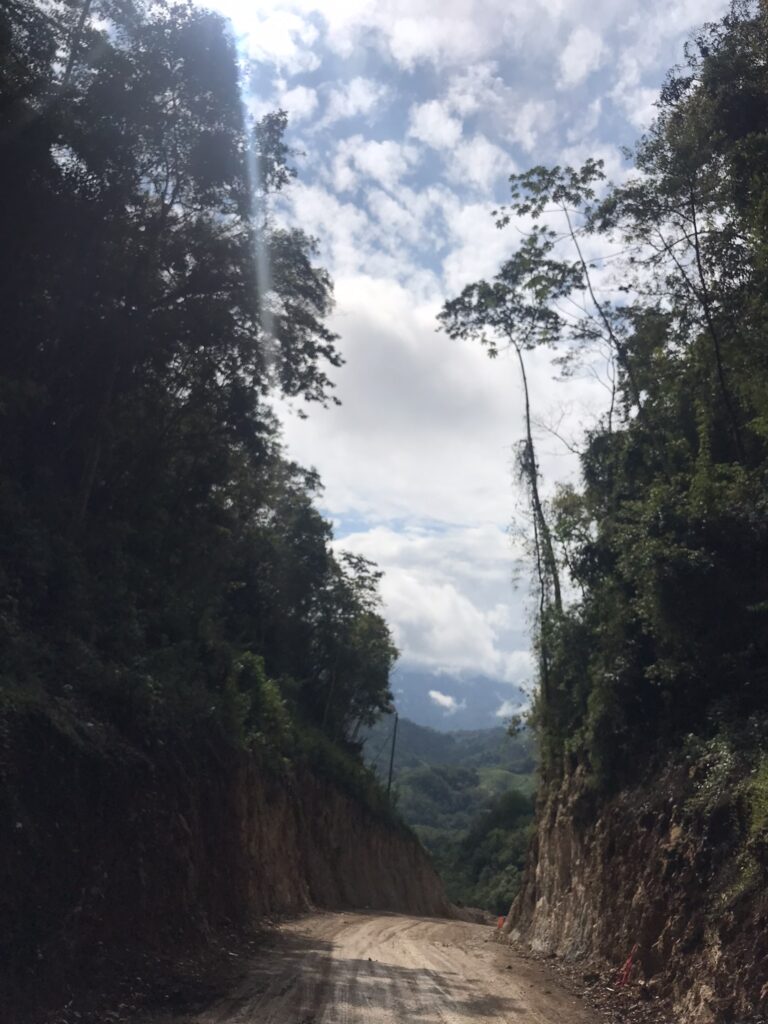
There are some wonderful views on the way to Semuc Champey
After paying to enter Semuc Champey we chose to go straight for the fairly heavy uphill climb to the iconic viewpoint looking over the crystalline blue pools. It is possible to skip the viewpoint and just head straight on to the pools, but I think most people want to get the tough climb out of the way first and then relax and cool off in the water. The viewpoint was extremely busy when we arrived. At the top there were many Guatemalan families and even some friendly old ladies in beautiful traditional dresses who had done well to make it up the hill. Most of the Guatemalans were trying to take pictures with the view. The big queue to get a photo was being managed by a member of staff, who was ushering people away that were taking too long or trying to get multiple shots. We heard that sometimes it takes up to an hour just to get a photo here. After a while the tourist hordes dissipated and we were able to properly appreciate the view in peace.
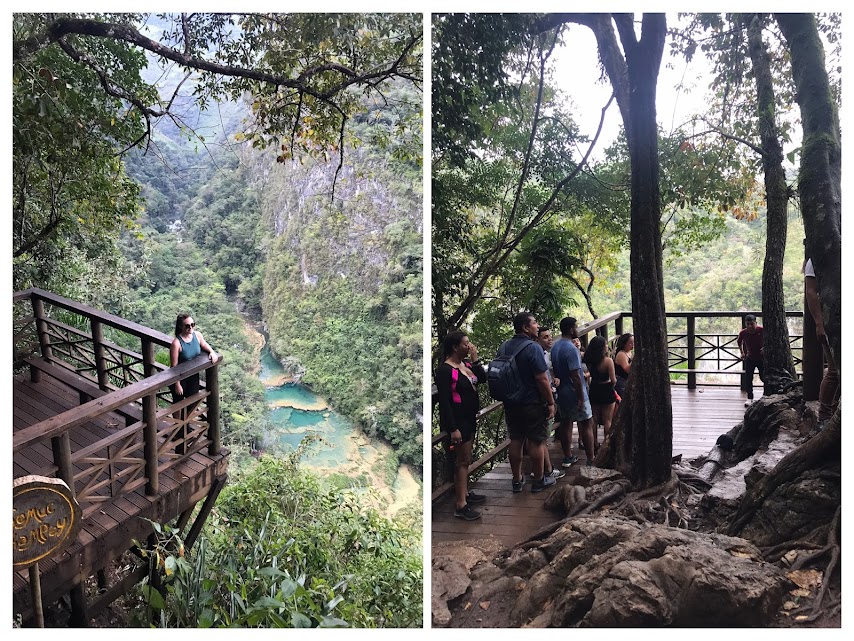
Perception vs reality
It was rainy when we visited so the wooden walkways around the site were quite slippery, the up and downhill trails between the pools and the viewpoint were especially treacherous as there weren’t any wooden walkways with handrails. We saw a man carrying a young child slip over due to the wet weather conditions, thankfully the child was unharmed.
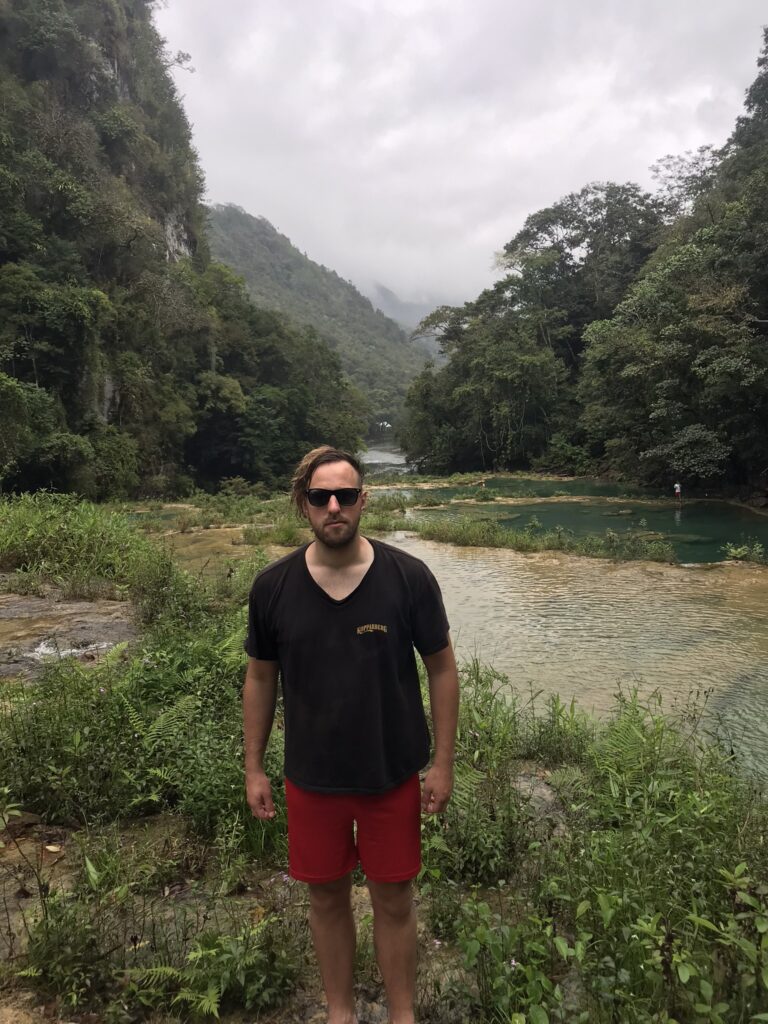
We chose a wet and overcast day to visit
There are some changing rooms and lockers near to the pools, although I think you need to bring a lock with you. We just left our belongings by the water’s edge and weren’t too worried about anything being stolen.
I imagine the cool waters are a welcome relief on a hot day but as it was overcast and rainy we didn’t spend too much time in the chilly waters. Plenty of others were swimming though. There are little fish that nibble your skin in the water, quite a peculiar feeling. The water was so turquoise and the towering jungle canopy only adds to the mystical feeling.
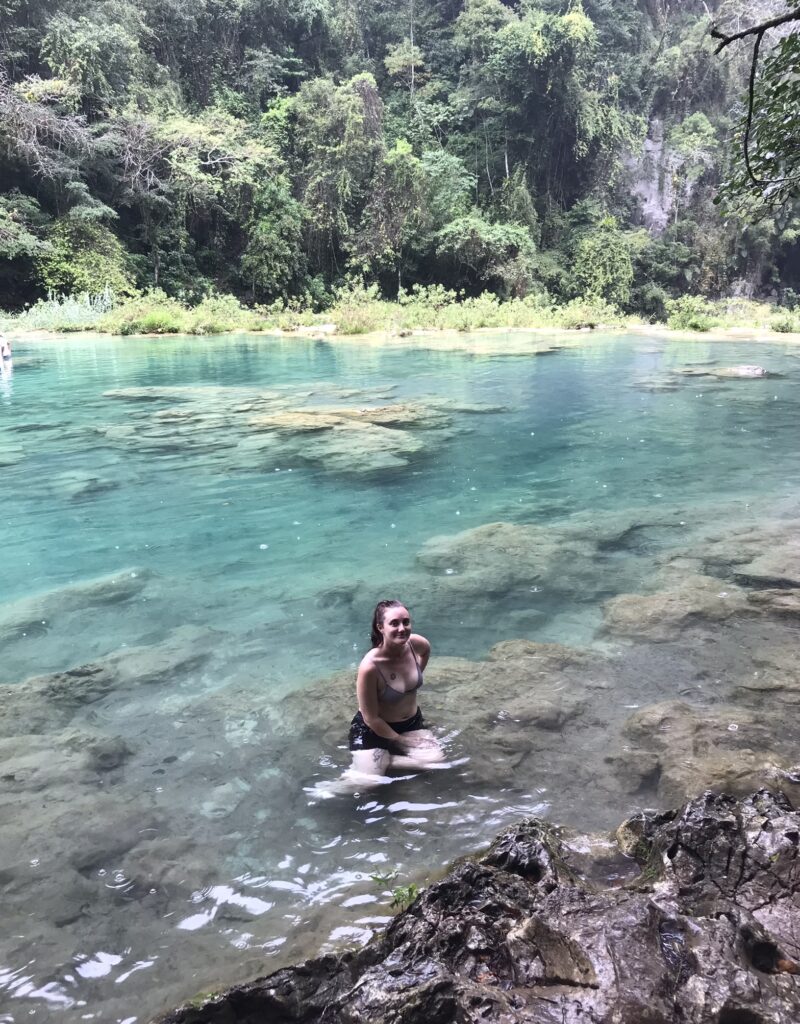
The pools were still a vibrant blue colour despite the rain
After visiting Semuc Champey it was easy to get a ride back to Lanquín, there were plenty of trucks waiting in the car park. I believe there are guided cave tours and other adventure activities available in and around Semuc Champey, but we didn’t partake.
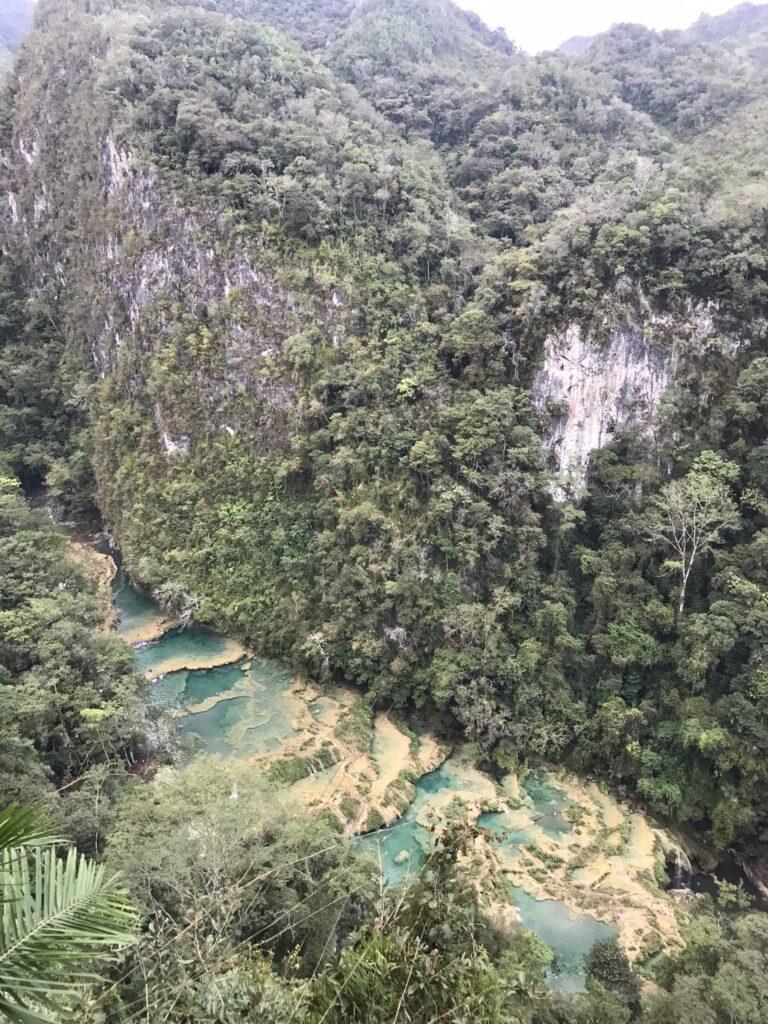
This is what it’s all about
We struggled to find onward travel from Lanquín to our next destination, Quetzaltenango. Going via public transport and chicken bus would’ve been a long, arduous process involving multiple changes and two full travel days. We found a company offering a direct shuttle from Lanquín to Quetzaltenango, which was relatively expensive but still much easier and also more cost-effective than spending two full days on chicken buses and having to stay overnight somewhere. The company offering the transfer was Monte Verde Tours.
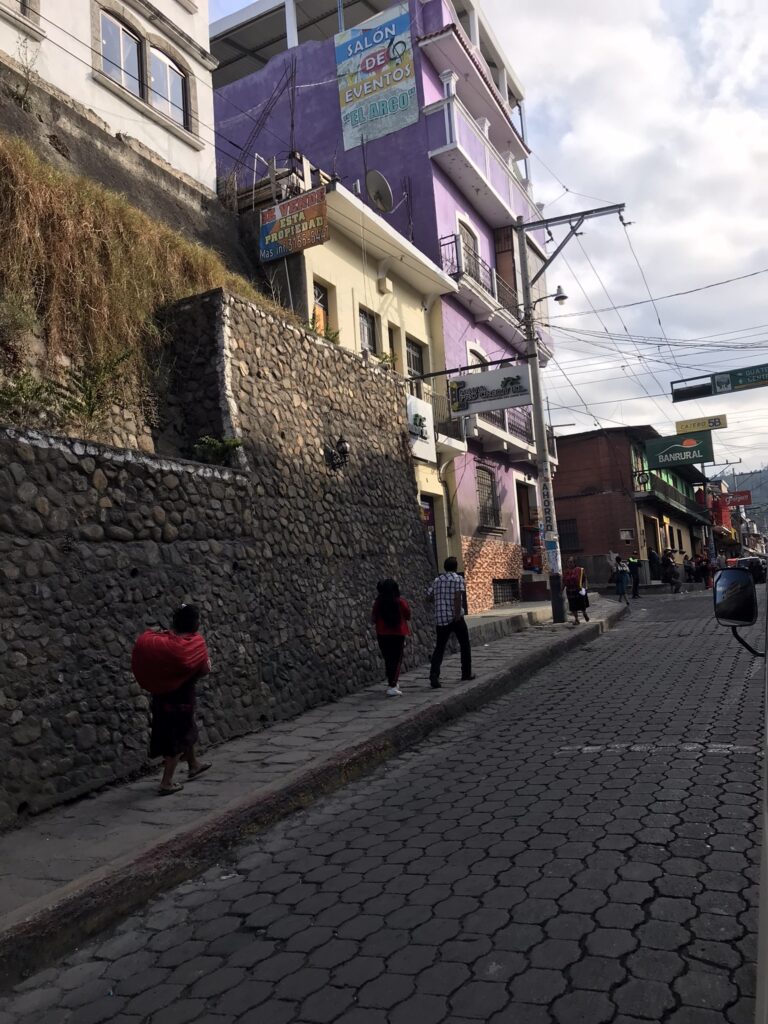
We drove through Chichicastenango on the way south
The shuttle transfer was a little unusual, as in Lanquín we were boarded onto a bus full of tourists heading for Lake Atitlan. We were the only ones in the minibus that were actually going to Quetzaltenango instead of Panajachel. After making most of the long journey south in the minibus, we were dropped off at a random gas station and told to wait for someone who was coming to collect us. We waited for almost an hour at the gas station, eventually a man arrived in his own car to pick us up and take us the rest of the way to Quetzaltenango. I don’t think this is a well-traveled route.
Quetzaltenango
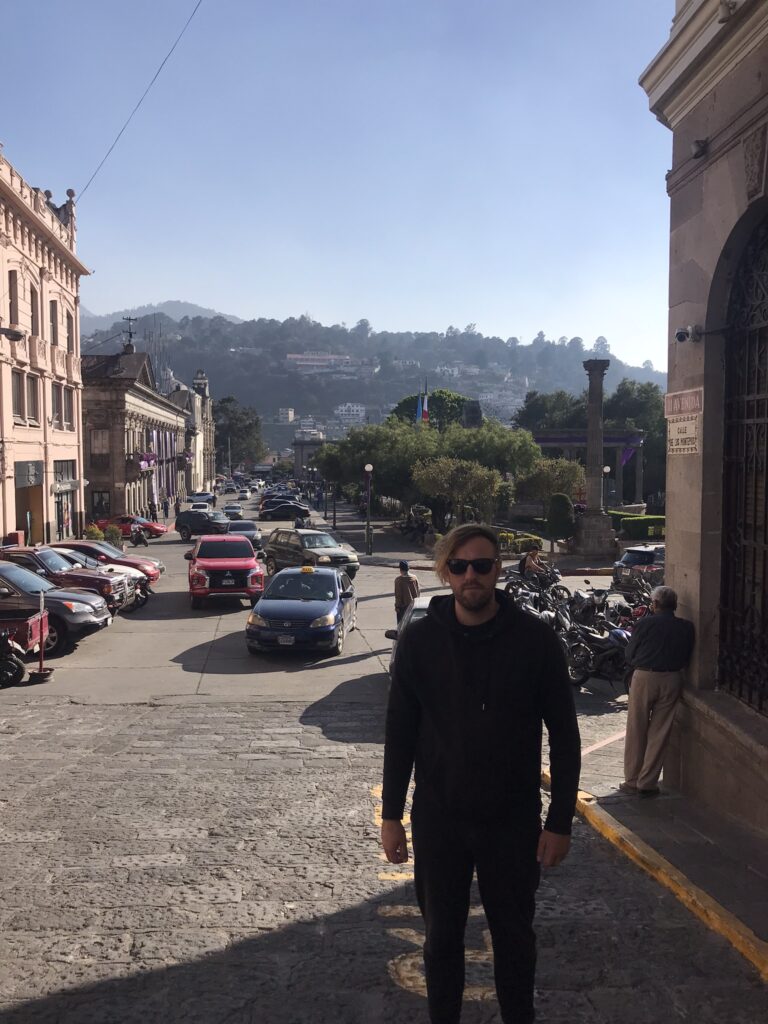
Quetzaltenango is strangely overlooked by many visitors to Guatemala, but it was the highlight of our time in the country. We found it to be an unpretentious and authentic city, without the hordes of gringos that are often found in tourist hubs like Antigua or Lake Atitlan. Quetzaltenango is a majority-indigenous city with large populations of Quiche and Mam Maya people. Surrounded by volcanoes, it has an almost mystical vibe. Ash rains down over the city from the nearby Santiaguito volcano and you can see a thin layer of ash on cars parked in the street. Someone asked our walking tour guide if the ash was detrimental to the health of residents, he shrugged and said he didn’t know.
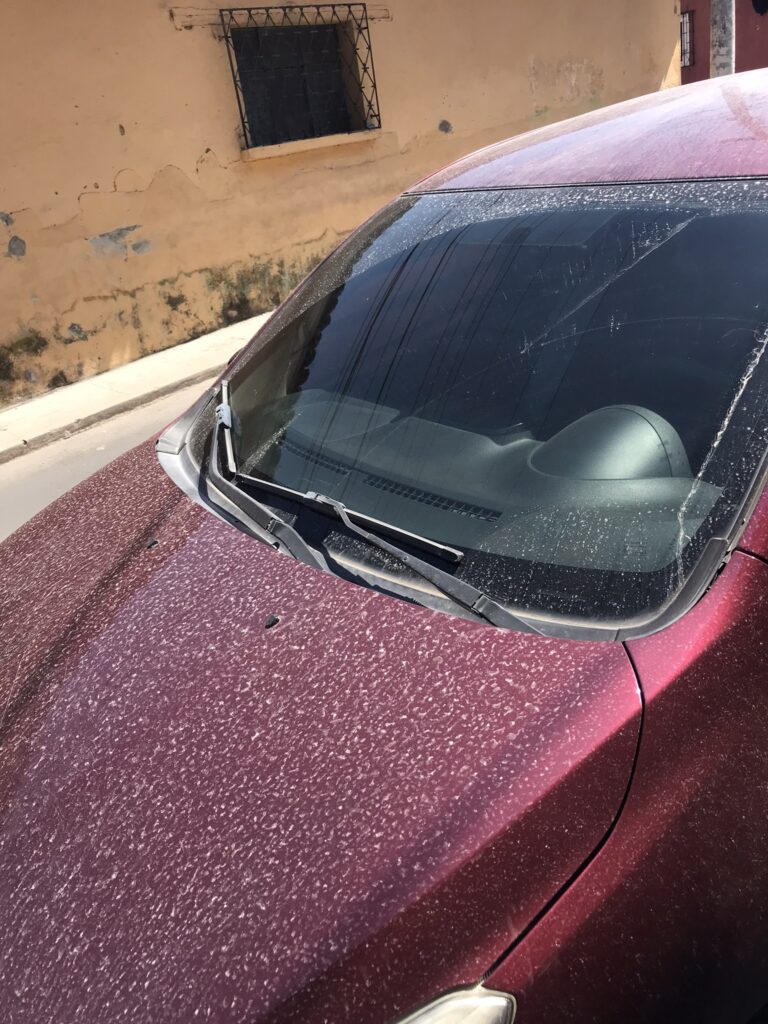
Volcanic ash constantly rains down on the city
Quetzaltenango is called Xela by almost everyone in Guatemala. Xelaju was the original name of the city, and as Quetzaltenango is a mouth-full most locals simply know it as Xela. The city’s historic centre has a large well-maintained central square which is a hub of activity, and the main square is surrounded by picturesque cobblestone streets. The Cathedral in the main square is interesting, the building was rebuilt due to earthquake damage but the original facade was left in situ making it look like there are two churches. Outside of the historic centre, the city’s built-up urban area stretches out for quite a long way. We saw many cheap second-hand clothes shops on the streets leading to the bus station.
Quetzaltenango lies on the main east-west highway in Guatemala so moving around is a little easier than in the north of the country, the roads are better and public transport is more forthcoming. We used Uber to get around Xela, and chicken buses to get to our next destination in Lake Atitlan.
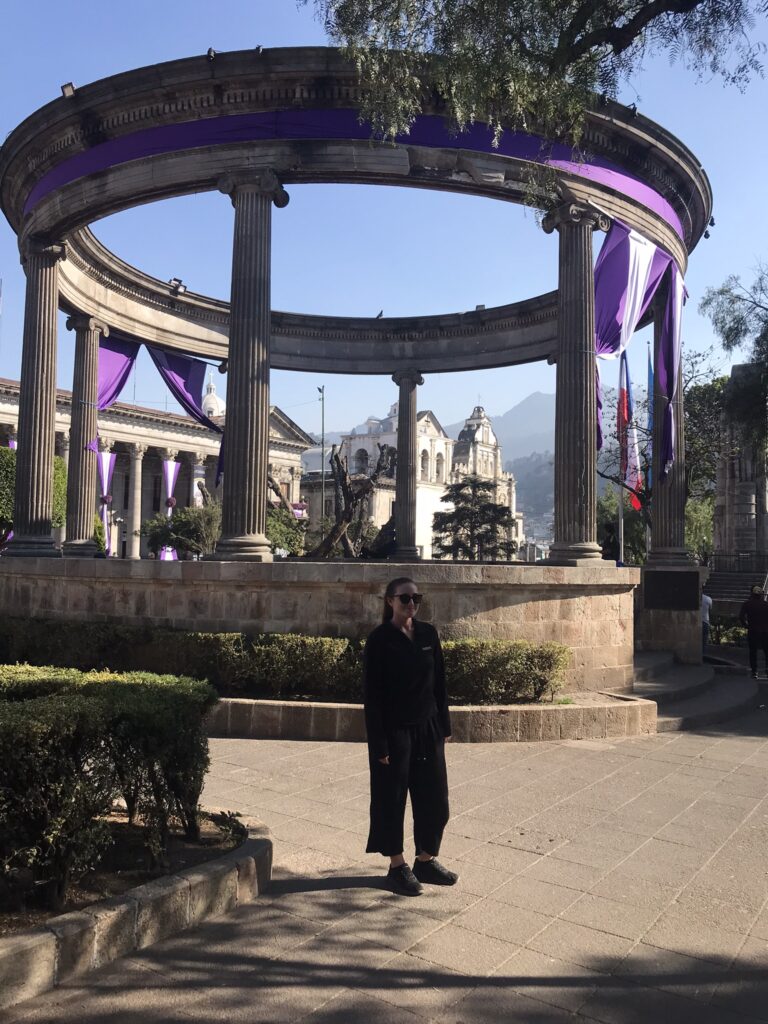
The bandstand in Parque a Centro America, a popular place to hang out
The bus station in Quetzaltenango is very chaotic and disorganised. It isn’t actually a station at all but more of a vast area where buses park up and wait for passengers. There didn’t seem to be any order to the buses, it was a case of walking around and asking drivers until you found the correct bus with your destination written on the front. It could definitely be overwhelming if you’ve never experienced anything like this before. We were worried about getting on the wrong bus but it worked out better than expected and we ended up getting a direct bus to San Pedro la Laguna without issue. For more info on chicken buses in Guatemala, check out my blog post.
Accommodation
Kasa Kiwi Hostel & Travel – a very popular hostel with good reason. There aren’t many options in Quetzaltenango and it seems like most budget travelers in town were at Kasa Kiwi, a cheap, comfortable and down-to-earth hostel without a lot of the typical nonsense of some backpacker hostels. The kitchen was the social hub of the hostel, often with multiple people cooking at the same time. We sometimes had to wait for a while to cook as it was too busy around meal times. We met some genuine people in the hostel and kept in touch. The only thing we weren’t too keen on was that the rooftop bar was open to the public in the evenings, we heard some terrible karaoke singing by the locals. It was weird to meet random Guatamalans in the middle of their night out while I was popping to the toilet.
The Kasa Kiwi website is a treasure trove of information about travel in Guatemala and nearby activities. It’s very detailed and up to date, they offer tours and there’s also info on how to do most of the tours and activities independently which we really appreciated. The hostel staff were also available to help out with any and all requests. I’m aware of some people who were provided helpful and accurate advice by the staff at Kasa Kiwi about crossing the border on the other side of the country from Guatemala City to El Salvador.
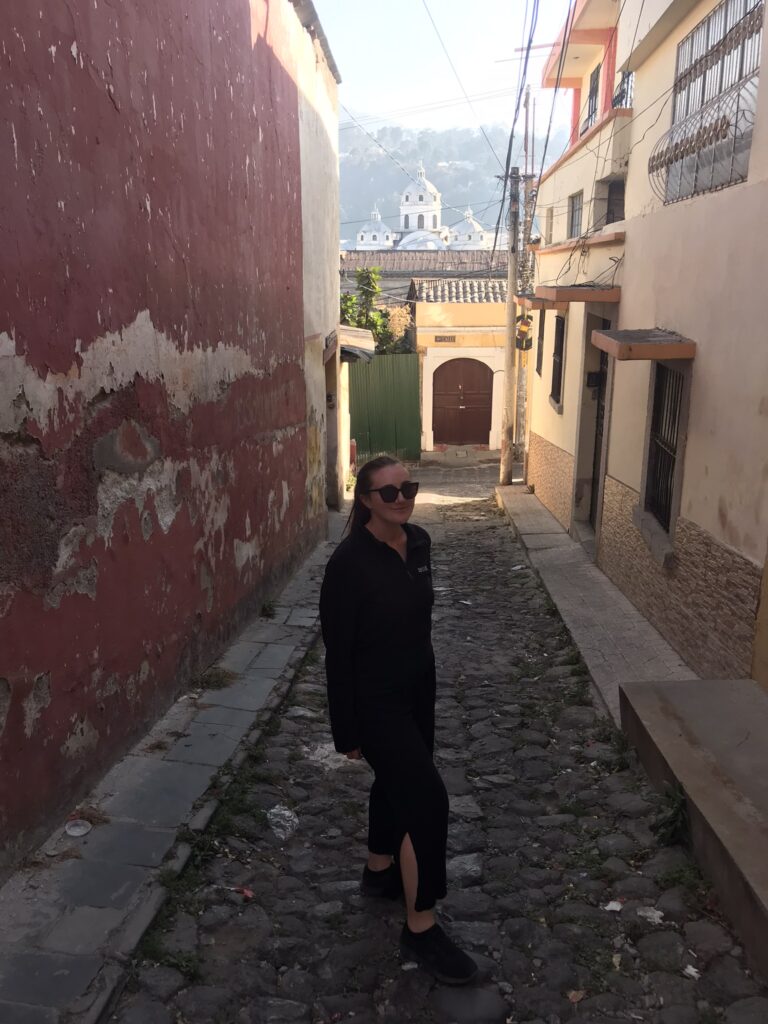
There are lots of narrow cobbled streets around the centro historico
Foodie Places
Xelapan – located right in the main square (Parque a Centro America), this bakery is a Quetzaltenango institution selling bread, pastries, pizza and baked goods. It’s the best place to grab breakfast or lunch on the go. We stocked up on supplies before heading out for the day. Bakeries are a great place to head if you’re on a budget. It’s always busy so grab some tongs and a basket and get shopping! There’s a cafe in the back of the bakery if you’re looking for a sit-down meal.
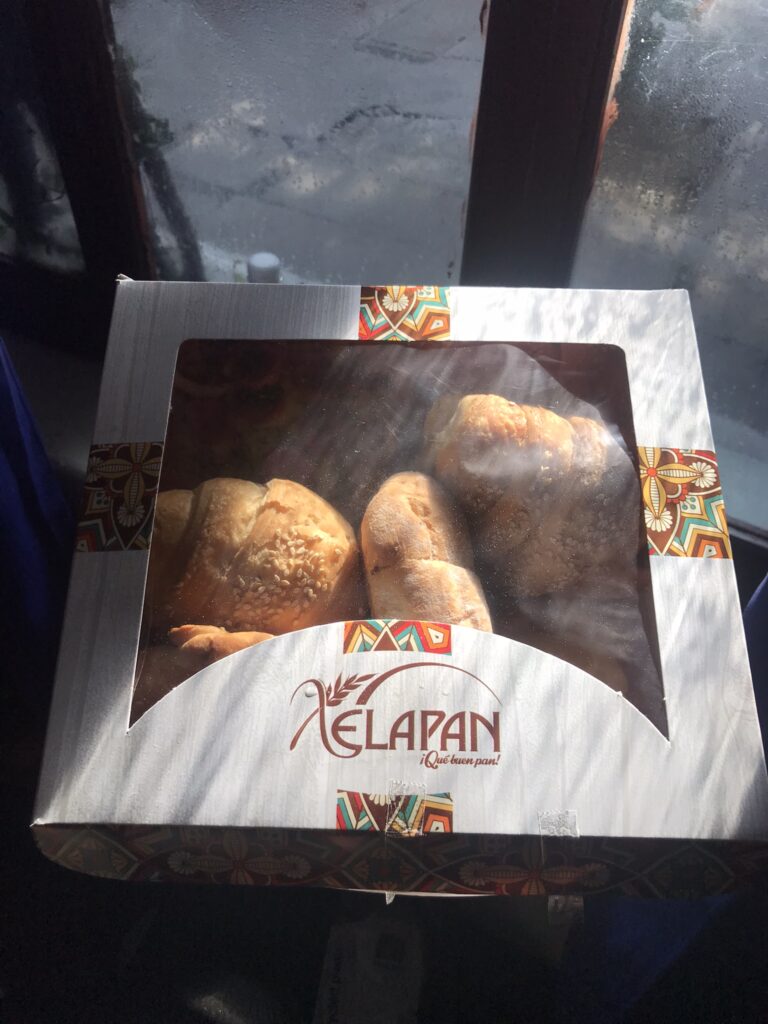
Baked goods from Xelapan were always a winner
El Rinconcito Español – Tasty food, generous portions and a great quality to price ratio. The meatballs and croquettes were out of this world. We ordered 9 tapas with 2 beers and it was less than £20!
Sandwicheria ‘Liquados y Ceviches’ inside the Municipal Market – a cheap sandwich stand in the market that was recommended to us, they put tomato ketchup on my chicken mayo sandwich and I wasn’t best pleased. Other than that the sandwiches were tasty and extremely cheap.
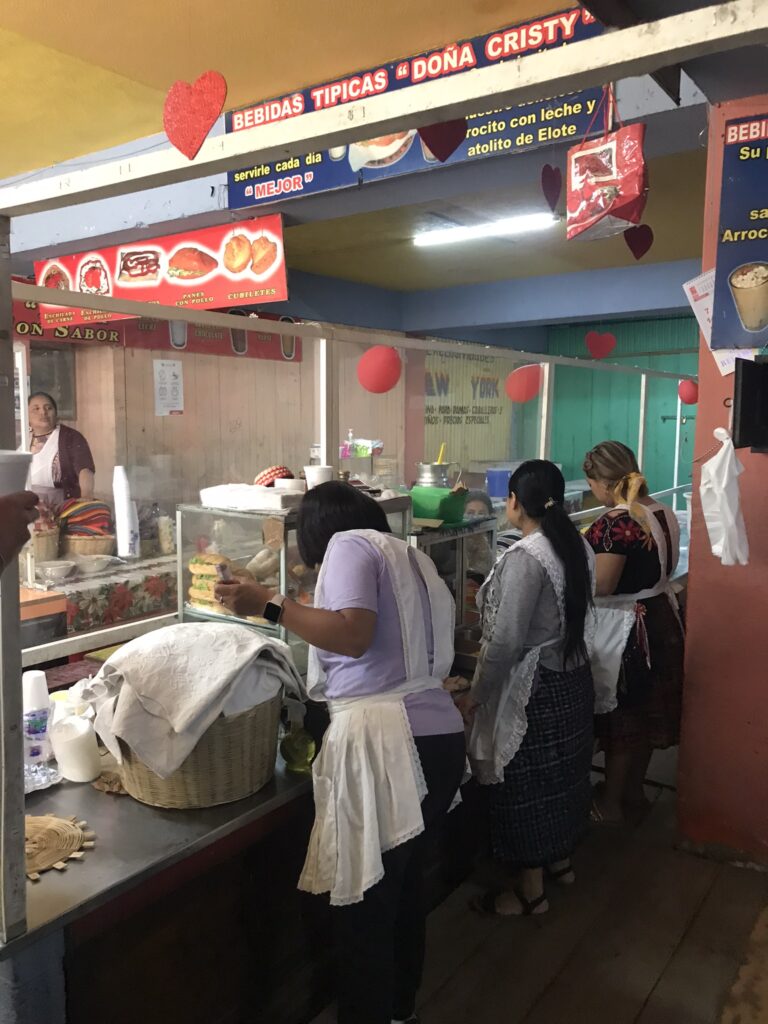
Ladies at work in the market, a good place to grab a cheap lunch
Chocolate de los Altos – selling artisanal chocolate and little chocolate treats. They also have local wine and other products for sale.
Activities
Guruwalk walking tour of the city centre covering Parque a Centro América (the main plaza), Catedral del Espíritu Santo, Municipal market, Soup market, Pasaje Enriquez (great place to grab a beer topped with shrimp, a local delicacy), Baviera Café (a very upmarket, European-style cafe which is a meeting spot for the city’s elite), Restaurante Mirador de Xela – XelaUp (a viewpoint over the city located on the south side of town).
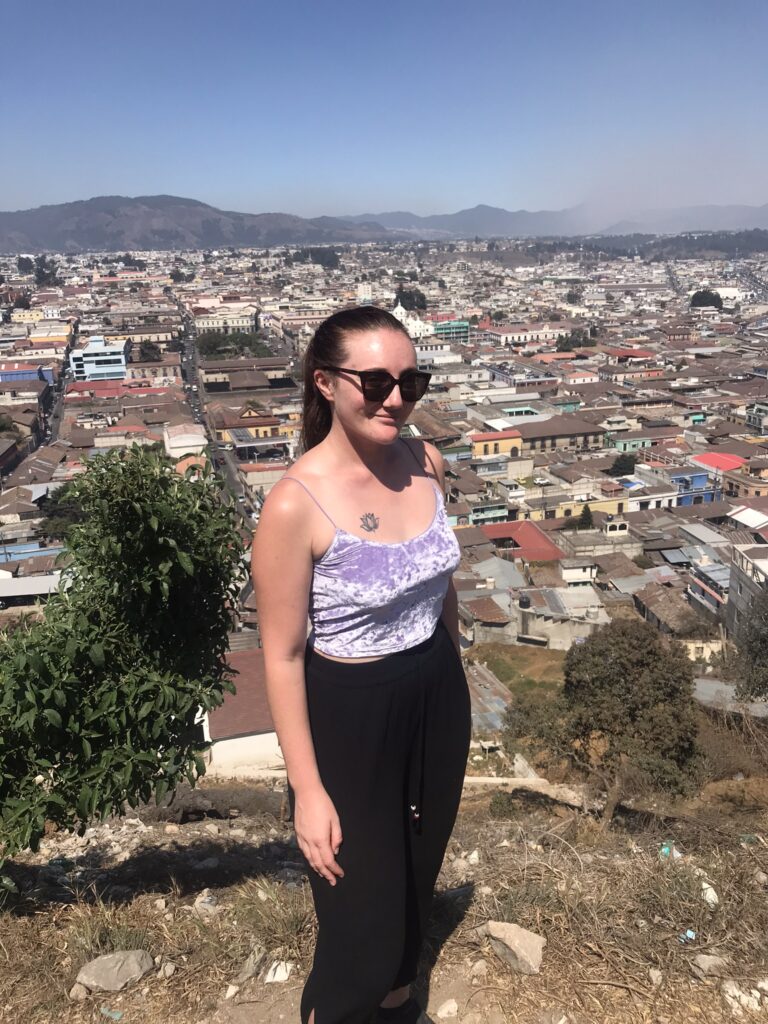
The walk up to the viewpoint was a little steep but definitely worth it. You can see the volcanic ash descending on the city in the background.
Municipal market – full of women in traditional dress, we tried a cinnamon rice pudding drink and some other local delicacies. A great place to stock up on ingredients if cooking for yourself, we particularly liked the vegetable market and the meat market, the chorizo sausages were ace. This is one of the few places we actually bought food from the market. There were also some quite gaudy meat products on display, large internal organs and carcasses on hooks.
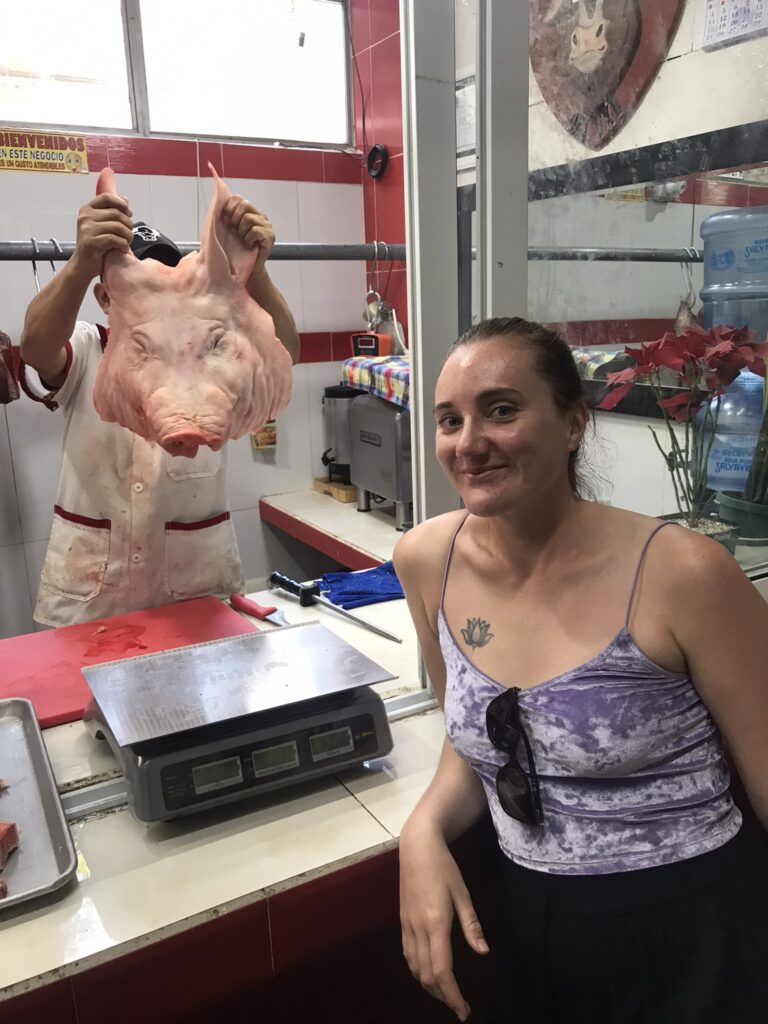
Truly the stuff of nightmares
Volcan de Cerro Quemado – this sacred mountain is a religious pilgrimage site for local people. The entrance to the site is located in the small mountain community of Cantón Chicuá, we got an Uber there from the centre of Quetzaltenango. There’s a checkpoint before you reach the village and you have to pay a small fee to pass through. The checkpoint is run by locals and for the benefit of the local community, it’s not an official police stop. We were worried that they were going to try to extort us but the fee that they charged to pass was very small, and they cheerfully waved us past without paying on the way back.
Once in Cantón Chicuá it was difficult to find the correct trail to the top of the mountain. We began to climb and eventually started to hear the sound of the rituals taking place. There were individuals and groups dotted around the mountainside, some in what appeared to be a trance-like state or face down on the jagged rocks. We personally saw groups gathered in a circle fervently praying, mesmerically clapping, chanting, crying and screaming out, burning things and reciting religious passages from the Bible. The sound was something I’ll never forget. It was a once-in-a-lifetime experience to see this fusion of traditional religion (Mayans believe gods live on the mountain and to speak to them they have to go to sacred mountains) and Catholicism. We even saw what appeared to be an exorcism on the mountainside, as the shaman was chanting ‘out out’ in Spanish and the female congregant involved was being sick.
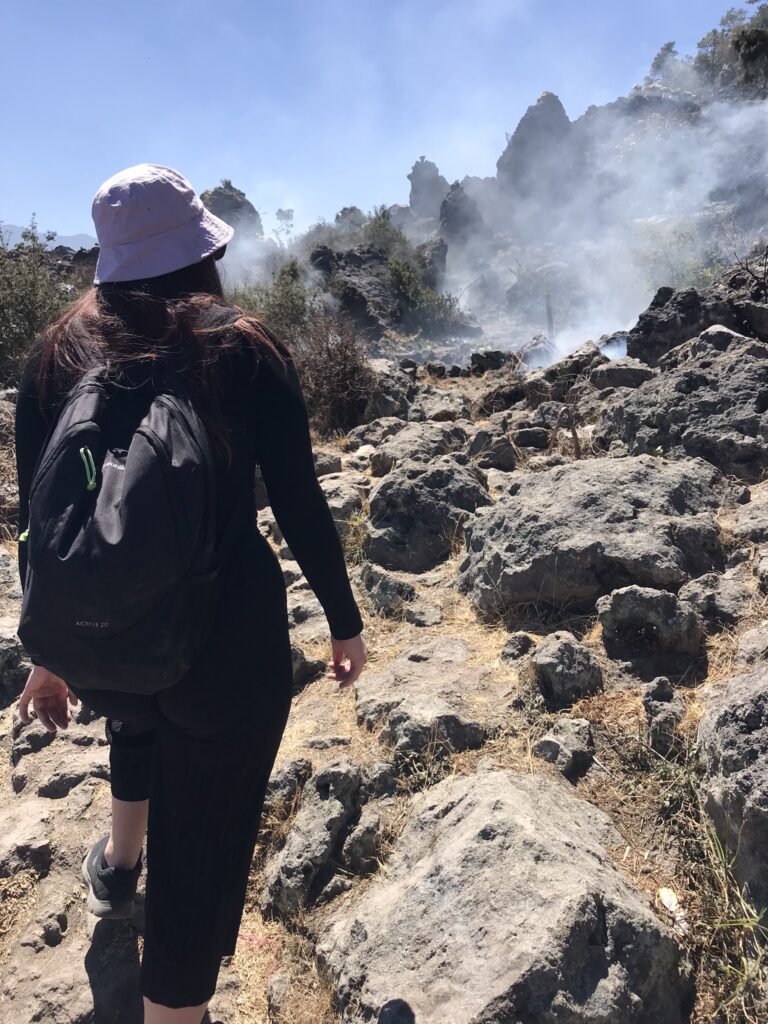
Cerro Quemedo was an unbelievable place
Locals purchase specific coloured flowers from sellers in Cantón Chicuá for ritual purposes. The jagged mountainside was covered with bunches of flowers in various stages of decay from previous rituals.
There are numbered shelters and worship areas where small groups of people were congregated, and further down the mountain were makeshift churches with large congregations spilling out of canvas tents, complete with a lineup of guest pastors and modern PA equipment. It’s quite challenging to reach the summit of the mountain, which is crowned with a flag of the Star of David. Near the summit we saw a family using a rope to climb a sheer rock face, at that point we promptly gave up on the idea of making it all the way to the top and turned back.
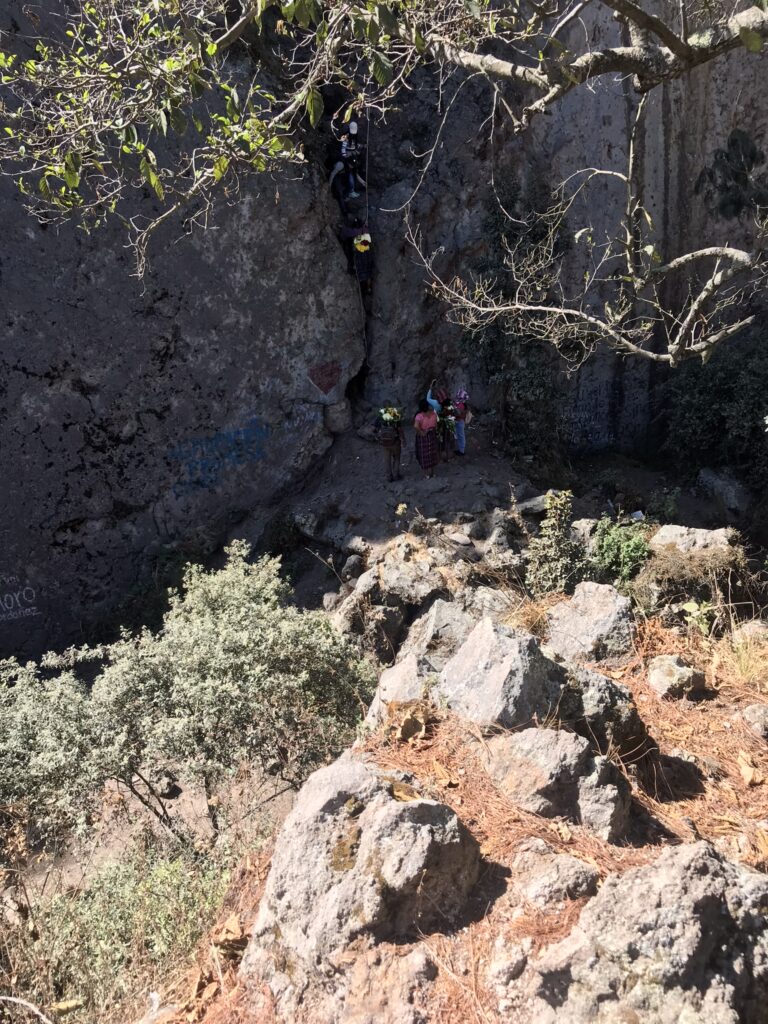
I’m sure they know what they are doing
Visiting the mountain is not a touristic activity, we weren’t unwelcome but it was clear that most outsiders don’t go to this sacred mountain. We encountered one Italian guy on the mountainside but there were no other tourists anywhere in sight, which is probably for the best. We felt it wasn’t right to get too close or take photos of the people in order to be respectful of their beliefs.
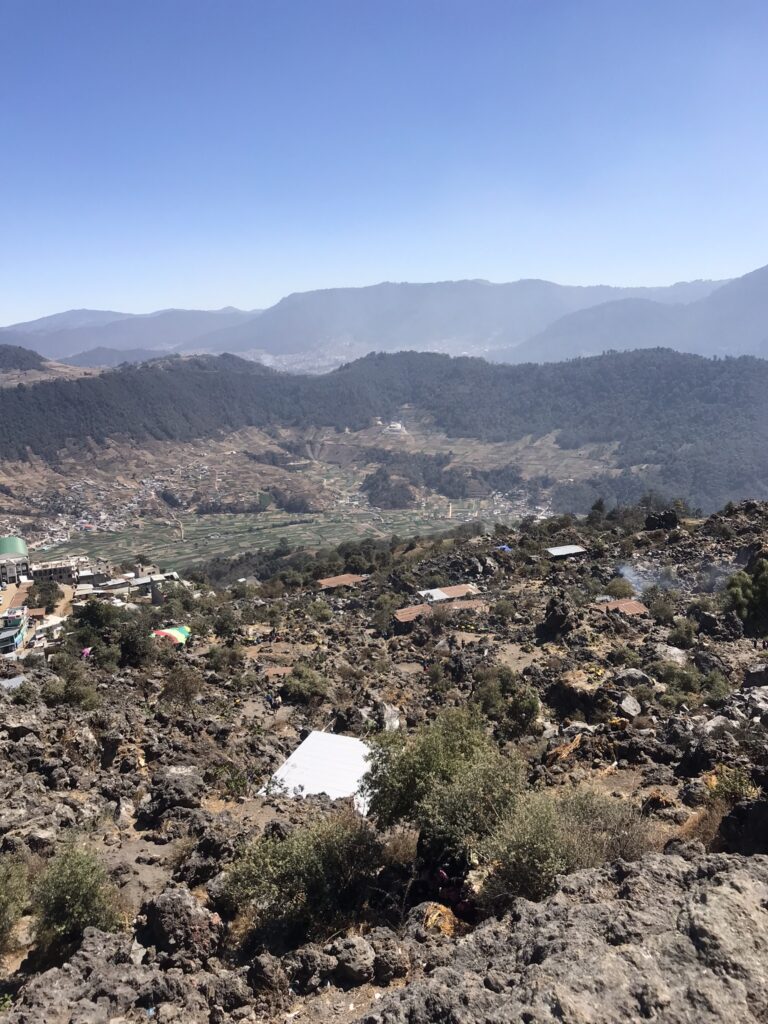
You can’t easily tell but there are rituals taking place all over the mountainside
The mountainside and Cantón Chicuá is very close to Xela, within walking distance of the city centre. We walked the whole way back (mostly downhill) and it was pleasant to see the less-visited outskirts of the city, all the way to the main square in Quetzaltenango.
San Andres Xecul – a small town near Quetzaltenango famous for its iconic, intricate brightly coloured church. Jaguars feature on the facade of the church. The church was closed for entry when we visited but the view from the outside was good enough. We saw the occasional local praying and/or weeping in the square outside of the church.
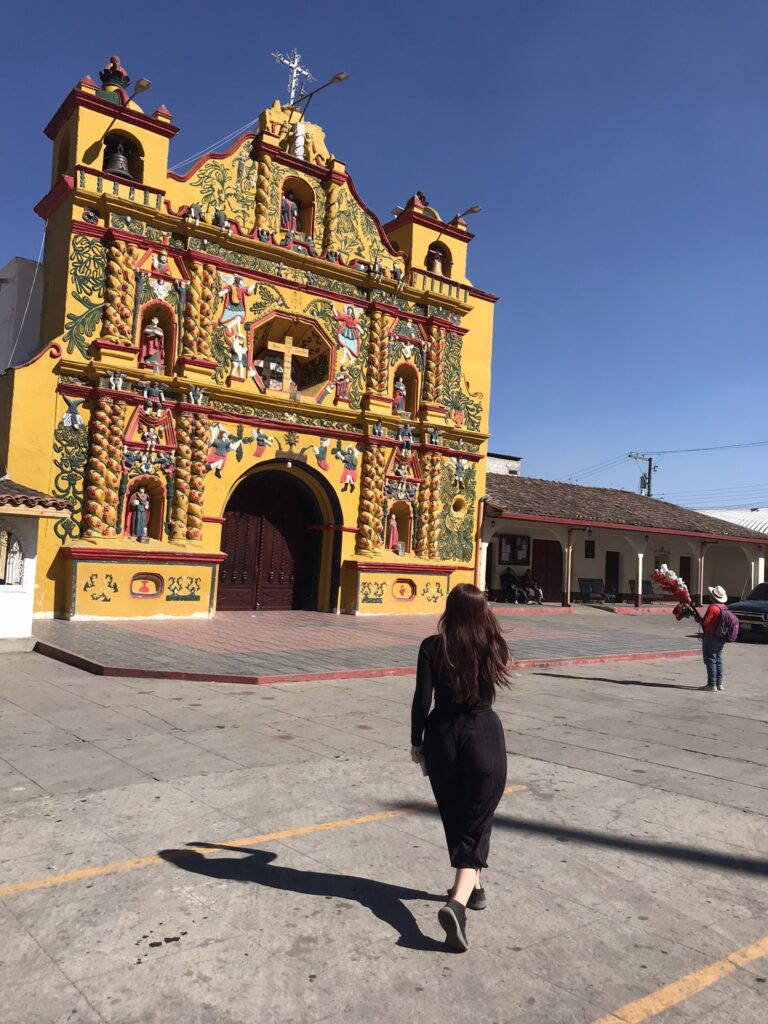
Locals appeared to perform prayers and rituals outside the church even when it was closed
Another interesting place to visit in the town is Iglesia Del Calvario. This tiny, brightly-coloured church is almost like a miniature replica of the larger and more famous church down the hill.
Next to the Iglesia Del Calvario is a shrine which fuses Christianity and Mayan beliefs. Locals burn herbs and incense and pray for indulgences. The women performing the rituals at the shrine allowed us to have a look inside, make sure you ask for permission before you take photos or enter the shrine. It’s definitely different from a traditional church setting.
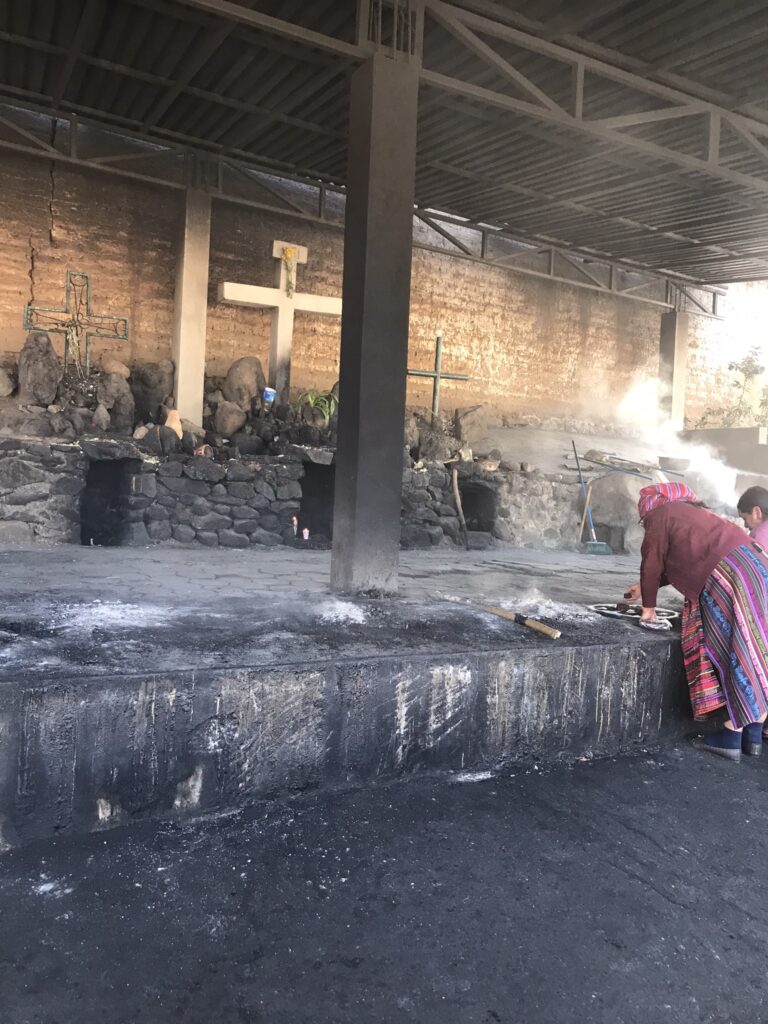
Mayan rituals taking place at the shrine near the Iglesia del Calvario
There’s a viewpoint here (Sendero Pakotzij San Andrés Xecul Totonicapán) but we took a wrong turn and ended up outside a school. The view was still pretty impressive.
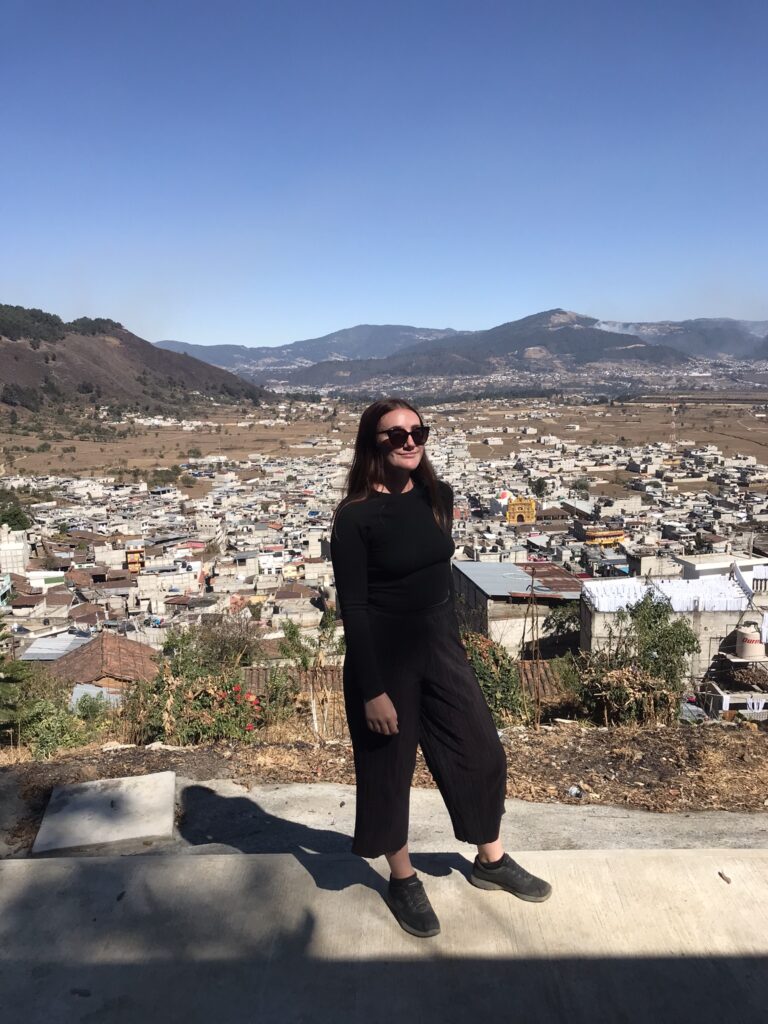
Not the correct viewpoint but a pretty good view nonetheless
There were some women in the village in beautiful traditional costumes and I couldn’t resist taking a photo of them sitting on the pavement.
From Quetzaltenango we took an Uber to Xecul and caught a chicken bus back. The chicken bus in Xecul departs from the main street next to the yellow church. Listen out for the honking of the bus horn as that will alert you to when the bus is departing from the town.
San Pedro la Laguna
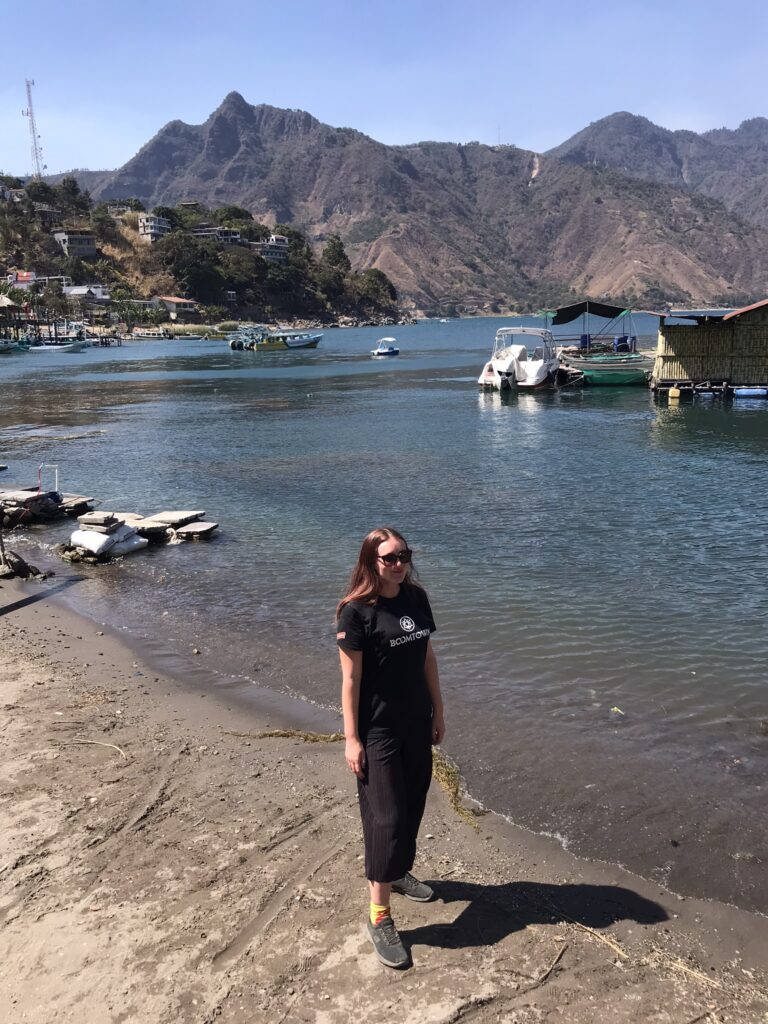
Lake Atitlan is one of the most popular tourist destinations in Guatemala. Surrounded by hills and volcanoes, it is considered one of the most beautiful lakes in the world and is the deepest lake in Central America. Around the lake are a number of small towns. Panajachel is the largest lakeside town and the main transport hub. Other than that, the towns are mostly named after Catholic saints such as San Marcos, San Juan, San Pablo and San Pedro. The indigenous people of the different towns around different parts of the lake speak different languages, all of which are dialects of Mayan.
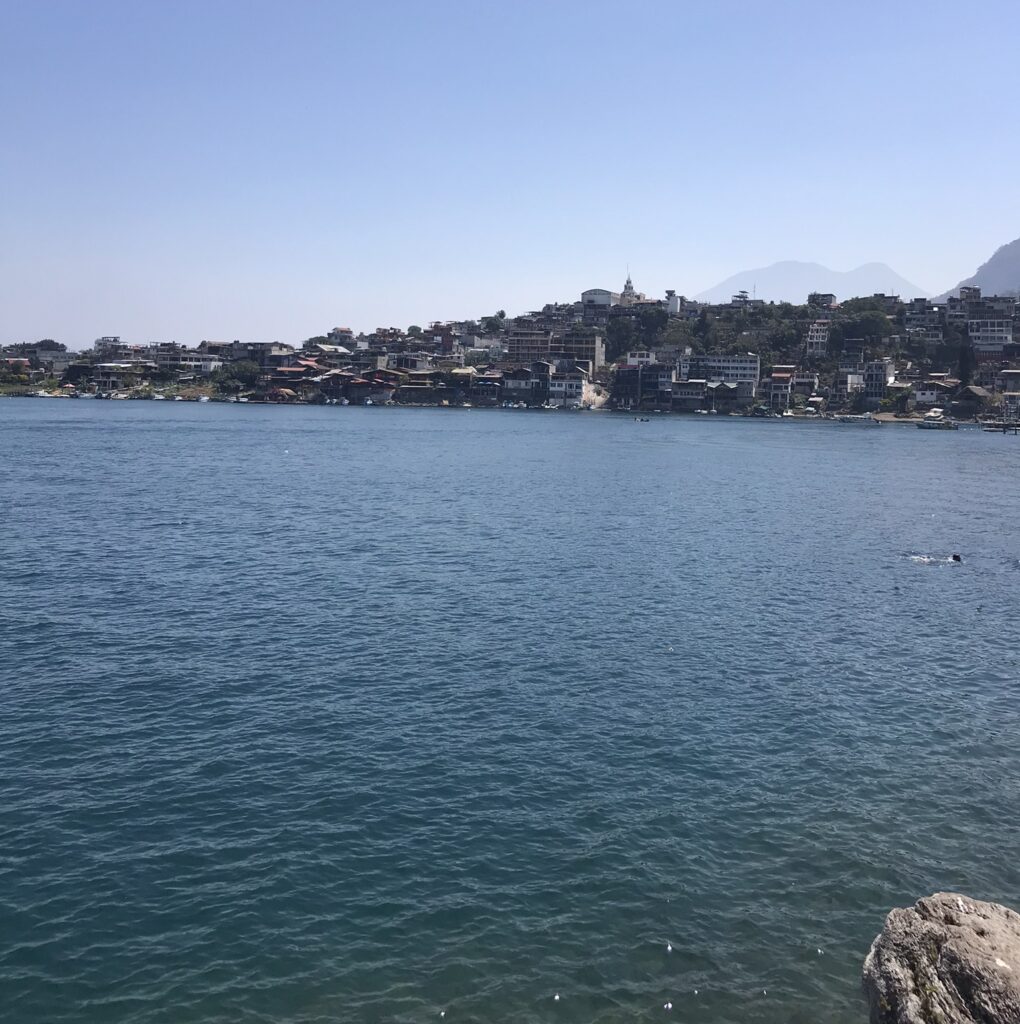
San Pedro is one of the larger settlements on Lake Atitlan
We decided to stay in San Pedro as it was smaller than Panajachel, had a wider range of accommodation and it was closer to the start of the Indian Nose hike. Sadly we found San Pedro to be a very touristy place, especially the strip closest to the water which was full of tuktuks, tour agencies and hustlers trying to squeeze money from tourists. If you go uphill away from the shoreline, you reach the real San Pedro where all the residents live, work and shop.
When we visited San Pedro there was a power outage which lasted for several days. Locals told us that it happens every so often around the lake, and we could see that the power was off in some of the other communities across the lake as well. During the powercuts the town was pitch black and we didn’t have wifi or the ability to charge our phones. One cafe which must’ve had a generator was completely full with tourists charging their phones. Although some of the restaurants were closed during the blackouts, others seemed to be open so were presumably cooking on gas. We enjoyed the candlelit dinner in the restaurant Jakuu while the power was off.
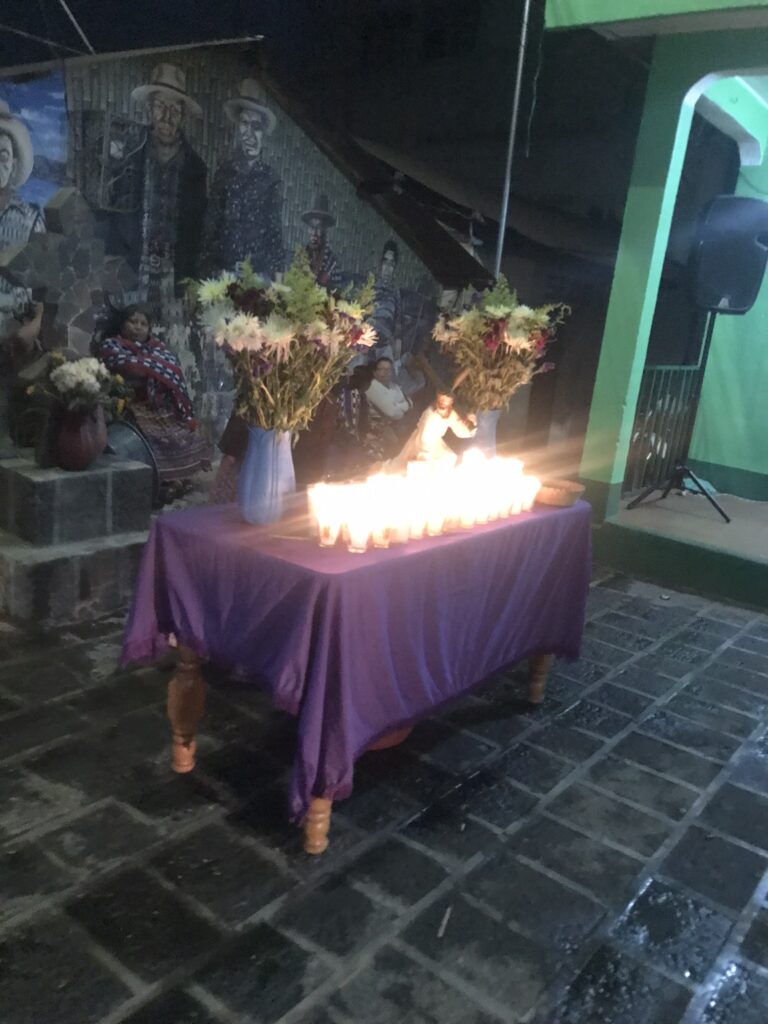
Candlelight in the ‘real’ San Pedro, up the hill and away from the tourist hordes
From San Pedro there is no real walking route around the lake that doesn’t involve going back up into the mountains. To get to other towns around Lake Atitlan you need to use the water taxi. Head to the dock here to get the boat.
There is a direct chicken bus from Xela to San Pedro – we got on it! However most people heading to Lake Atitlan jump on the bus to Panajachel and then get a ferry to San Pedro or one of the other towns around the lake.
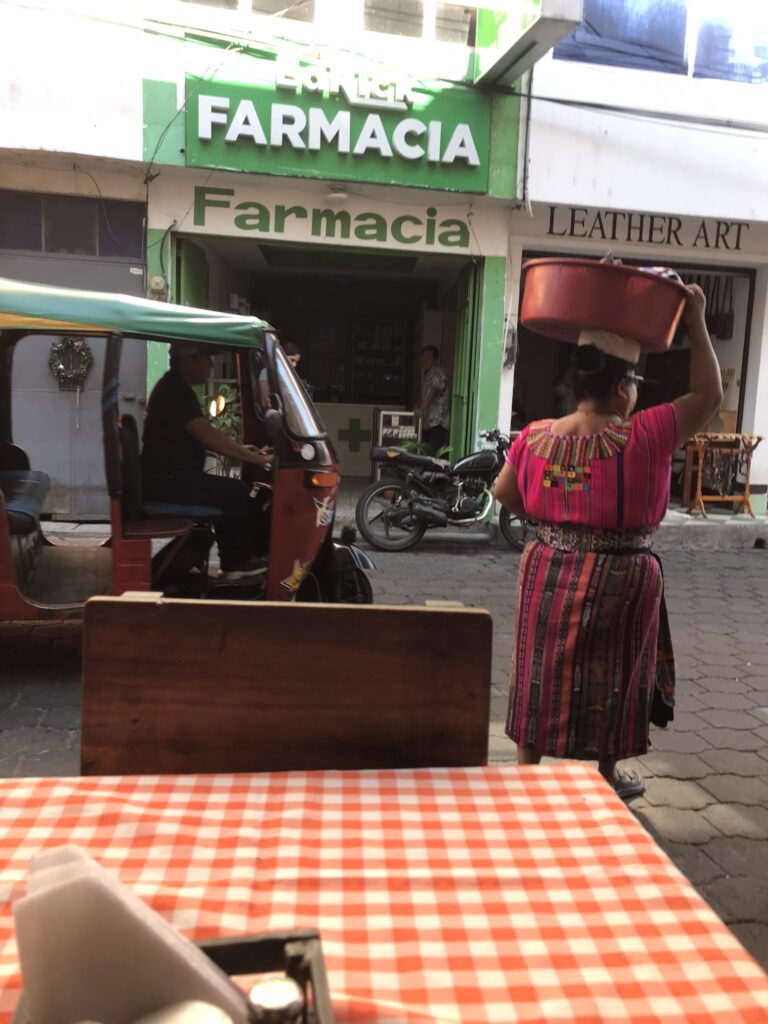
We bought some great banana bread from this lady
Accommodation
Casa Jazmin Airbnb – really nice apartment with a little outside garden. There was a small passageway leading to a secluded lakefront area, we saw locals fishing there. It was a peaceful and serene area away from the crowds.
Foodie Places
Jakuu – a family restaurant, the daughter was doing her homework and brought us the menus before going back to her work which was cute. The owner spoke English and was really friendly. This was one of our favourite restaurants in all of Central America. They serve traditional Guatemalan food like Pepian and Jocon as well as burgers and other comfort food. The burritos were particularly good and absolutely massive, I had burritos two nights in a row. The food quality was excellent and we ate here multiple times.
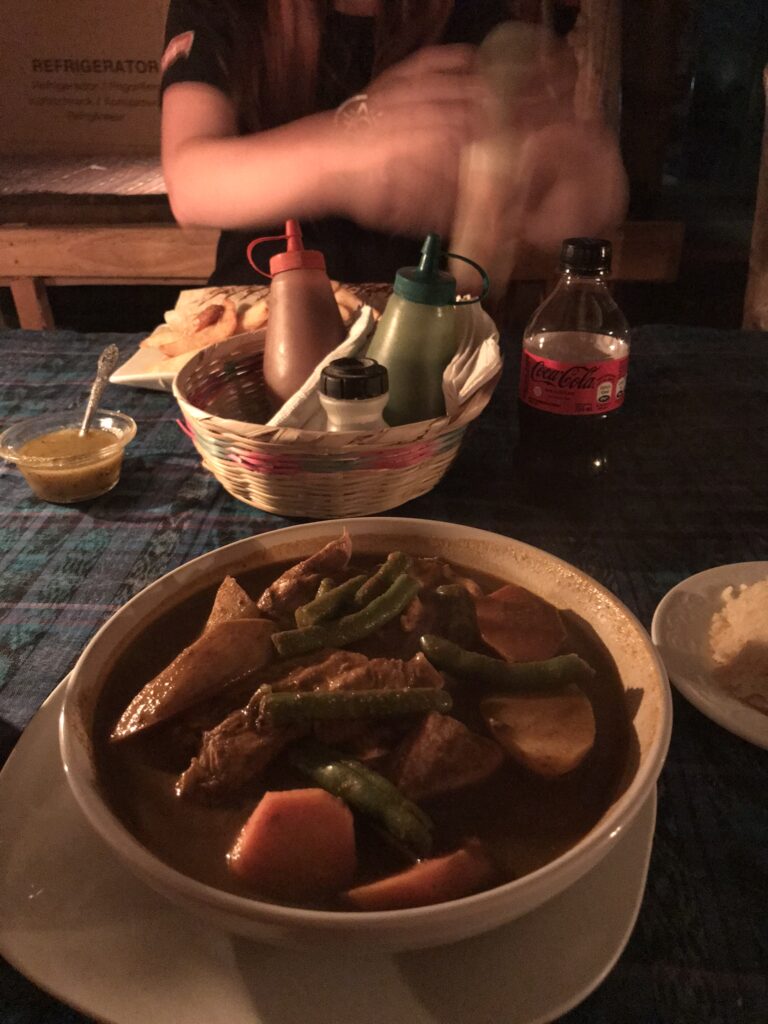
Pepian at Jakuu by candlelight, what a treat
Loles San Pedro – great breakfast deals, a wide selection of options.
Activities
Indian Nose Hike with Benjy Travel – a very early morning start for the sunrise hike. We decided to go with the tour as we had heard there were bandits/extortionists who try to rip off solo visitors without a guide. We waited a while to be picked up outside the tour agency, we actually saw drunk locals and gringos heading back from their nights out while we were waiting!
The trek itself is quite a challenging uphill walk, but we took frequent rest stops. The guide was quite friendly and chatty and was trying to teach us some of the local Mayan language along the way. We enjoyed the complimentary hot chocolate that was provided at the top. Overall it was a positive experience with the tour.
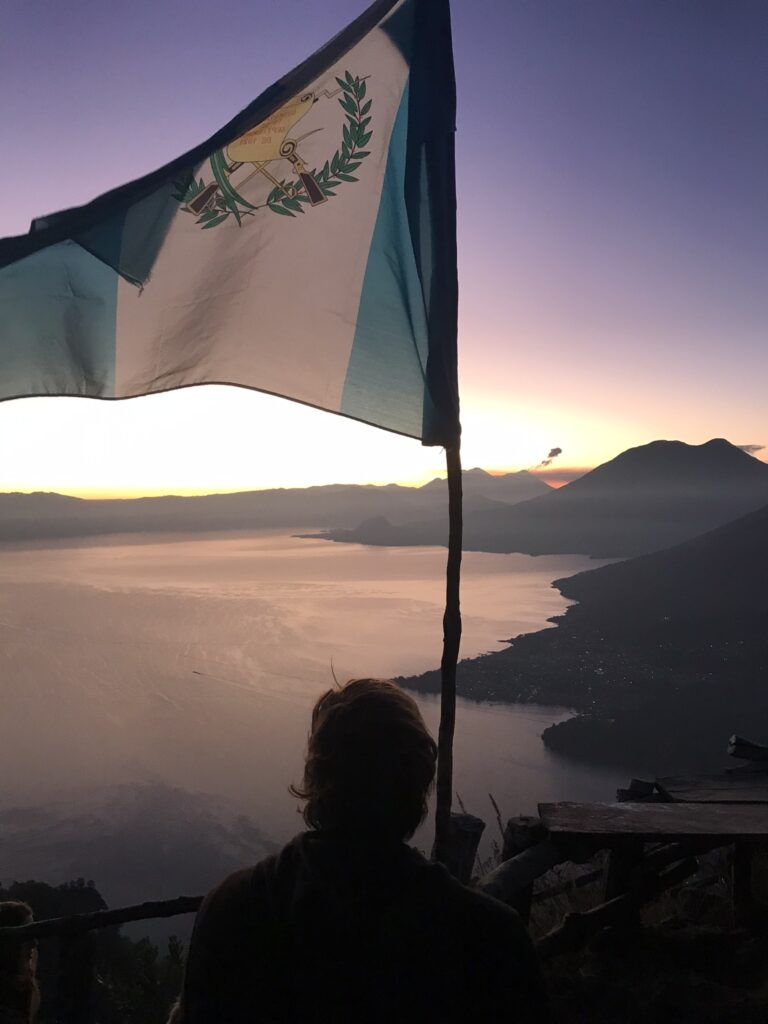
As it is a sunrise trek, the climb up to the Indian Nose is in more or less complete darkness. We had to use our phones as flashlights, so it is probably better to bring a headtorch if you have one. Also make sure you wear correct footwear as someone in the group was trying to do the trek in sandals and struggling.
It was very busy at the top with multiple tour groups. There are lots of good viewpoints but you still have to arrive early to be able to get a seat, it wasn’t always easy to take a photo due to the crowds jostling to take pictures.
It was nice to watch the sunrise over the lake, you could see Fuego volcano smoking in the background and several other volcanoes too. Strangely there were dogs at the top. Toilet facilities on the way back were very basic, don’t drink two cups of hot chocolate like me!
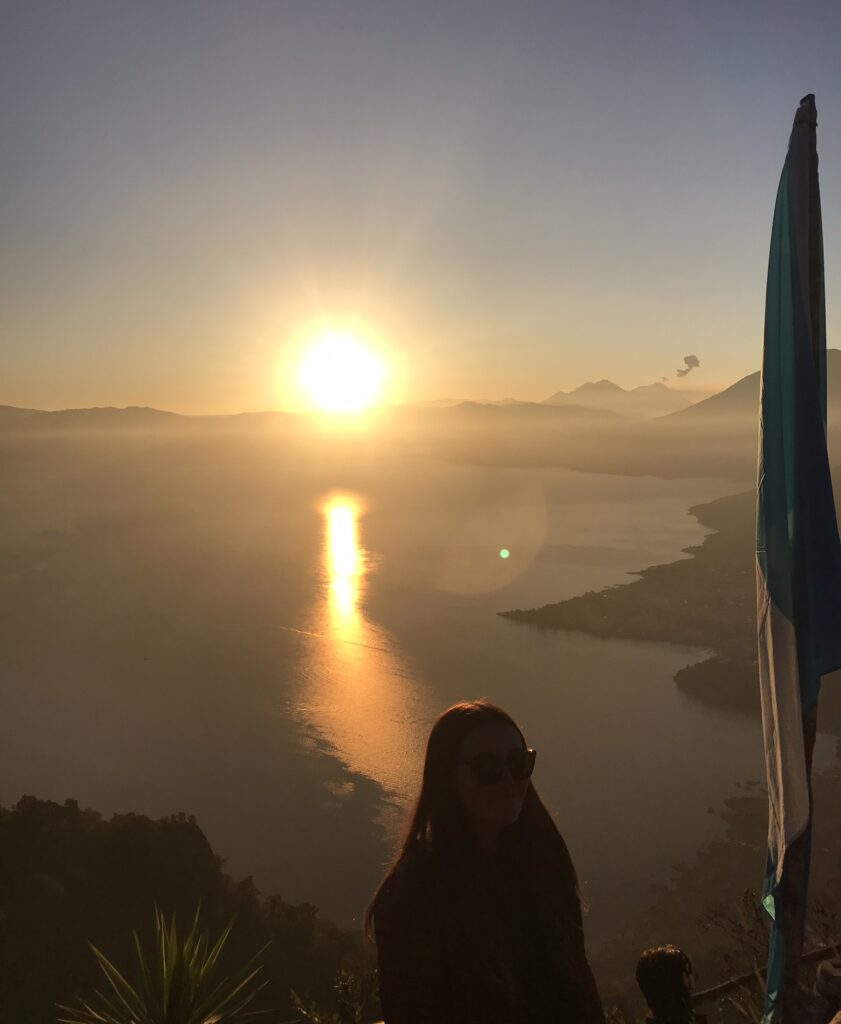
Pretty magical I guess
Trip to San Marcos – we tried to walk to San Marcos but there was no clear route along the shoreline, we scrambled over rocks and ended up sitting on a platform overlooking the lake halfway to San Juan. In the end we headed back to San Pedro and got the boat to San Marcos.
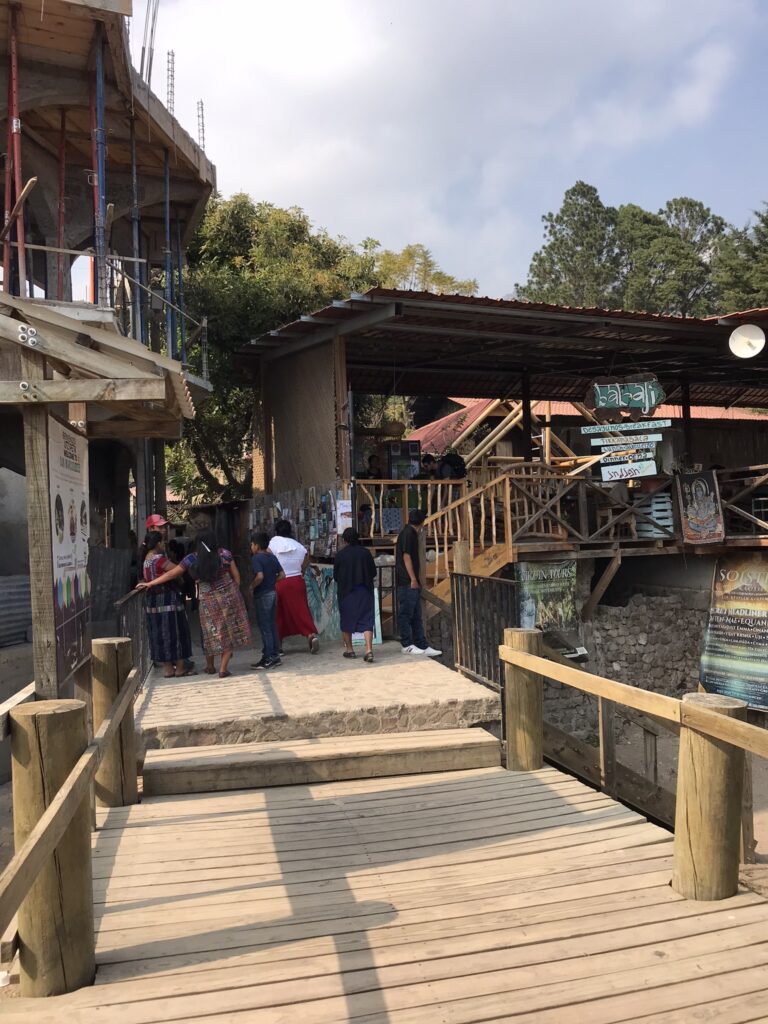
Scenes from San Marcos
San Marcos is known for its hippie community and this was definitely evident just from walking around. There were lots of vegan cafes, yoga and hippie places. We went to Moonshine Cafe and had an ok lunch, although it was a little expensive. We tried to go to a lake viewpoint (Mirador de San Marcos) but some guys tried to make us pay for entry so we didn’t bother. There is also a cliff jump at the mirador. We heard a couple of first-hand horror stories about gringos getting seriously injured and/or knocking themselves unconscious doing the jump.
In between the mirador area and the main pier there is a smaller disused pier where you can sit and look across the water. We spent most of our time there.
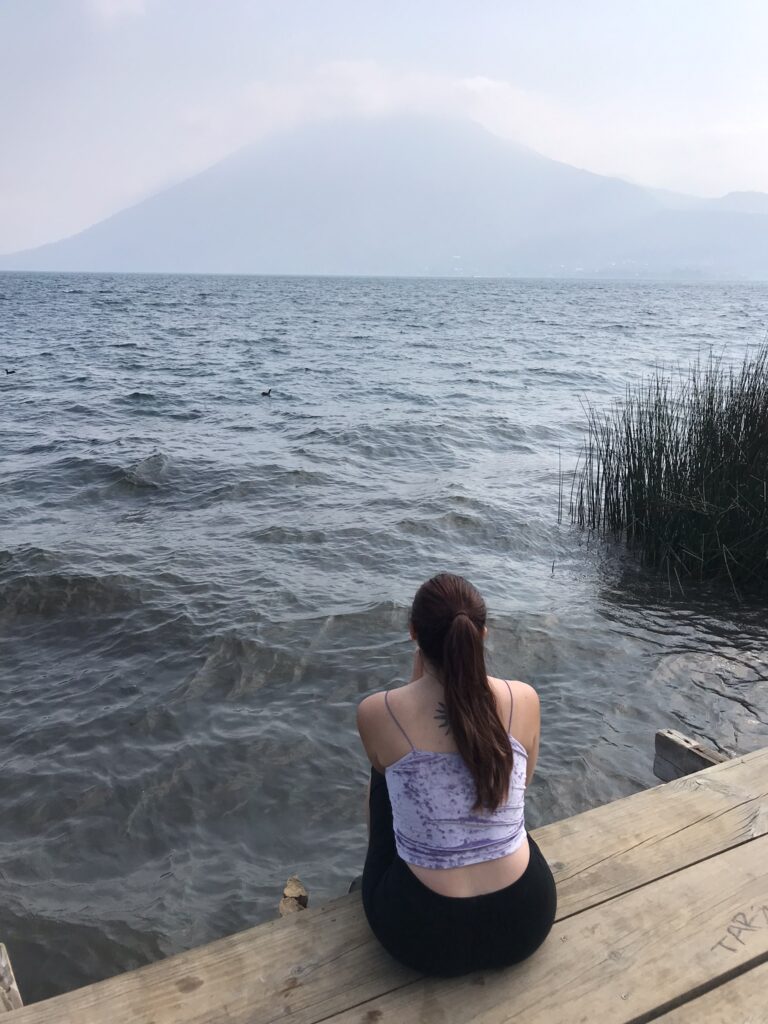
Sittin’ on the dock of the bay in San Marcos
Antigua
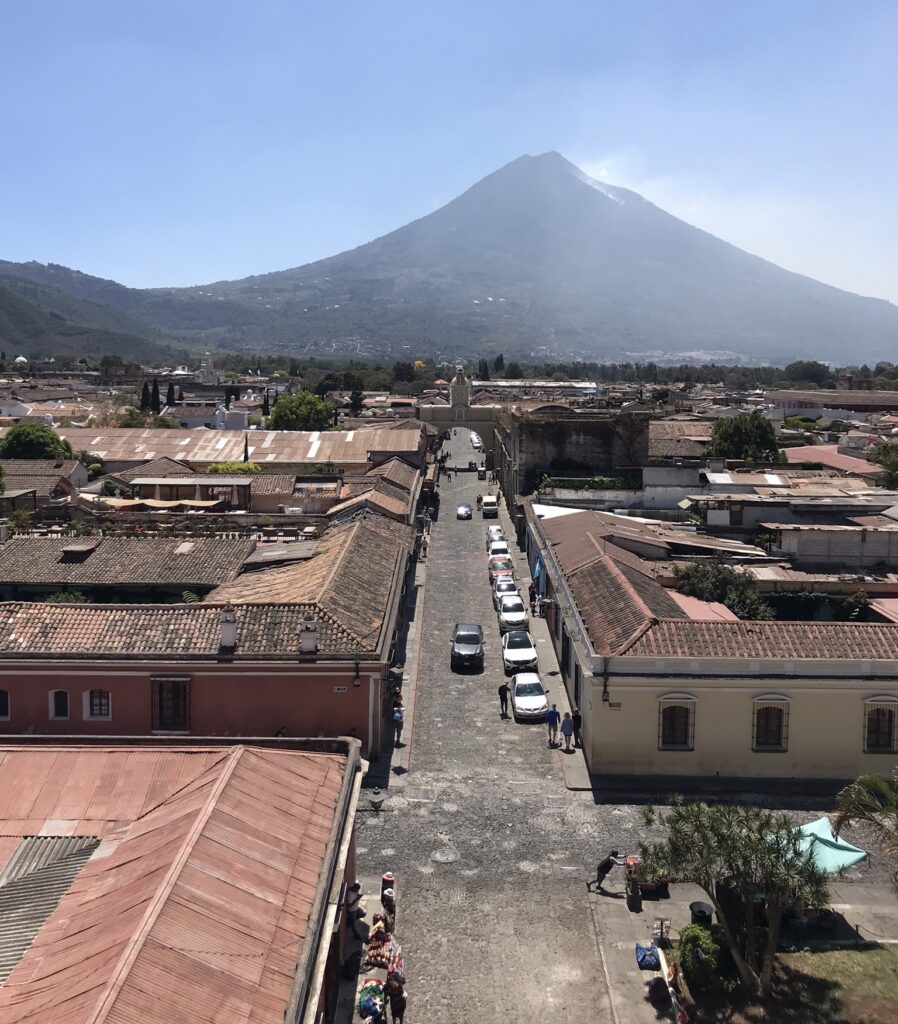
Antigua is the former capital city of Guatemala. This colonial jewel is surrounded by volcanoes. If you search for images of Guatemala online, most photos you find will have probably been taken in Antigua. It’s the most picturesque and European city within Guatemala with striking colonial architecture and an air of a bygone age.
The city was originally known as Santiago de los Caballeros de Guatemala and served as the capital of the Spanish Captaincy General, which governed most of Central America. Due to numerous earthquakes and volcanic eruptions, the Spanish decided to move the capital to the modern location of Guatemala City in the late 1700s. At that point, the old city became known as Antigua Guatemala meaning ‘Old Guatemala’, to differentiate it from the new capital. Antigua was abandoned by the Spanish and most of the population left, meaning the city is still relatively small today. With its history and UNESCO-listed colonial buildings, in recent years it has become a cultural and tourism hub and a mecca for international travellers and expats in search of something different.
Antigua is surrounded by volcanoes. Whenever you are in the city the Agua volcano looms large in the background, while nearby Fuego volcano with its constant gaseous eruptions is a major draw for adventure tourists.
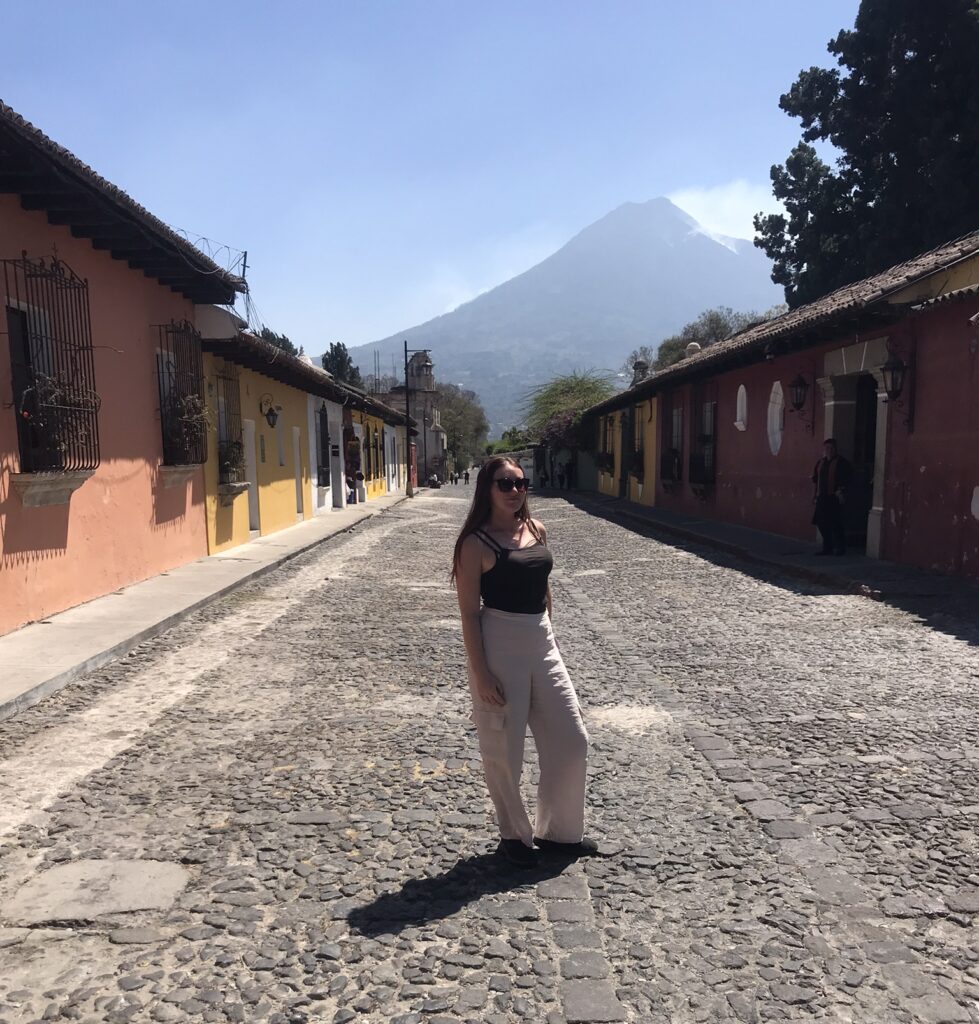
Virtually every street in Antigua looks like this
Accommodation
Posada Maya – on the outskirts of town, this quiet/homely place is inexpensive and away from the hustle and bustle of the city centre. It’s close to the market and has a small shared kitchen and roof terrace to cook up your own meals. It’s not a large establishment with only around 8 rooms. We opted for the cheapest room and it was quite small however for the price we couldn’t complain. Cheap accommodation is hard to come by in the centre of Antigua due to the high demand. It’s about a 10 minute walk to the city centre from this hotel which wasn’t too bad.
Foodie Places
Rincón antigüeño – favoured by locals and tourists alike, this no-nonsense eatery serves up around 5 dishes, mostly the same everyday along with daily specials. It’s only open for lunch so make sure you get there before it closes. We particularly liked the jocón and the chorizo sausages with salad and pasta. It’s an inexpensive place to grab lunch and all dishes come with a juice drink of the day and free refills. You have to order at the counter so don’t sit down and expect a waiter to come and take your order. The rotisserie chicken is also a good option here, you can sit and watch a man slowly rotating the chickens in the courtyard seating area.
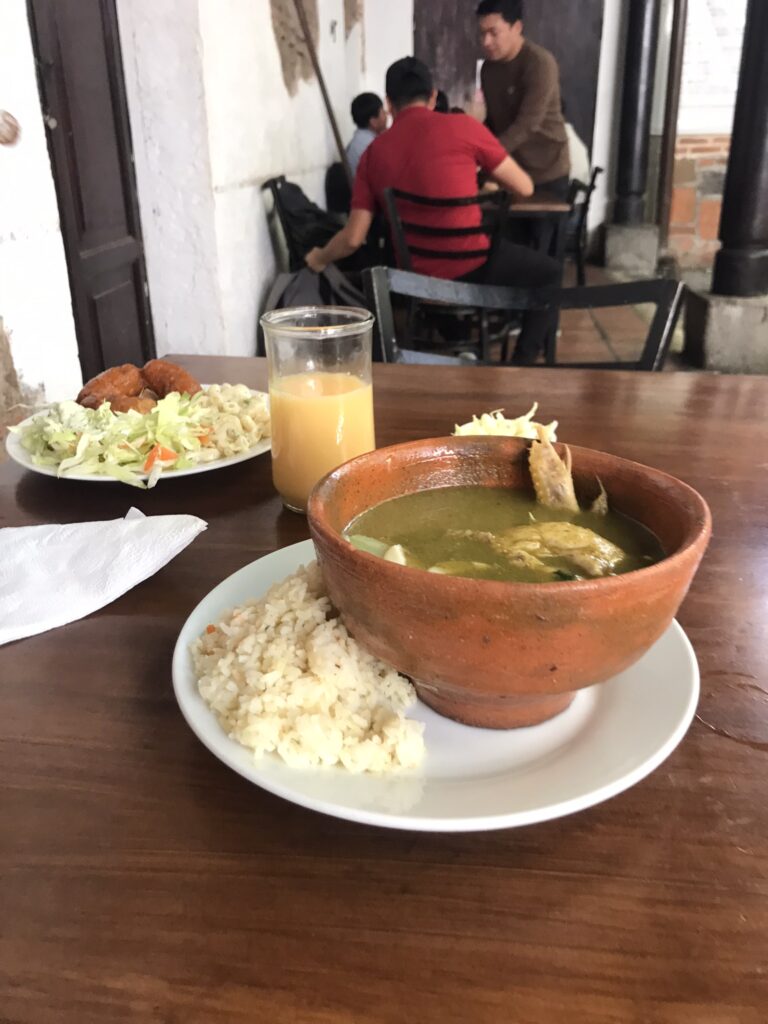
Jocón at the Rincón, definitely one of the most authentic and best value places to get lunch in Antigua
Pollo Campero (Calle del Arco) – Pollo Campero is our favourite fast food chain in Guatemala (and we also spotted a couple of branches in El Salvador). It’s similar to KFC with a heavy emphasis on chicken consumption. I particularly liked the fact you could order a side of mashed potatoes topped in gravy. You can also choose which sauce and coating you want with your chicken. There is an option to eat in or takeaway. Overall a good place if you’re craving unhealthy fast food.
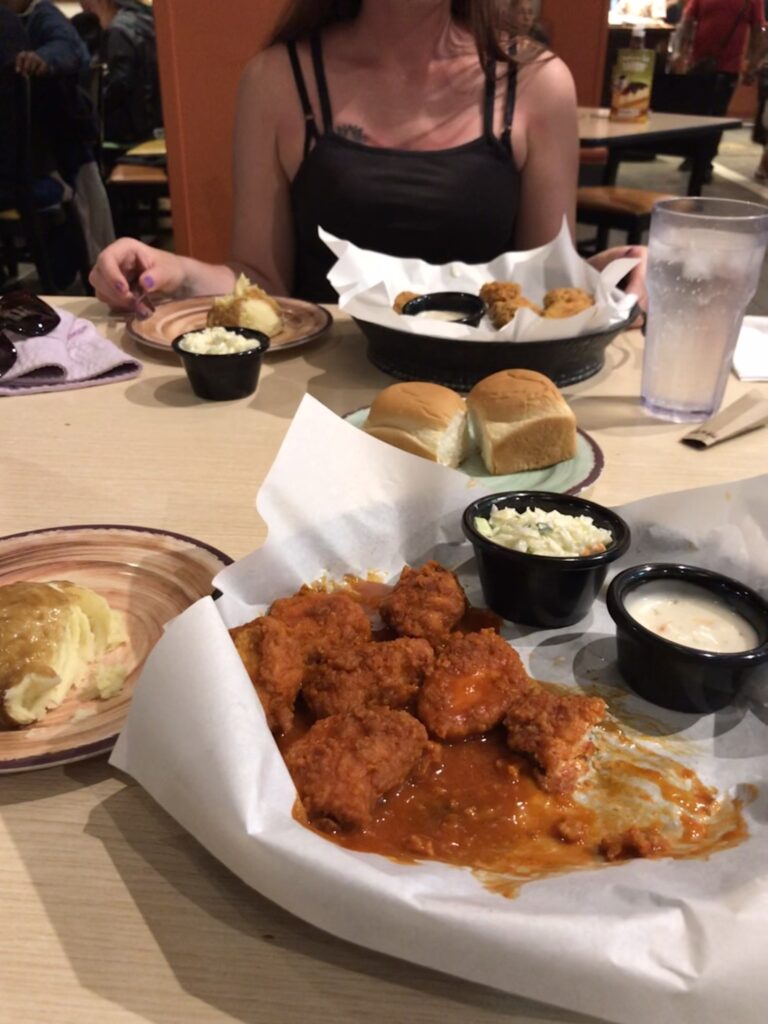
Pollo Campero – it is what it is
Activities
Guruwalk city walking tour including stops at the Cathedral, Museo de Arte Colonial (set in the oldest university in Guatemala), Arco de Santa Catalina (the iconic lemon-coloured archway which has become a symbol of the city, used by nuns to cross the street from the church to the convent to avoid outside human interaction. If you only take one photo in Antigua, this will be it), Tanque La Unión (a place used by locals to wash their clothes in the city centre) and the pedestrianised street 5A Avenida Norte (‘the’ place to shop and dine in Antigua)
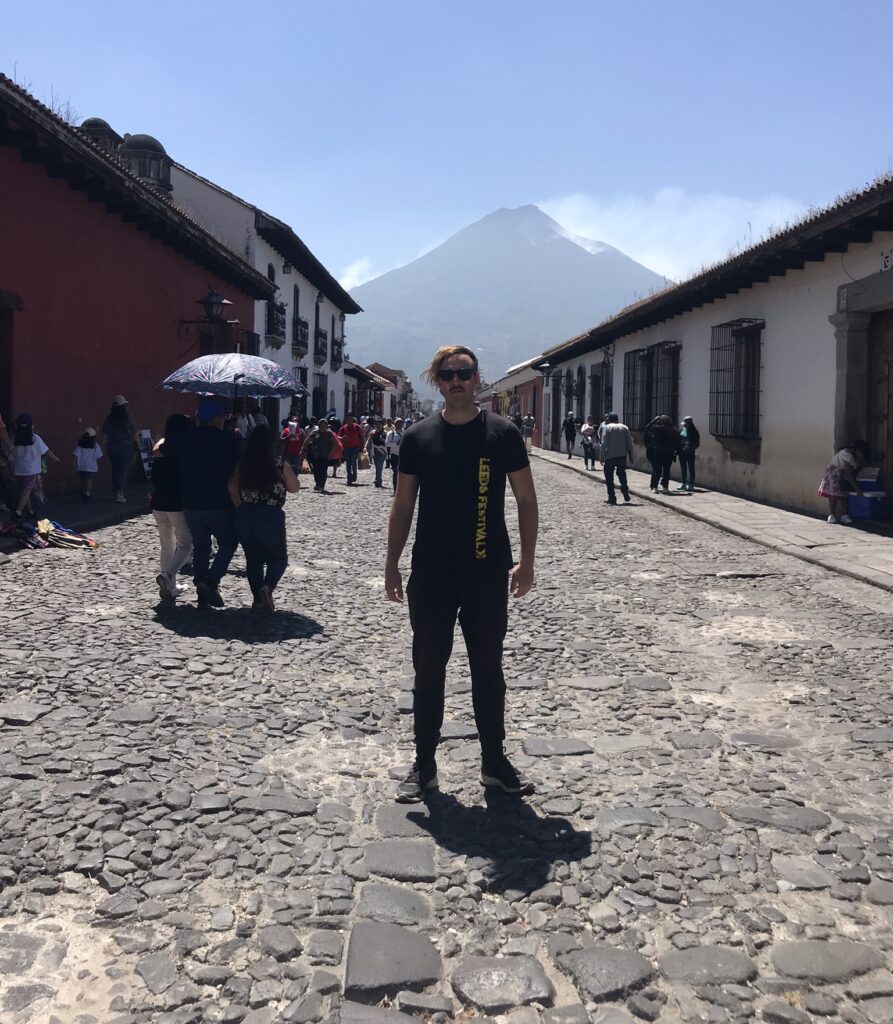
5a Avenida Norte is literally where the action is as it’s almost always busy
Iglesia de la Merced – make a beeline straight for the roof to enjoy the best views of Antigua from above. You can see the 5A Avenida Norte and Arco de Santa Catalina from the rooftop alongside the ever-present Agua volcano towering over the city. In the atrium is a large courtyard area with some strange mannequins. The bells housed in the bell-tower are pretty interesting too. Avoid the crowds by visiting this church on a weekday as it can be quite busy at weekends. The outside of the church is also very cool with its intricate patterned design.
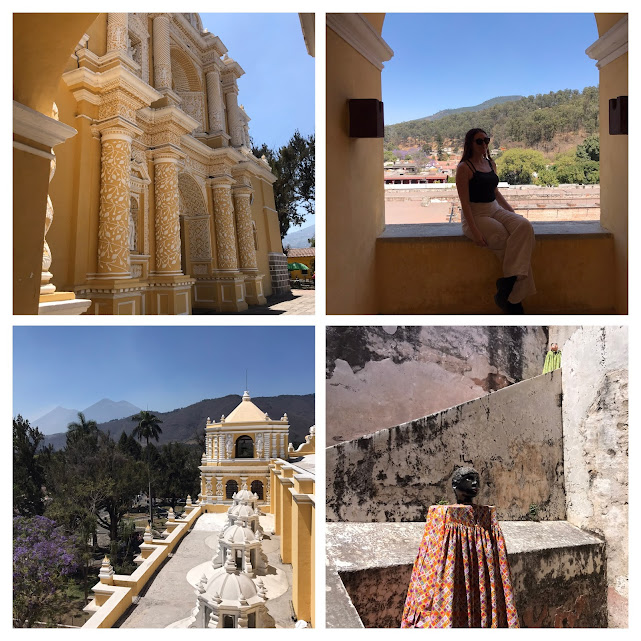
The mannequins were really weird, I’m not sure why they were there
Ruinas de La Antigua Catedral Metropolitana de Santiago de Los Caballeros de Guatemala – the ruins of the original 16th century Cathedral which was destroyed by an earthquake in 1773. This was probably the final straw for the Spanish as they moved the capital city shortly afterwards. It was interesting to see architectural remains of the original arches and domes, the place conveyed a feeling of vastness and awe. You can still see some of the decorations on the columns and walls which time has yet to destroy. Head down the stairs to the crypt for a spooky experience.
Royal Palace of the Captain General/MUNAG Museo Nacional de Arte de Guatemala – free entry, some interesting art exhibitions including modern art, antique religious iconography and some pre-Columbian pieces on display. This museum is located in the former governor’s palace and midway through the visit you can relax on the balcony overlooking Central Park, a great spot for people watching without the hassle of actually being in the public park.
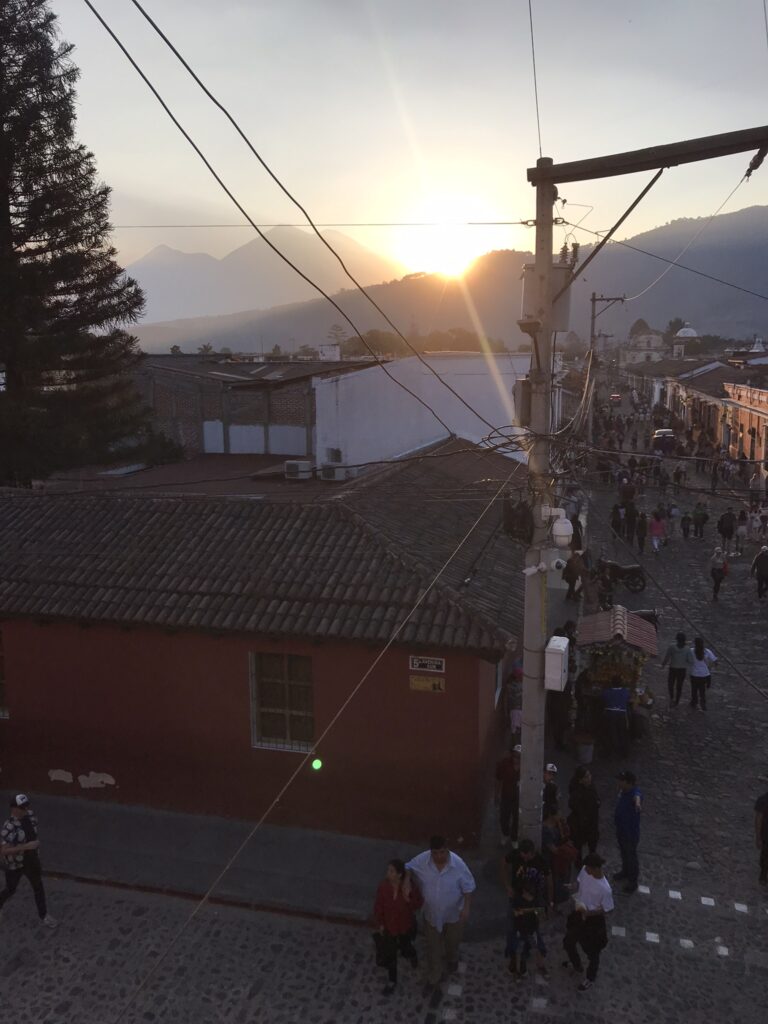
The view from the balcony of the Palace of the Captain General, which houses the MUNAG
Hobbitenango – a homage to Lord of the Rings nestled in the rolling green hills over Antigua. This attraction is a must-see for any fans of Tolkien. It’s obvious a lot of effort has been put into creating this fantastical park complete with handcrafted hobbit holes, manicured meandering paths, quirky viewpoints (including the massive hand extending over the valley) and fun activities such as the giant swing and mini-golf. There’s a restaurant onsite and a couple of food vendors selling ice-cream, choco-bananas and other treats. We even spotted a cocktail bar! Overall a wacky way to spend a morning or afternoon, we spent about 2 hours looking around and eventually ended up sunbathing on the grass and enjoying the majestic mountain views.
It’s possible to stay overnight in some of the hobbit holes, as a huge LOTR fan I even considered skipping the Acatenango volcano hike to stay there. Some of the hobbit holes are private and you can only access those areas if you’ve got a booking.
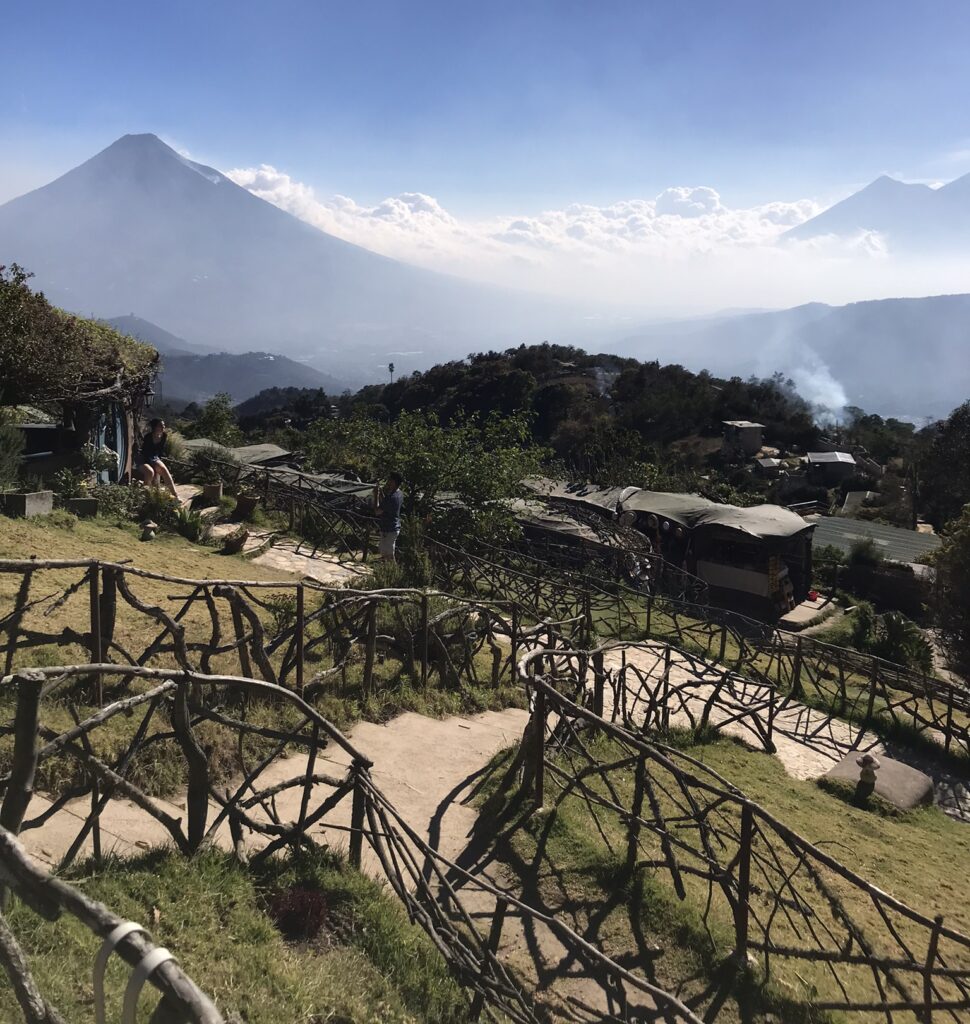
You can enter some of the hobbit houses while others are rented out for overnight stays
Head to the Hobbitenango office here to organise transport from Antigua, it’s an additional cost but well worth it. I’d highly recommend against getting a taxi or attempting to drive there yourself, the roads are very hairy close to the park with tight hairpin bends and really steep inclines. You really need a 4×4 and professional driving skills to be able to navigate these roads.
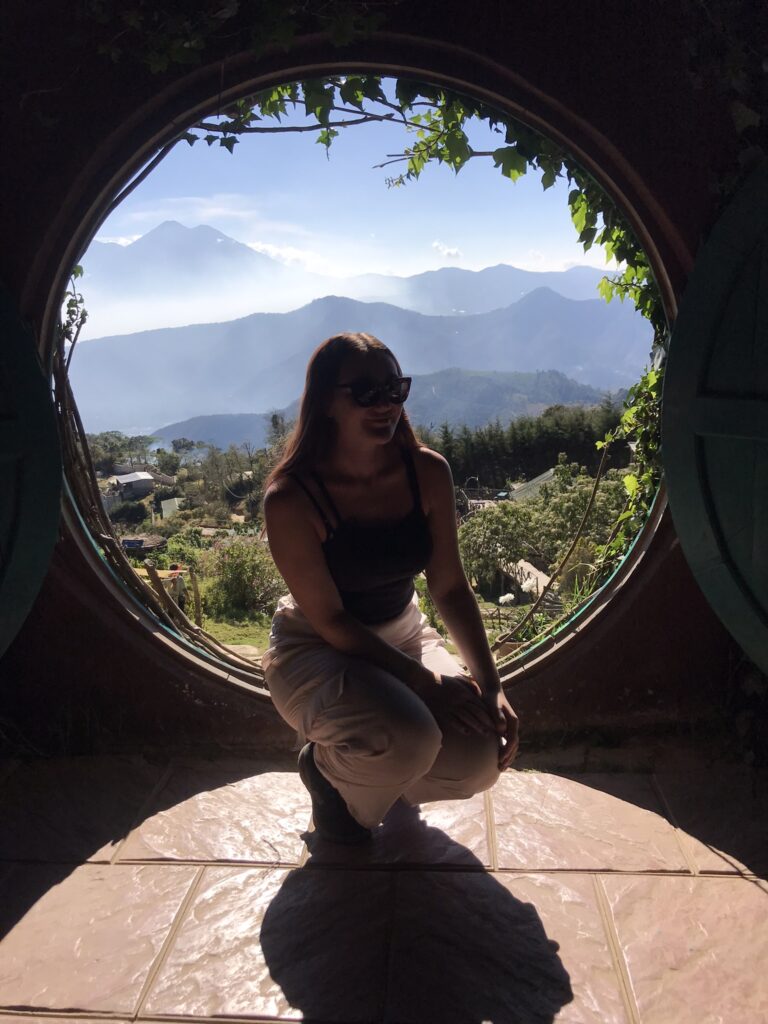
Happy in a hobbit hole
Cerro de la Cruz – a moderate hike to an impressive viewpoint over the city. It gets its name from a huge cross on the hill. There are some vendors further up from the cross selling coconuts, cocktails, beer and other street food snacks. It’s a nice place to hang out with friends.
Easter celebrations – parade and sand murals. We happened to visit Antigua in the lead up to Easter. This is a huge deal in Guatemala and particularly in Antigua. During the lent period there is a ritualistic parade in the city every Sunday. We’re told that to take part in the parade is a right of passage for any young Antiguan.
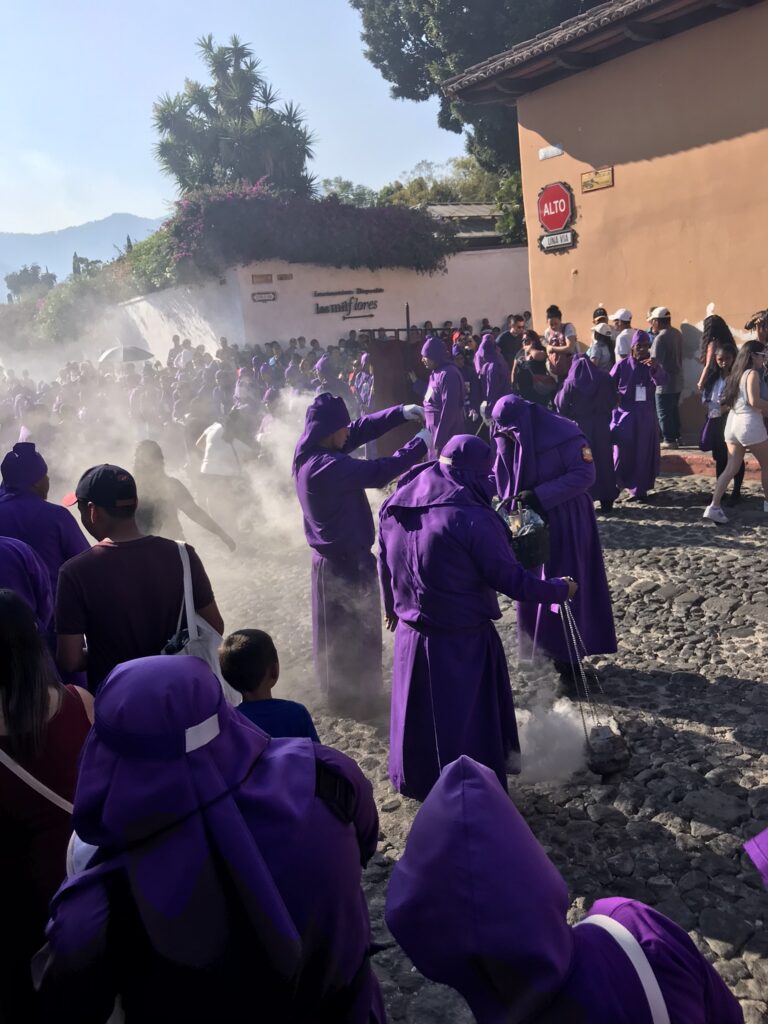
There was a buzz around the city as celebrations were getting underway. We waited with anticipation to watch the parade pass through the streets of Antigua, with men and boys dressed in vibrant purple capes, swinging incense, marching to the sound of sombre music or carrying the image of the Virgin Mary on their shoulders on large floats. The parade was massive, though we’re told it’s even bigger on Easter Sunday and that the city is crammed with Guatemalan tourists during the Easter weekend.
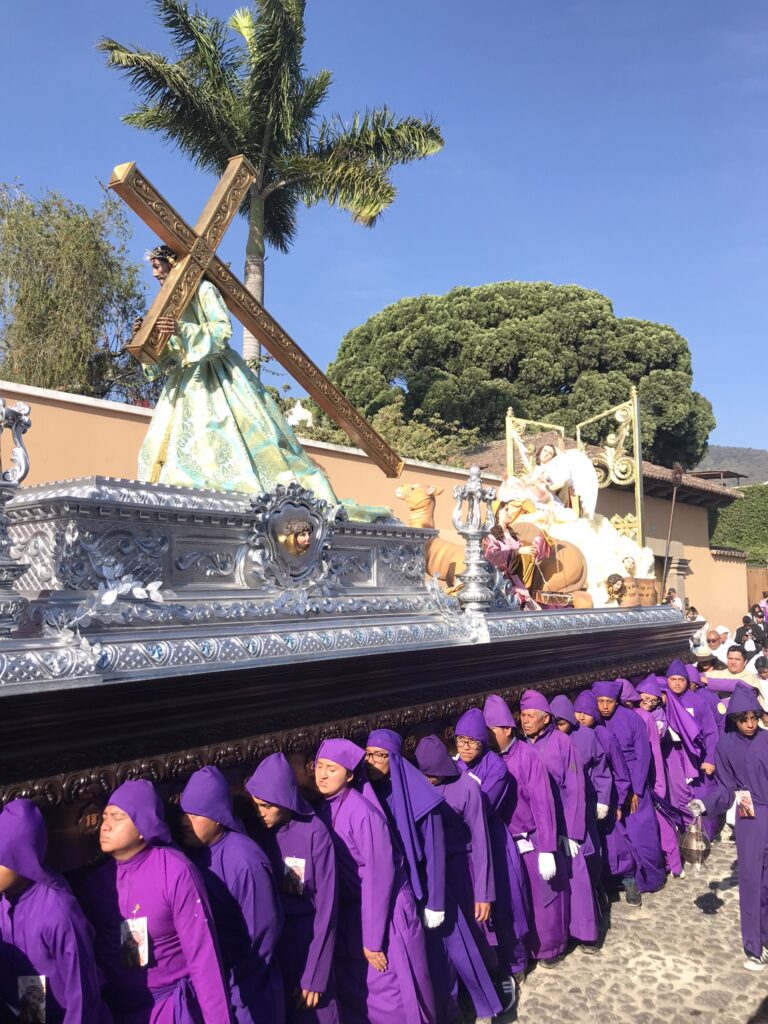
The parade is a true spectacle
As part of the celebrations, groups of people create intricate murals on the ground in the street using coloured sand, pine branches and flowers. The congregation then walks over the murals as they proceed through the street. Before the parade, the streets were filled with hawkers selling items such as religious trinkets, black veils (for women), ice cream, toys, popcorn and other treats. The smell of incense is overpowering and creates a mystical haze over the parade.
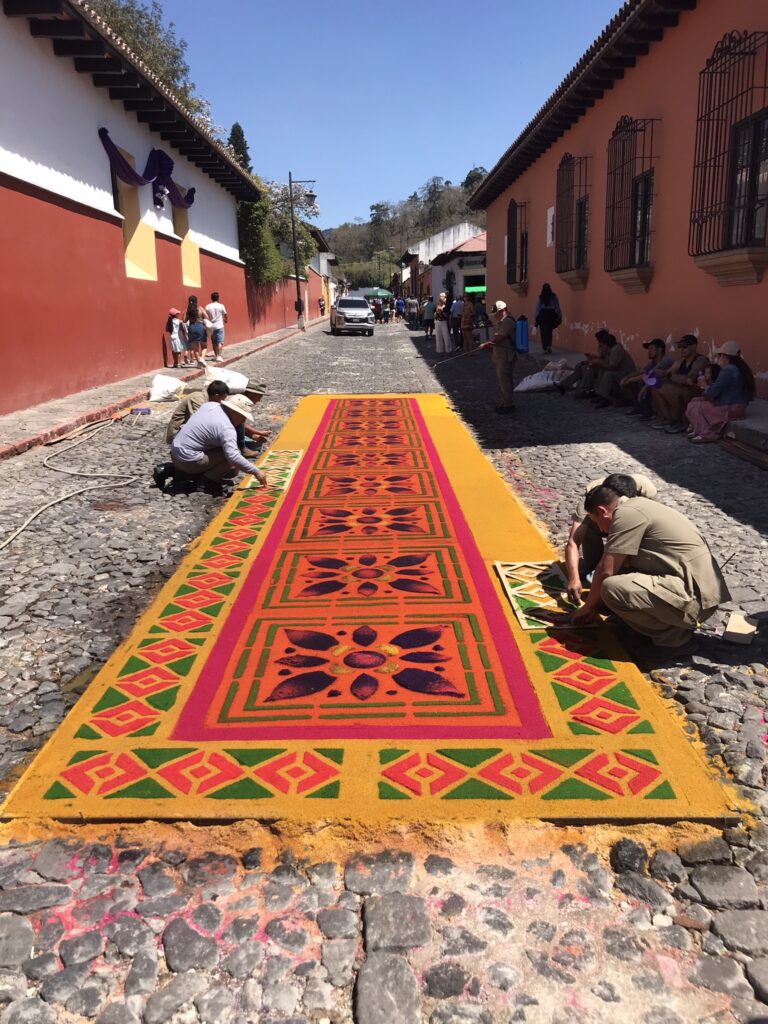
Locals work on patterned designs before the parade
Women in the parade dress head to toe in black (I presume as a sign of mourning) and also take turns carrying the religious icons. The procession literally takes all day, we caught a glimpse of it around midday and later again when it was dark. Interestingly we saw that some of the men were tasked with used poles to stop the floats catching on low-lying electricity lines.
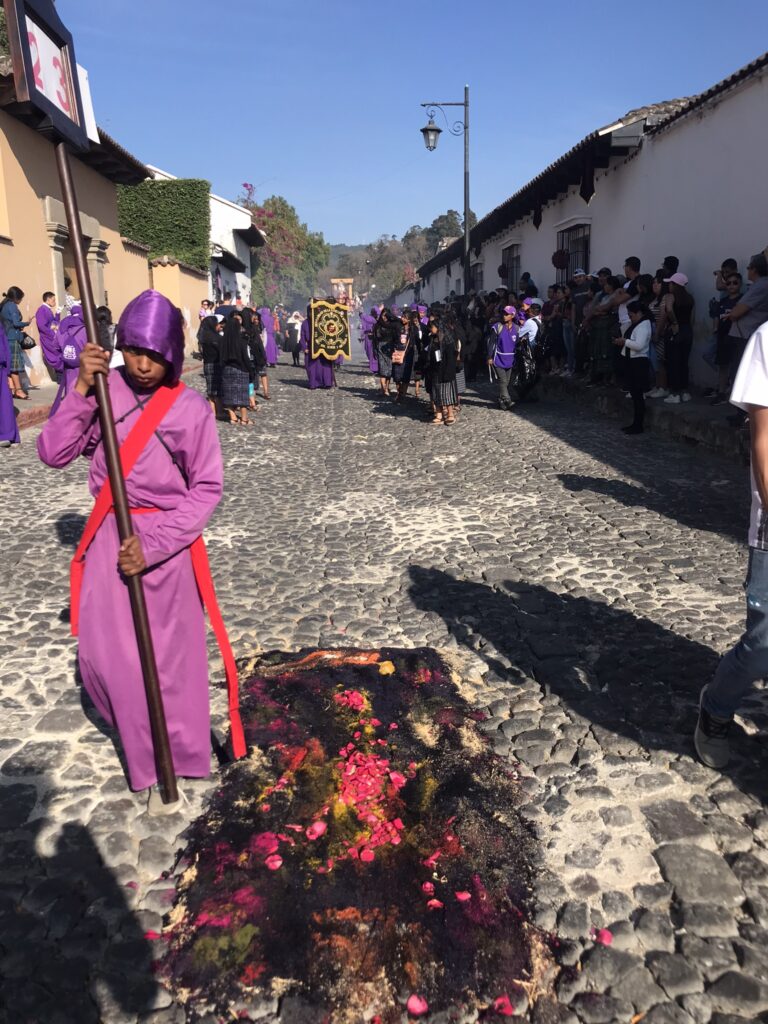
Acatenango Overnight Volcano Hike with Soy Tours – the Acatenango hike is one of the most popular activities in Guatemala. Demand is high, so it is best to book in advance. We met people in Belize who had taken a 2 week detour from their Guatemala trip because they were waiting to do the Acatenango hike!
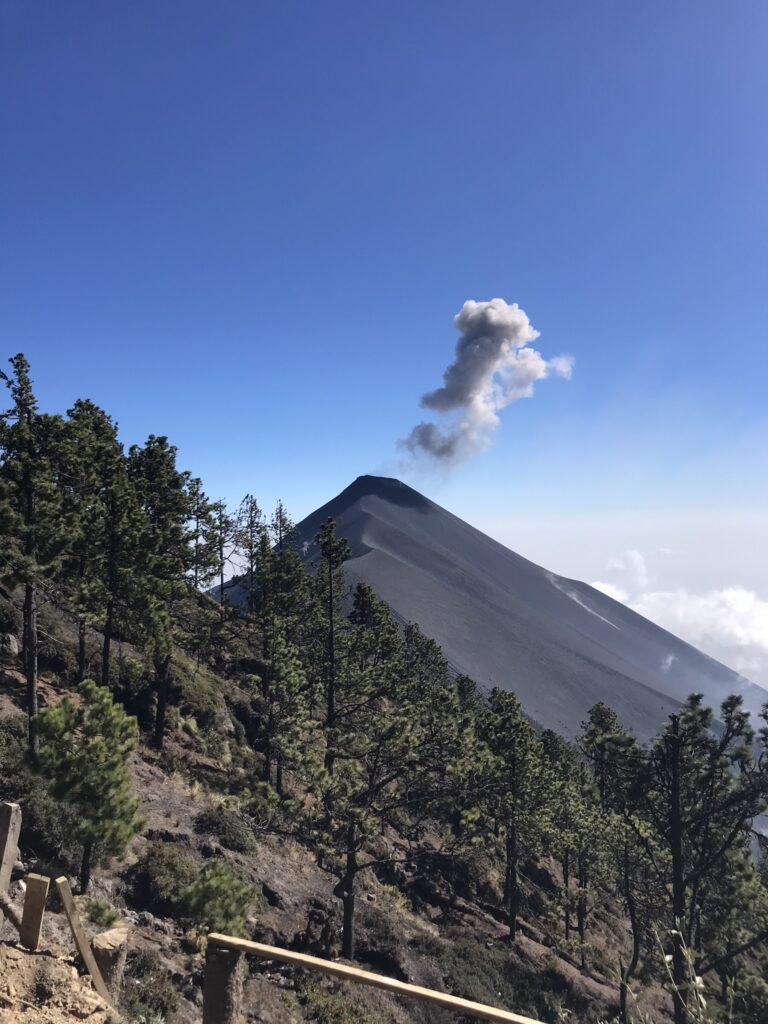
The view from our base camp near the summit
There are several companies offering the hike, we went with Soy Tours who had availability at a few weeks notice and were highly rated at a decent price. The company office in Antigua was absolutely terrible with a useless and uninterested staff member who pretended not to be able to speak English and made a blunder with our pickup location despite us going into the office to personally confirm the details were all correct, however other than that the operation of the tour company was pretty good. The hike was quite a large group (around 30 people) and operated as a well-oiled machine. There were slight price increases from what was advertised in their brochure i.e. to hire a stick, however they were accommodating and it’s possible to hire a backpack, stick and guy to carry your backpack to the top for an affordable price. We opted to pay for a backpack carrier to make life easier, it was only around £20 for one way. There’s no need to pay for this service on the way down as obviously the hike is much easier. The backpack carrier guy was very nice and made conversation. He constantly checked if we were okay, walked with us and asked if we needed anything from the bag. Overall the service was well worth it.
The price of the tour included rental of gloves, hat, socks, thermal trousers and a worn coat, these are all second-hand so don’t expect really nice accessories. We were very impressed with the food provided by Soy Tours during the trek. The packed lunch consisted of chicken and rice with a banana and juice, a tasty and filling meal. Noodles and mashed potato for dinner was a really hearty evening meal which was much needed after the climb. The hot chocolate mixed with some sort of alcohol was nice too. We enjoyed the camaraderie of the guides and the group.
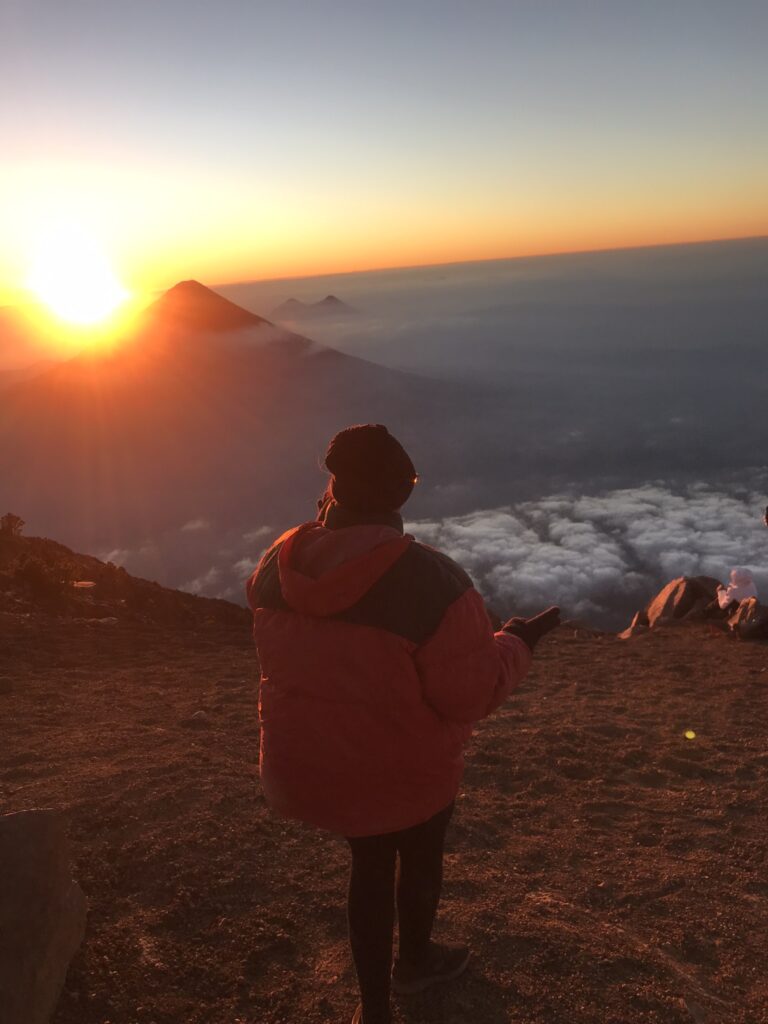
The warm jacket was definitely appreciated even if it wasn’t the most stylish
The trek itself is very difficult. It is basically 6 hours of solid uphill trekking, gaining around 1,200 metres from a starting altitude of over 2,500 metres. You must make sure to acclimatise to the altitude before taking the trek. We personally witnessed three English guys who had just flown in boasting about how they’d been preparing for 2 years to do this hike, only to be quickly overcome with the altitude, lag behind and barely make it to the top, hours after the rest of the group. At one point we even saw one guy from this group at the summit with obvious altitude sickness, dazed and stumbling around without a shirt on when it was quite chilly at the top.
The ground conditions make the trek even more difficult. The ground is essentially very loose volcanic shale. You sometimes take two steps up and one back because of the loose ground conditions. The first hour of the hike is the worst and most tiring because it’s steeply uphill without any tree coverage so you’re exposed to the full strength of the sun, and almost feel like you are walking in sand because of the shale ground. The way down is obviously much easier going than the ascent but you have to watch your footing as it’s easy to fall with the loose shale ground. Many members of the group fell on the way down. One poor girl fell 8 or 9 times.
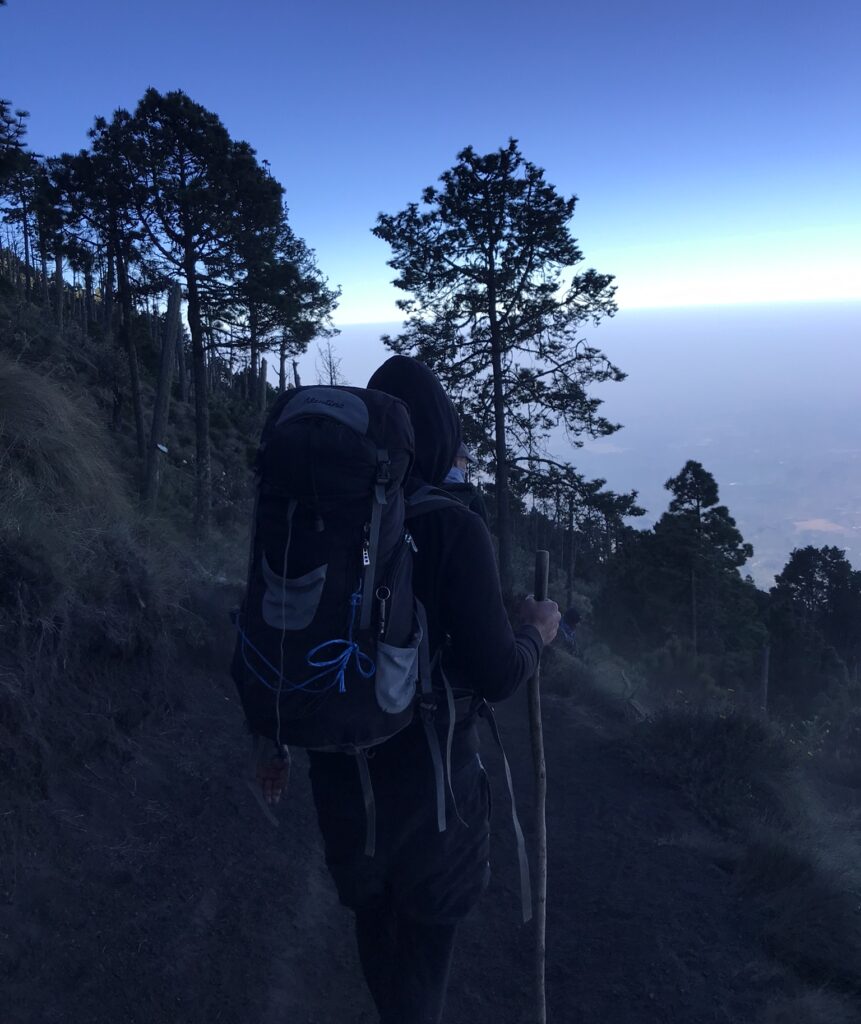
The volcanic shale ground makes things tricky on the descent
Make sure you bring along a bandana or face covering as clouds of volcanic ash are released every time the loose shale shifts. We didn’t and by the end of the trek down we were absolutely covered in grey dust and we couldn’t help but think about the potential damage to our lungs from inhaling all the volcanic dust.
Groups summit Acatenango to witness the regular and turbulent eruptions of the sister-volcano, Fuego. Fuego erupts with steam, missiles and lava every 20 minutes or so, so if it’s a clear day you’re guaranteed to see an eruption. Overnight you can see glowing lava being spewed from the crater of Fuego and actually feel the ground quaking with every strong eruption.
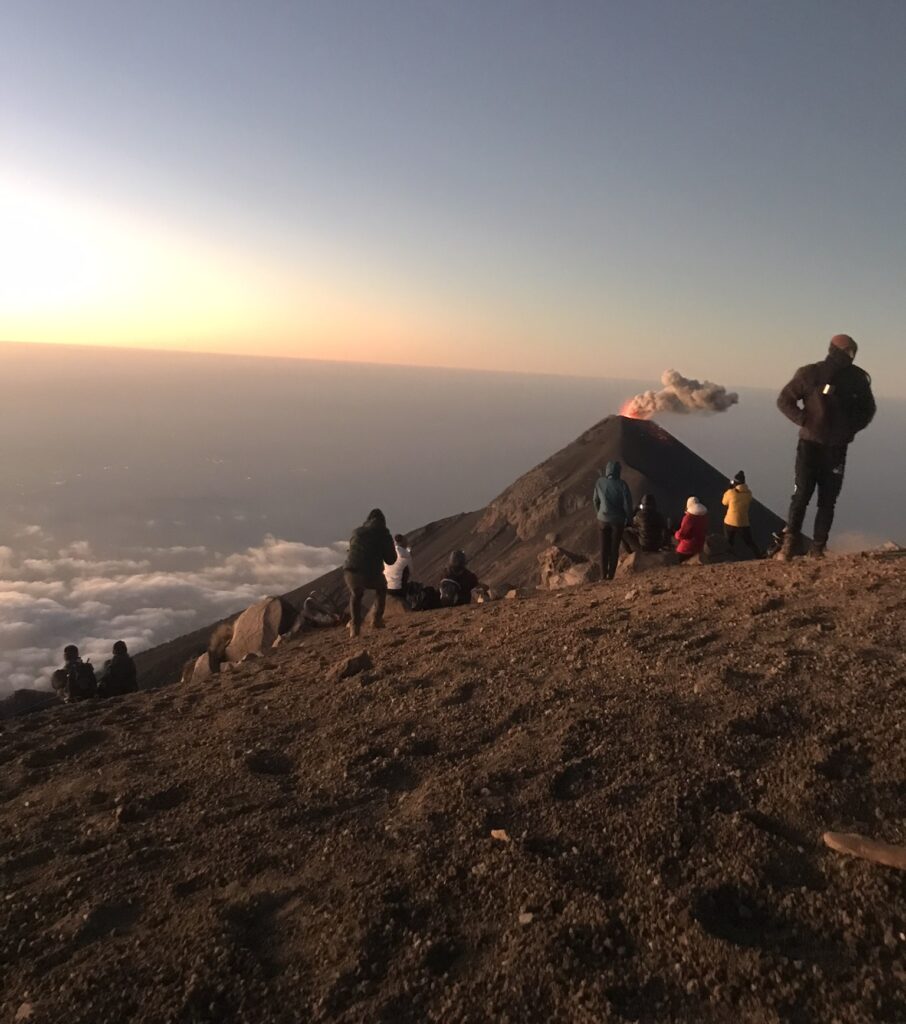
Fuego erupts every couple of minutes
Some tour companies have their base camp on the west side of Acatanago and others on the east side. We ended up camping on the west side, the best part of this was that we witnessed the stunning sunset right from our camp. The cloud bank was pretty cool. We were the first ones from our group to make it to the base camp and also to the summit. I guess all the free walking tours paid off.
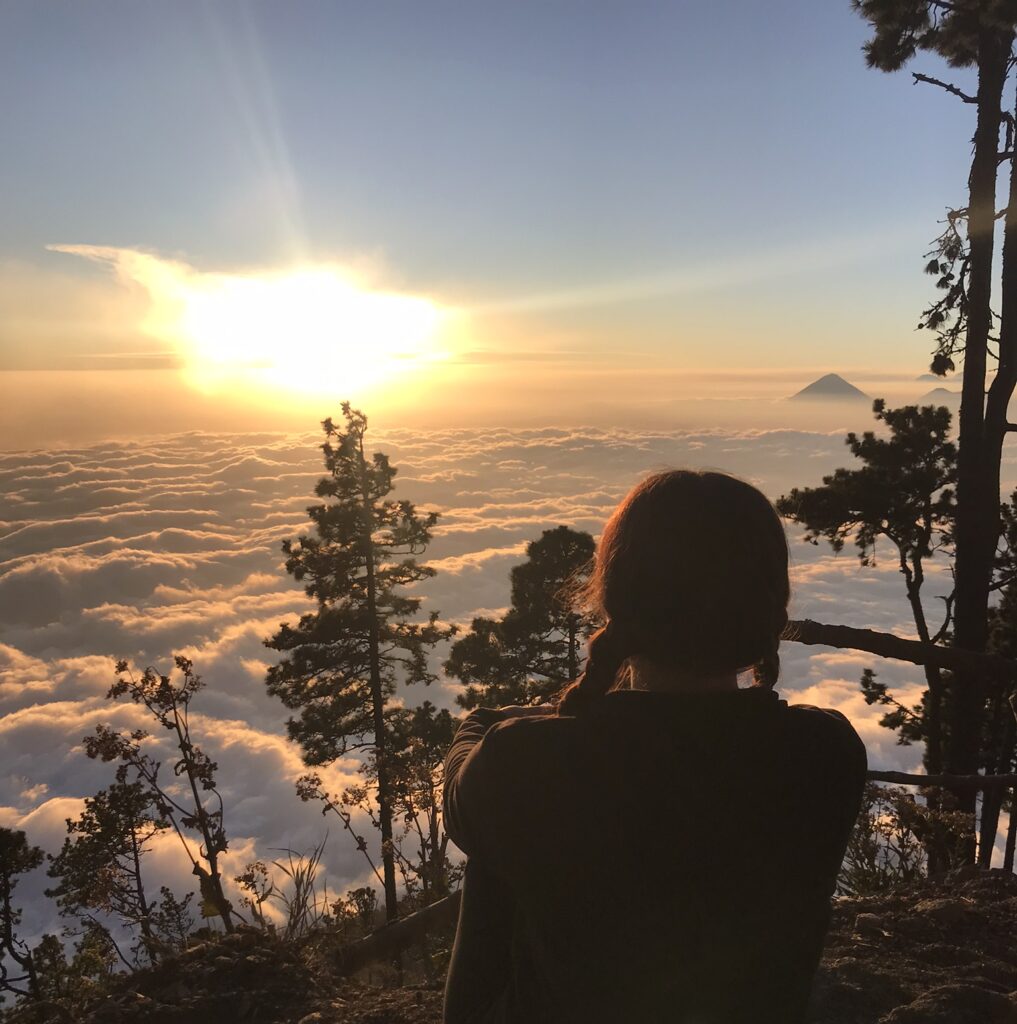
The best sunset view
We slept in tents in what can only be called a large wooden shed. The tents weren’t fantastic as some of the zips were broken but the thick mattresses and sleeping bags were very comfortable. Make sure you bring warm clothes as it gets very cold at the top overnight. The toilets were quite a walk away from the wooden shed which made the trip to the toilet treacherous during the night.
After the hike to the base camp, some brave souls opt to continue on what is termed the ‘Fuego’ walk. We decided not to do this as we were completely wiped after the initial trek. However it’s possible to sign up for this extra hike (4 hours) to get up close and personal with Fuego, to see the lava close up and experience the full force of an eruption. Most of the people in our group who signed up for the Fuego hike didn’t make it to the summit the following morning. I would say it’s probably not worth the extra cost for the Fuego hike based on that, unless you are really super fit and confident that you will be able to do both.
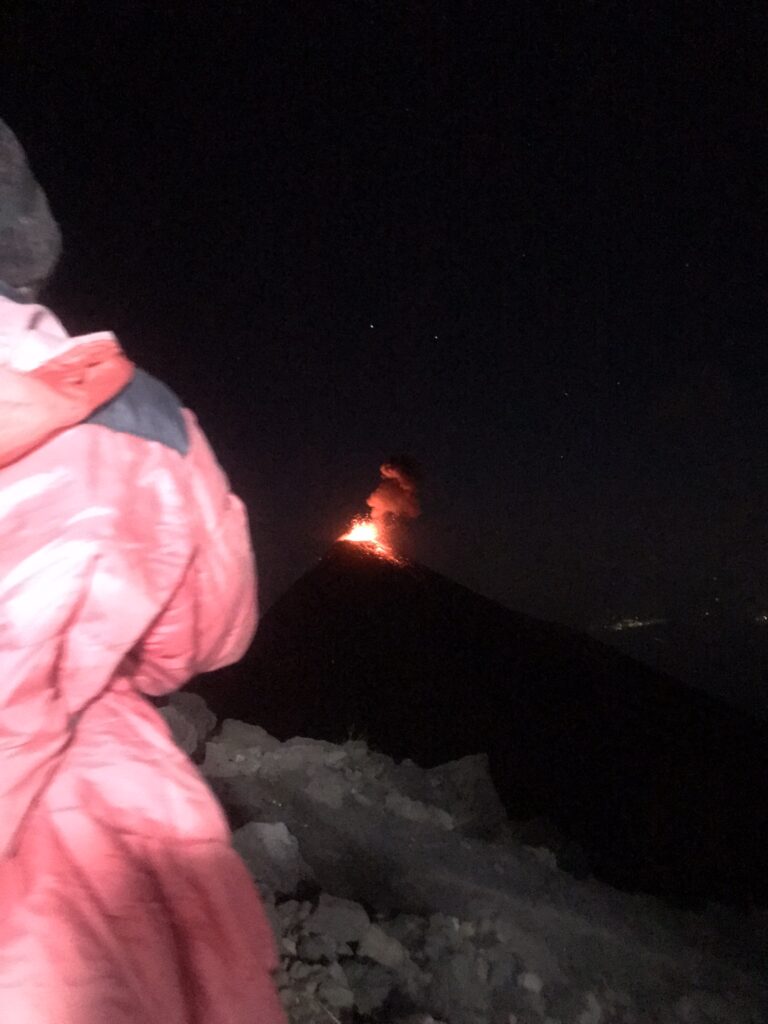
It was pretty wild to see the lava in the dark
After very little sleep we dragged ourselves to the summit of Acatantenango for sunrise the following morning. This was another difficult and steep trek gaining a few hundred more metres in altitude, especially difficult so early in the morning. After that we headed all the way down. The beer at the end was particularly satisfying. Bring a reliable bag with you as mine broke in the first hour of the trek and I had to use string to tie it up. What a nightmare.
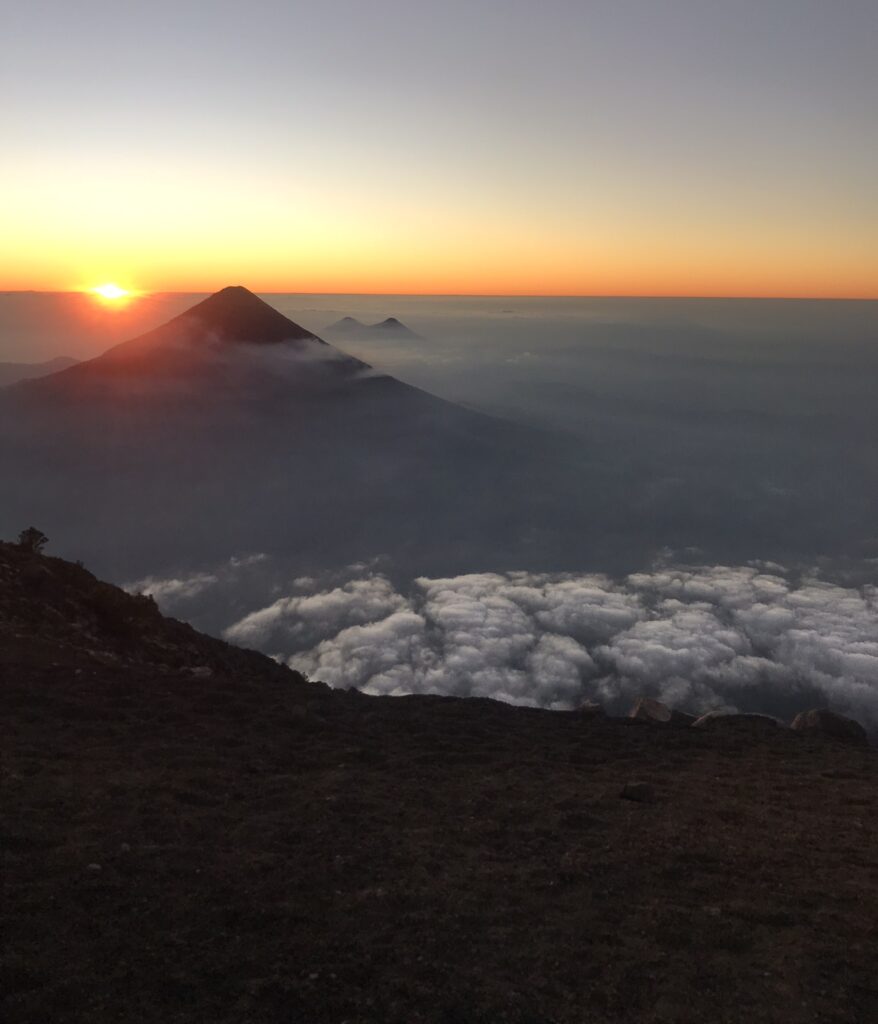
Sunrise at the summit
With so many people making the hike to the summit of Acatanango, litter is a real issue. It’s obvious from looking around that other tourists don’t take their rubbish back with them. Soy Tours encourages all participants to take their litter back with them as there’s nowhere to get rid of waste on the volcano. Bring some snacks with you, we didn’t really eat many snacks because the meals were so hearty but it’s worth having. You also need to bring your own supply of water (several litres per person) and carry it up the volcano with you. This definitely makes it harder on the way up!
It’s not guaranteed that you’ll see Fuego very well as sometimes it can be cloudy. We’ve heard stories that some trekkers reached base camp only to find that Fuego was covered in clouds and they didn’t get a clear view of the volcano or eruptions. It’s a game of chance really and we were very lucky.
Guatemala City
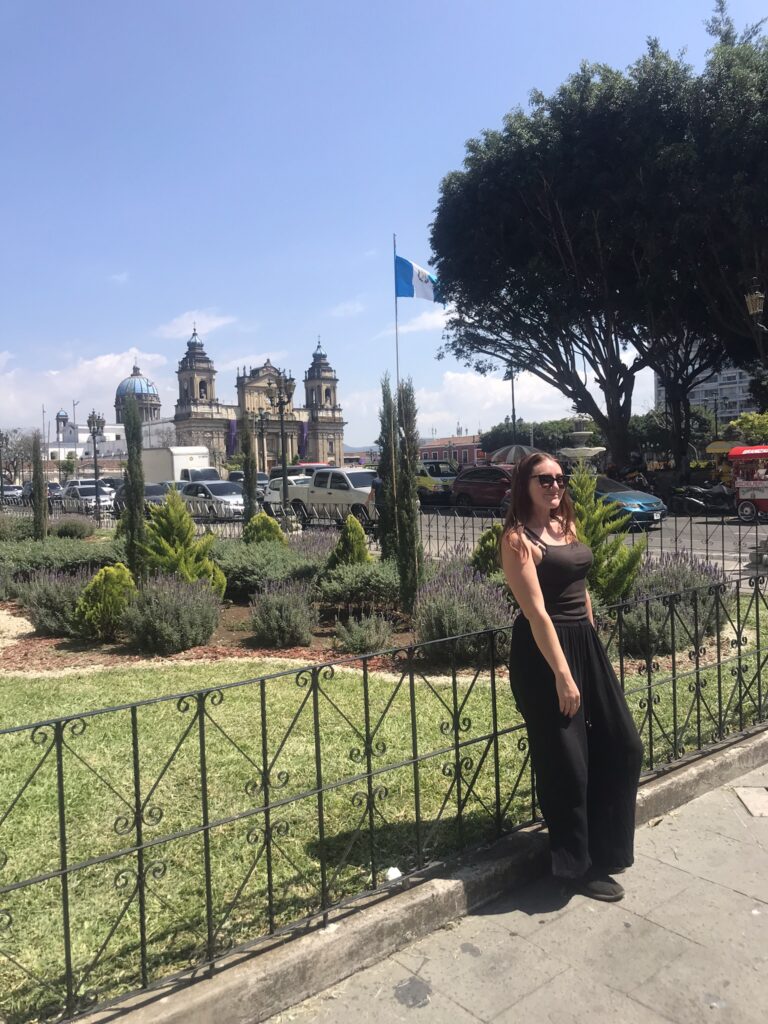
Referred to as just ‘Guatemala’ by locals, the capital is by far the most built up and urbanised city in the country with huge boulevards, modern buildings and skyscrapers. However despite its outwardly prosperous appearance, many parts of Guatemala City are considered unsafe and due to the city’s reputation it receives relatively few tourists compared to the rest of the country. We found that at least some parts of the city were ok to walk around and visit, it wasn’t the absolute sketchiest place we visited in Central America although I probably wouldn’t recommend an extended stay for most people.
Like many Central American capitals, Guatemala City is full of large, modern malls. Malls are a safe haven for rich Guatemalans, they have security on the door and many upmarket shops and amenities. We got a chicken bus from Antigua and jumped out at a mall on the outskirts of town, taking an Uber the rest of the way to our accommodation. Uber is the best, easiest and safest way to get around the city.
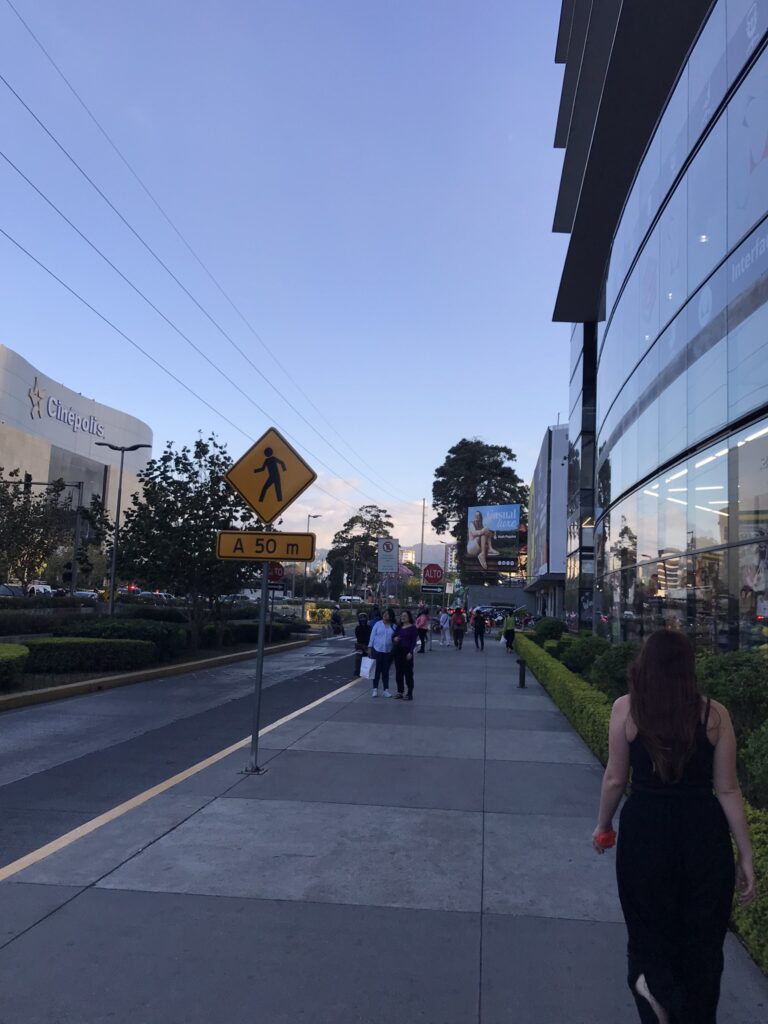
Parts of the city are full of malls and modern buildings
The centre of Guatemala City (Zone 1) contains most of what would be considered to be the city’s tourist attractions. The main square, Plaza de la Constitución, was sprinkled with a few dodgy characters and smelt like urine in places but felt safe enough as there was a roving police presence in the area. The square contains landmarks such as the government buildings, Cathedral and Palace of Culture. Just off the main square, La Sexta is also a safe and lively street to walk down freely, with many cafes and shops. We saw people dancing to music in the street. La Sexta also contains attractions such as the San Francisco church as well as the Post Office palace and Police palace, grand buildings which were commissioned by Guatemala’s former dictator Jorge Ubico.

Zone 1 is home to several grand palaces
We decided to stay in Zone 10 close to Oakland and found that the area was safe with more affluent residences. Most of the houses on our street looked like mini-fortresses with high external walls to prevent intruders and protect the occupants. We felt comfortable walking around the area after dark and saw locals chatting on the phone in public and moving about freely, which made us feel more at ease.
Accommodation
It’s important to do some research before booking somewhere to stay in Guatemala City. Some zones are considered dangerous or no-go areas for tourists so it’s best to avoid these places.
Casa 10 Guest house on Booking.com – a great place to stay if you’re looking for a safe and secluded spot. There are only a couple of rooms off the main kitchen area. We didn’t see anyone else staying at the property which was ideal. The property feels secure with an outside gate.
Foodie Places
Little Caesars Pizza – on our first night we decided to get a takeaway to avoid walking around the streets at night or getting a taxi to a restaurant. This worked out well. For some reason Little Caesars is everywhere in this part of Central America.
Go Green – shared space with Café Gitane • Centro Histórico, serving salads, wraps and sandwiches. A great place to get lunch if you’re craving something healthy. It’s sometimes difficult to find healthy options when travelling but Go Green was a fantastic choice. We also treated ourselves to a slushy iced latte from Cafe Gitane, which was refreshing and the perfect accompaniment to the salad on a warm day.
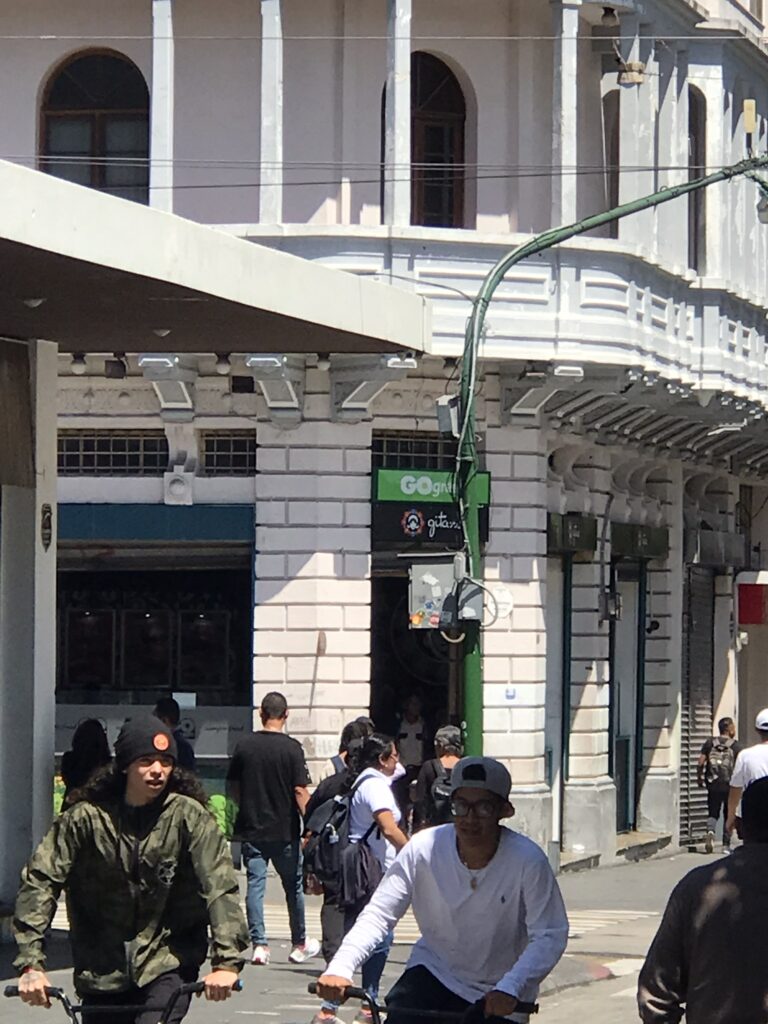
Go Green located on La Sexta, a busy and relatively safe walking street
Activities
Guruwalk walking tour with a very odd man – we’d made sure to be in the city especially for this Guruwalk as the guide was supposed to be a local history teacher, instead we ended up with a stand-in guide who was definitely an interesting character to put it mildly. He was an elderly Guatemalan who told us he’d shot a man in the US and been deported back to Guatemala. It was a very peculiar tour. Apparently the original guide wasn’t available. Stops on the tour included: Plaza de la Constitución, Palacio Nacional de la Cultura, Catedral Metropolitana de Santiago de Guatemala, Mercado Central (good place for shop for souvenirs), Pasaje Rubio (an old-style pub pub featuring some pretty cool photos of Che Guevara in El Portal Bar and Restaurant), La Sexta (safe shopping street), Iglesia San Francisco, Post and Telegraph Museum (the Guruwalk guide proceeded to manually demonstrate all the various postal instruments even though I don’t think it was allowed to touch the displays!).
Palacio Nacional de la Cultura – the National Palace, known for some reason as the Palace of Culture, is an extremely grand building that was built by the dictator Ubico to be the headquarters of the President of Guatemala. Today, the presidential headquarters are in a building behind the palace and the palace itself is open to the public for tours.
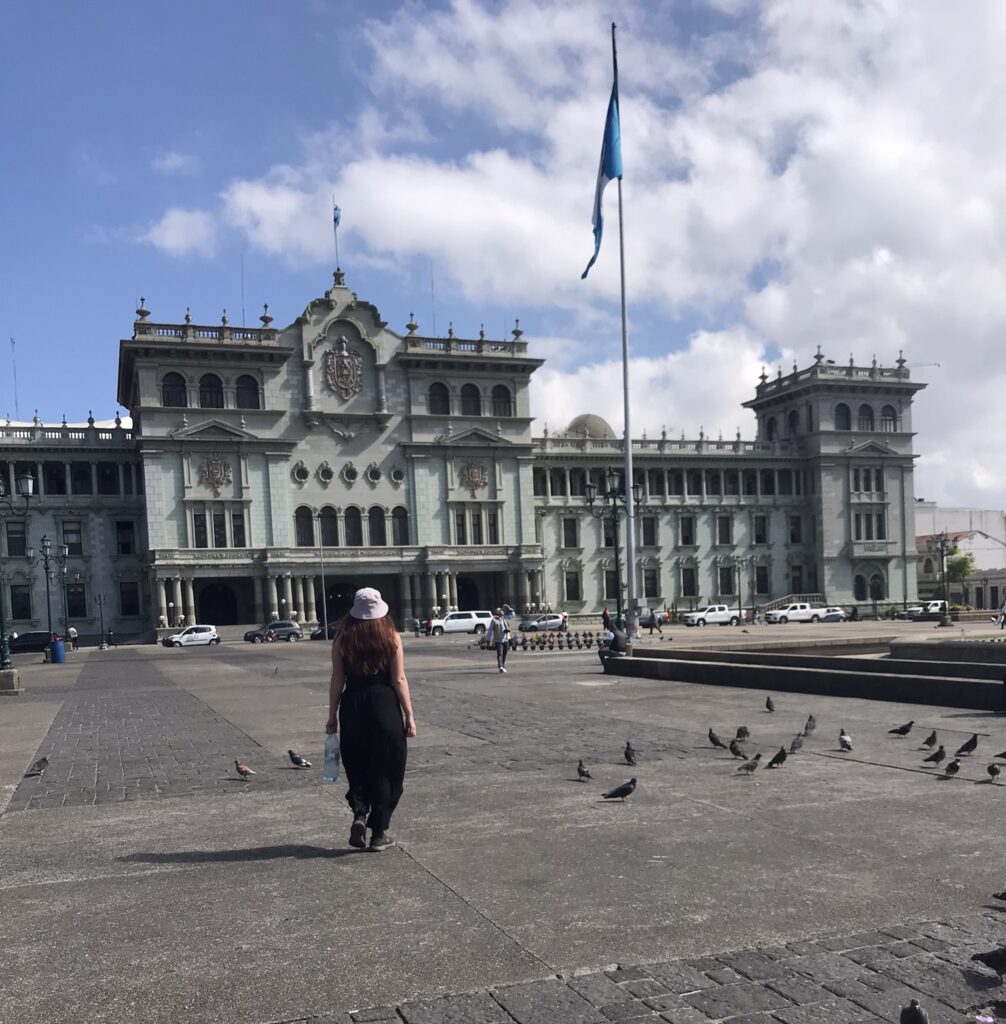
The palace is the focal point of the main square
You have to book a slot online using the palace’s booking system before entering. The palace has free public wifi so you can just book a slot outside when you arrive. Only guided tours are allowed around the Palace as it still functions as a seat of government. We saw important-looking ministers walking in and out and, randomly, a marimba concert taking place in the courtyard area. We were especially entranced by a marimba version of the Super Mario theme tune that was being played.
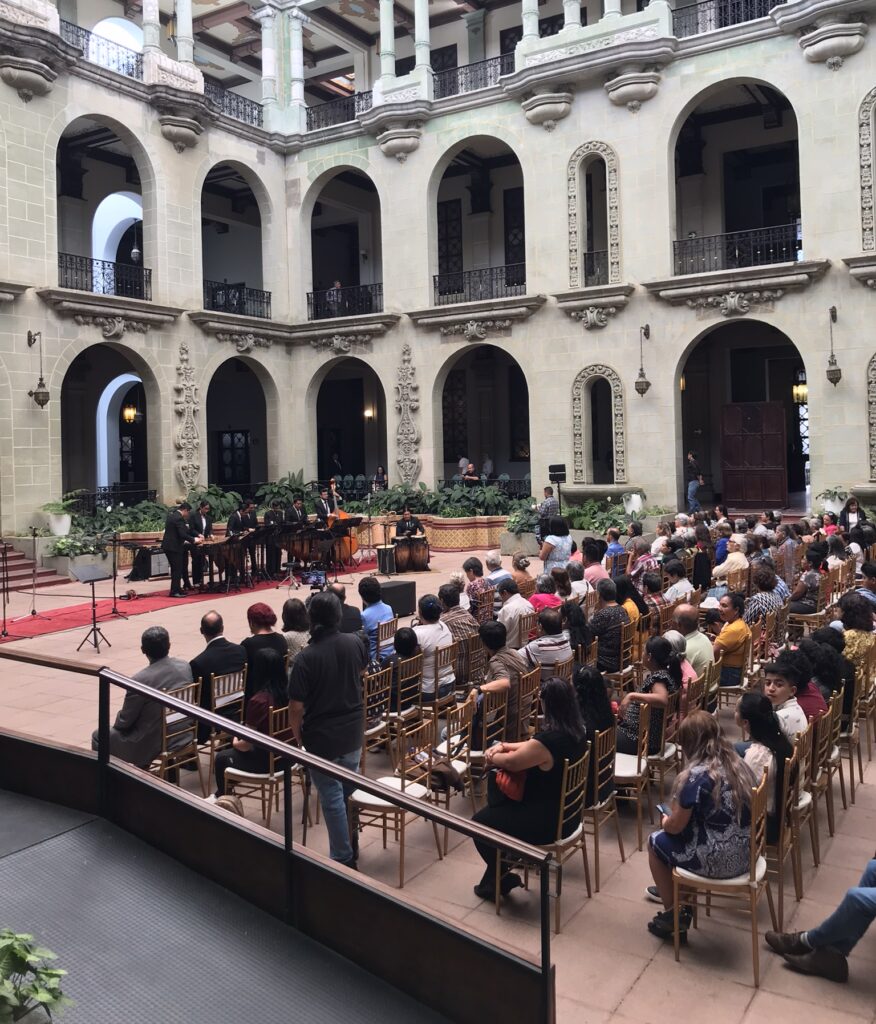
This concert was great!
There was some confusion among the palace guards and staff about the times of the guided tours. After almost joining a Spanish-language tour group we were told at the last minute that there was a tour in English, so we hung around for it. The tour was well worth the wait, the guide spoke very good English, her explanations were in-depth and she invited questions and deeper conversation about history and politics.
The palace contained some very interesting murals on the stairwell documenting the history of Guatemala from the pre-Columbian times through to the incursion of the Spanish. The murals seemed a tad romanticised as they included scenes of a Mayan princess embracing a Spanish conquistador, rose-tinted history if I ever saw it! There were some pretty grand state rooms with expensive-looking chandeliers. Jorge Ubico, the dictator that commissioned the palace, had an imprint of his fingerprint placed on every door handle in the building. This was one of four palaces in the city that were built at the orders of Ubico. The Guatemalans seemed pretty philosophical about the fact that the grandest buildings in the city were built by a crazed dictator.
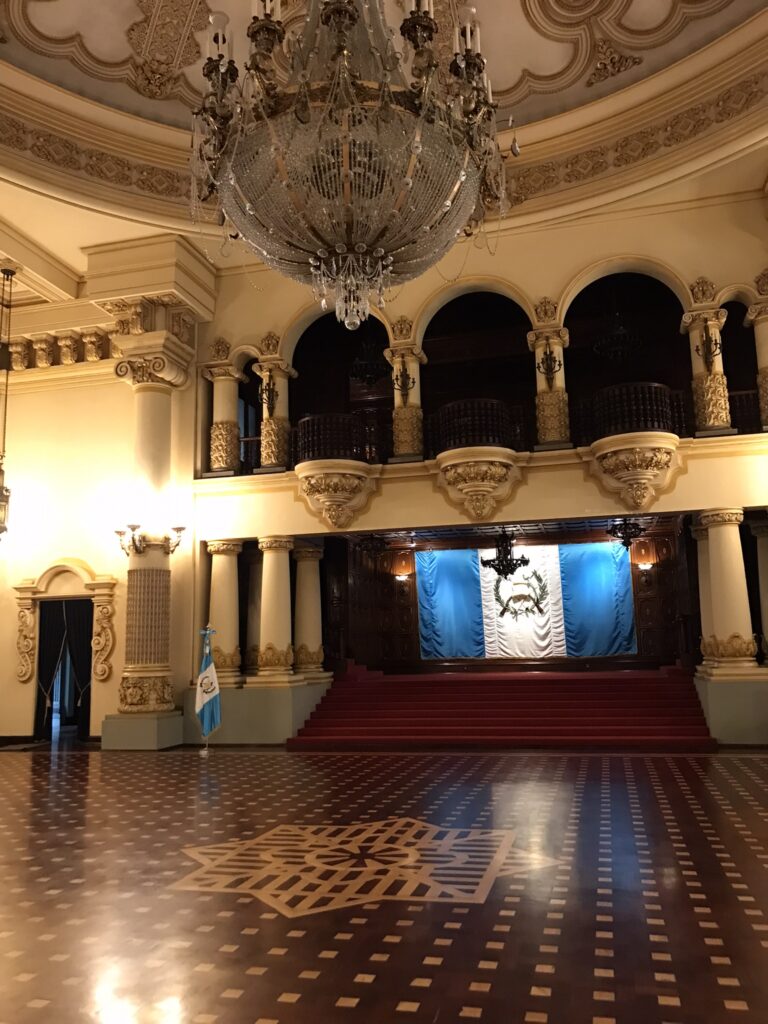
One of the many grandiose state rooms in the palace
After Guatemala, we headed to El Salvador. Read about our border crossing from Guatemala City to Santa Ana in El Salvador here!
